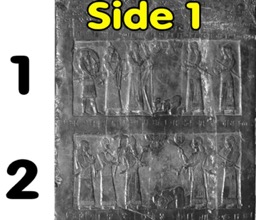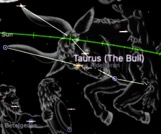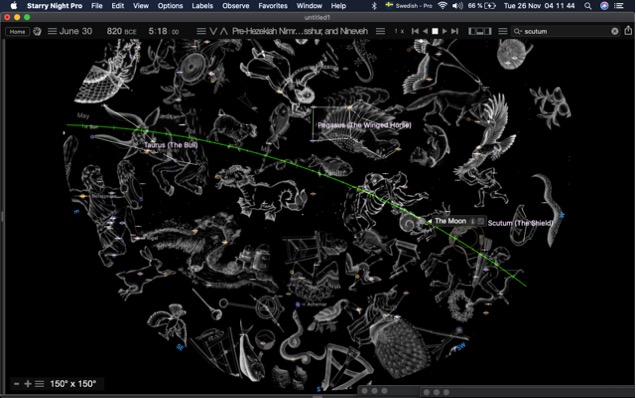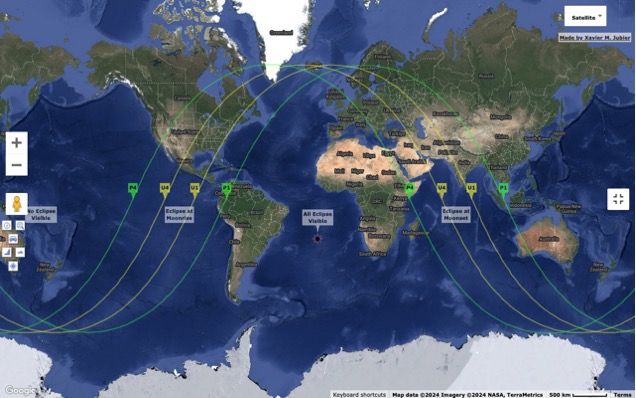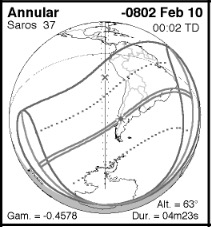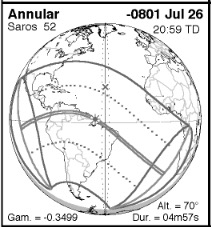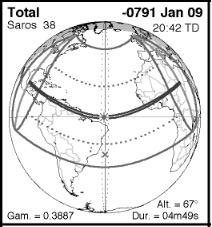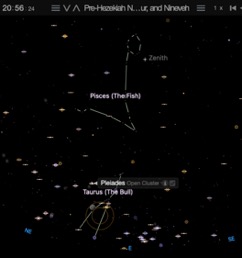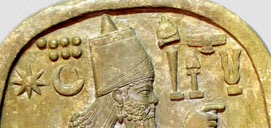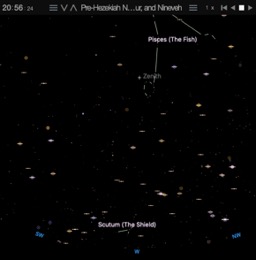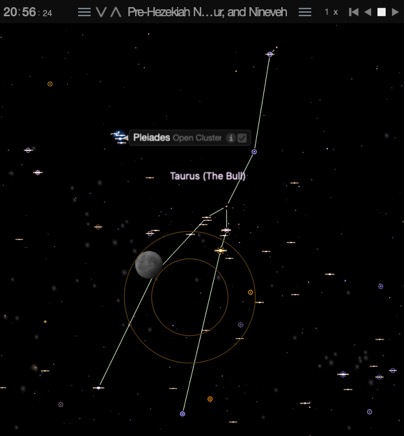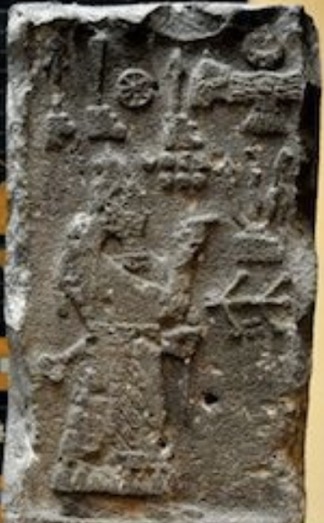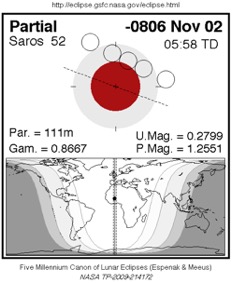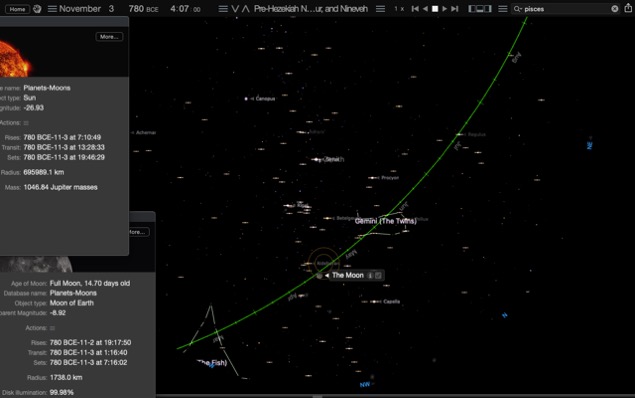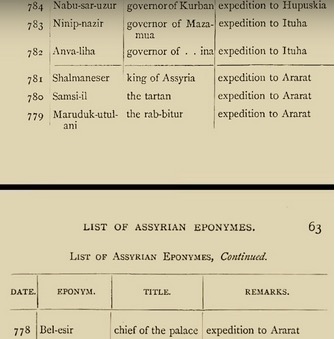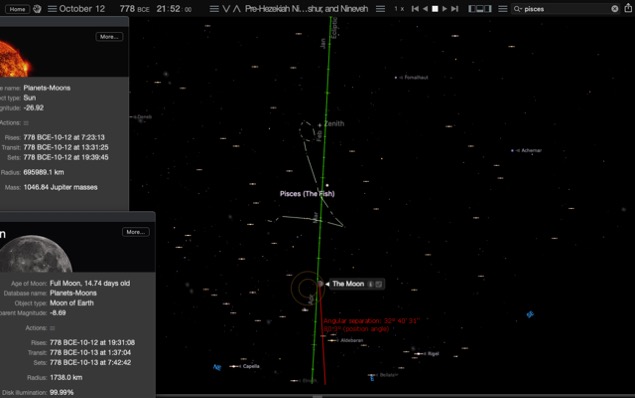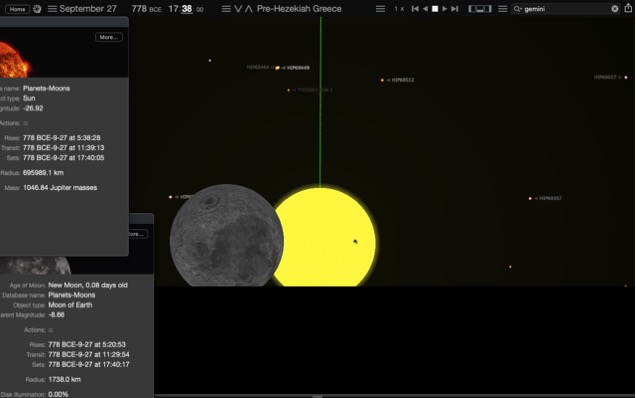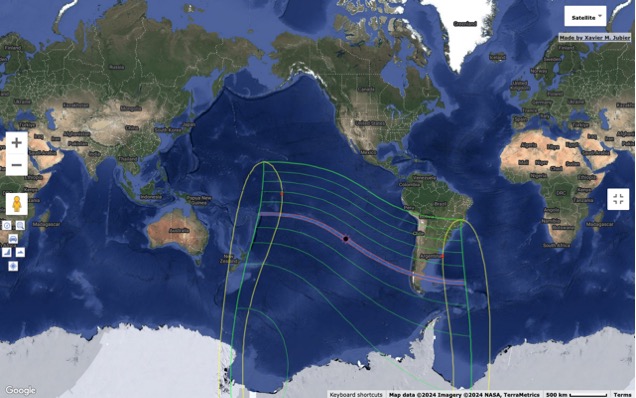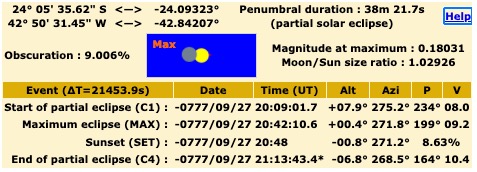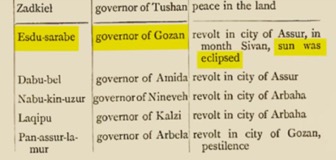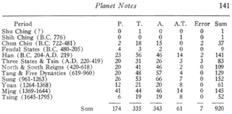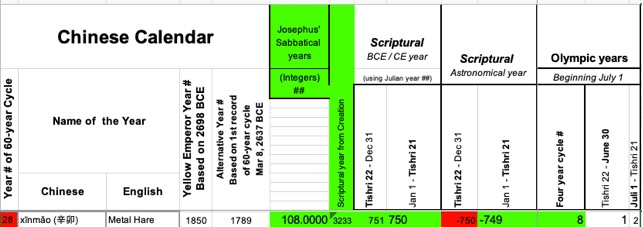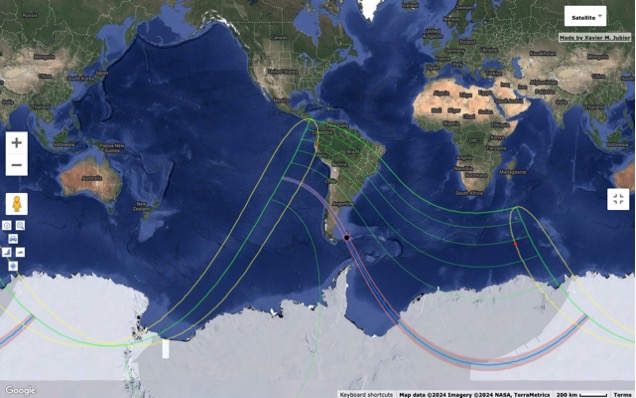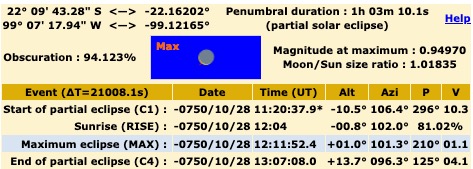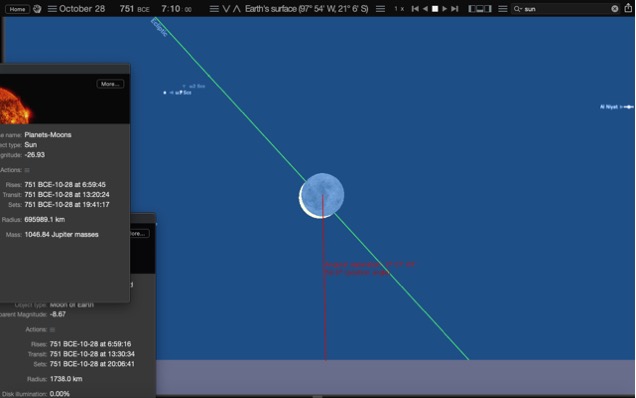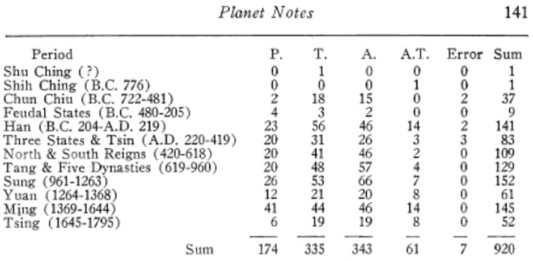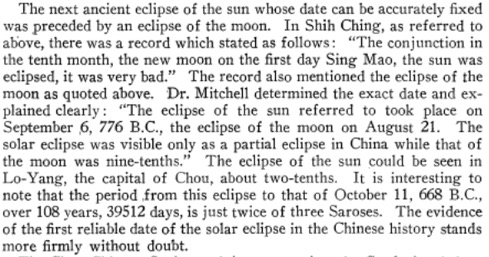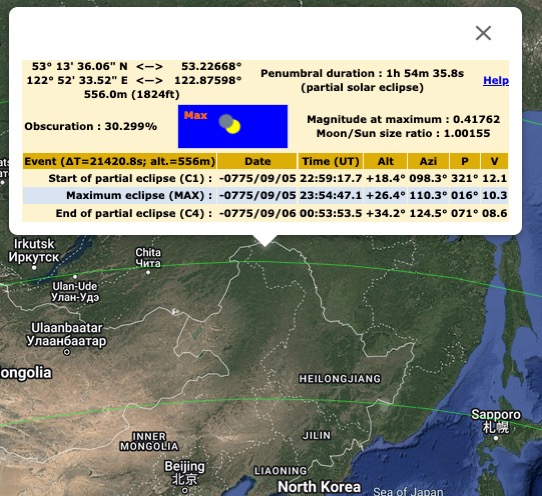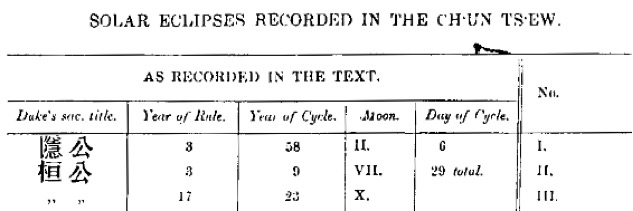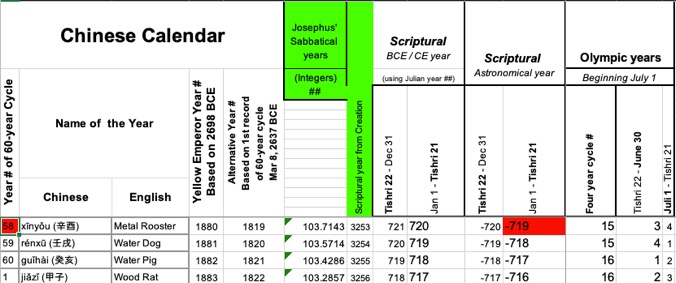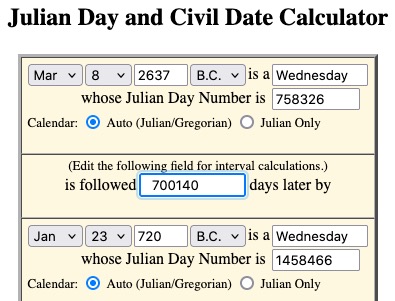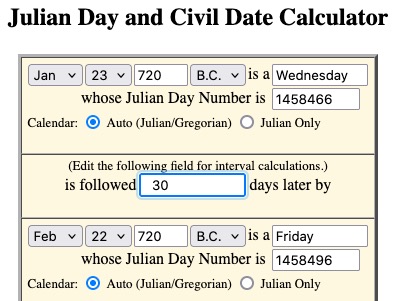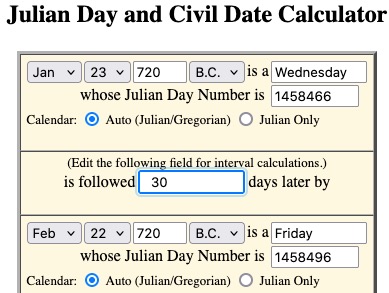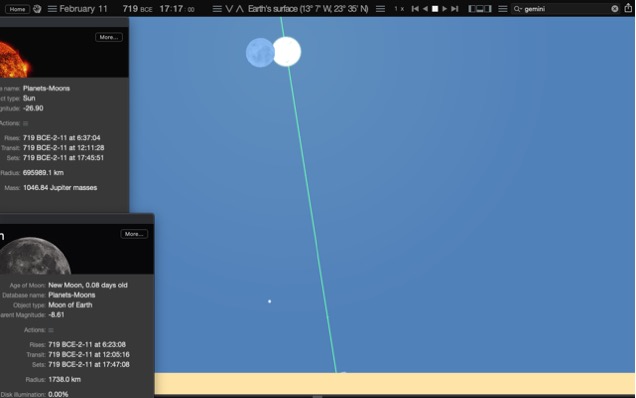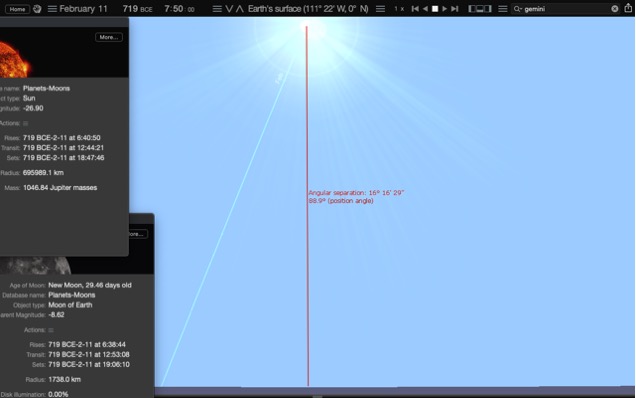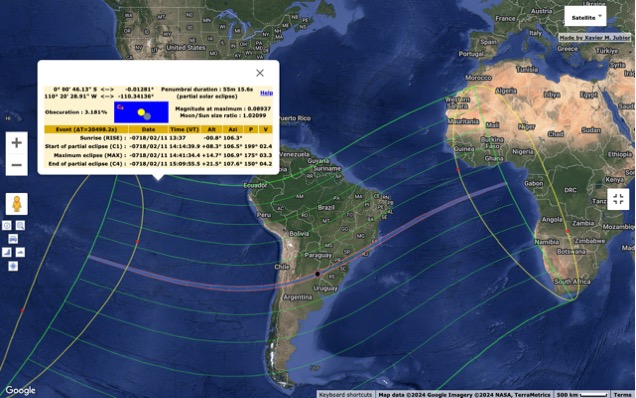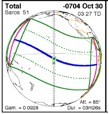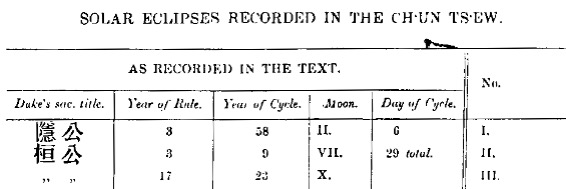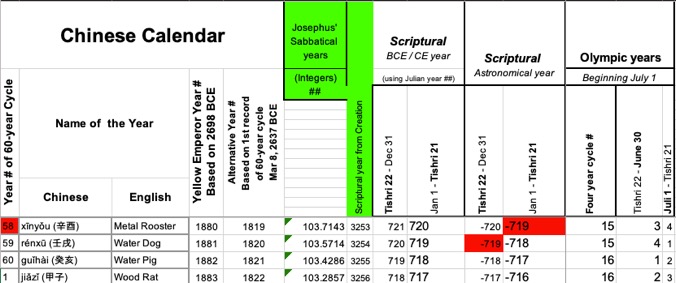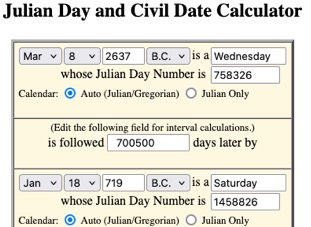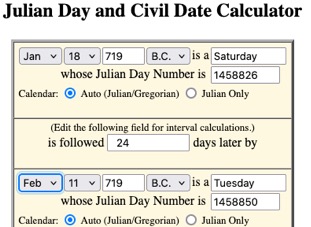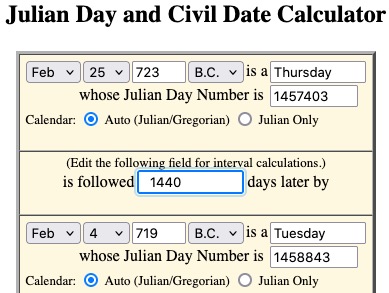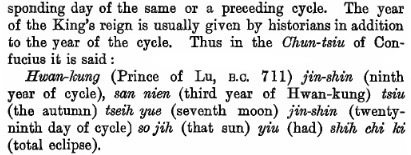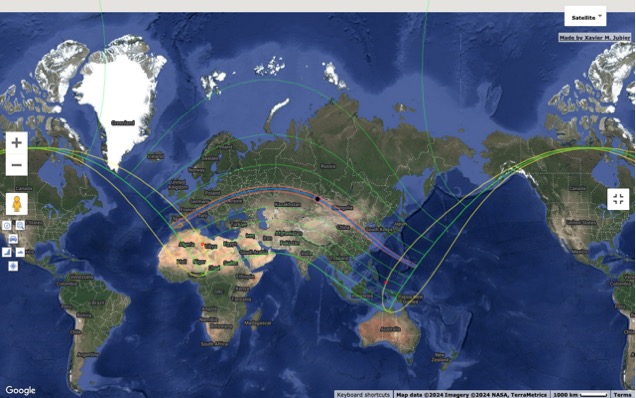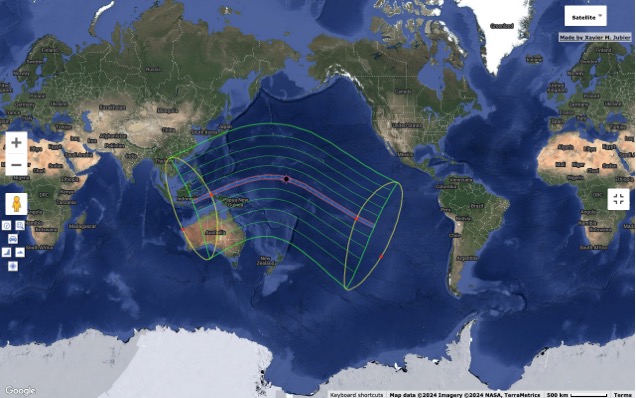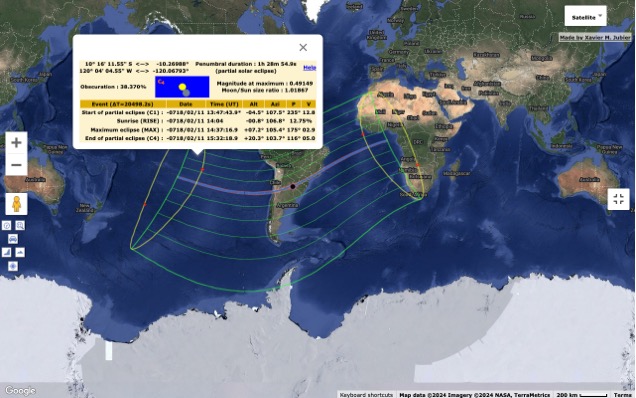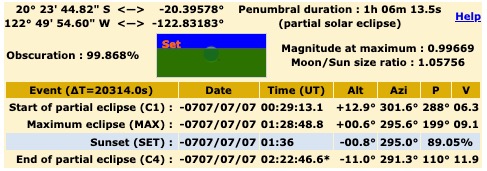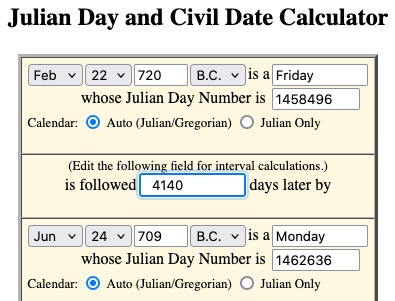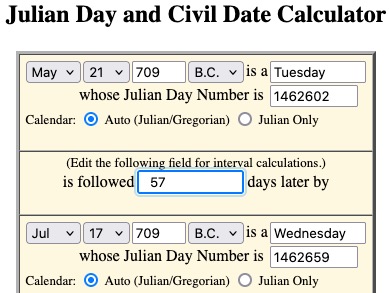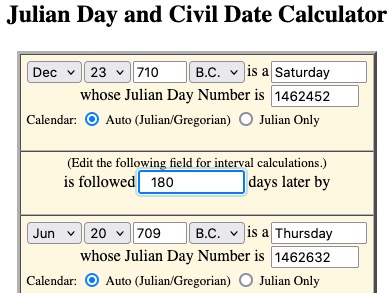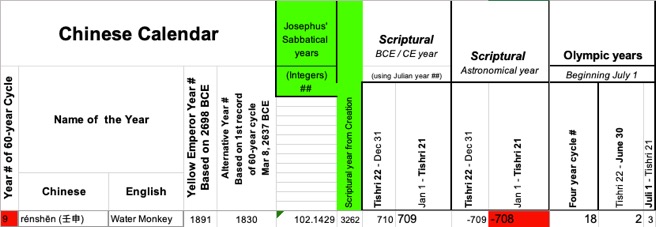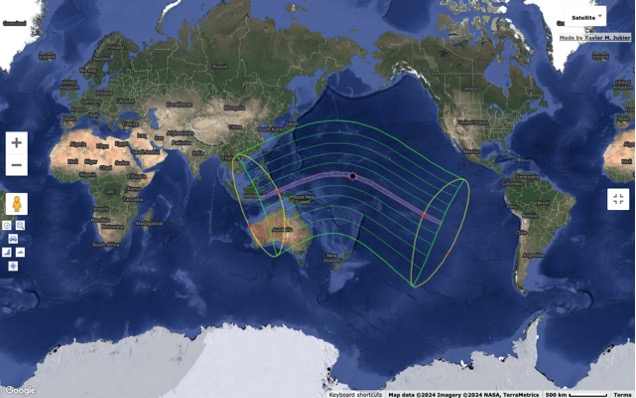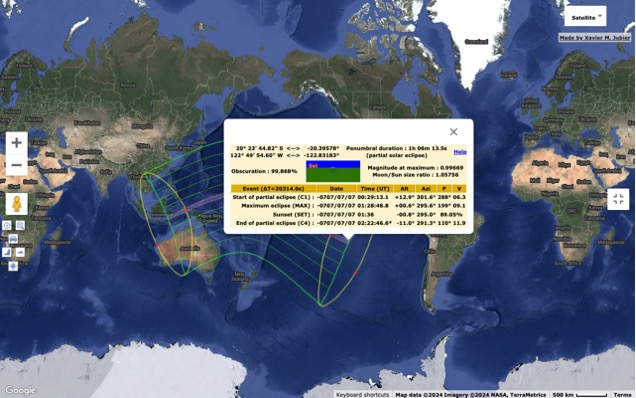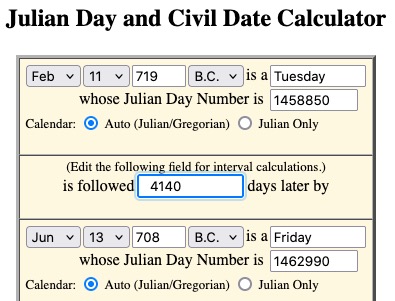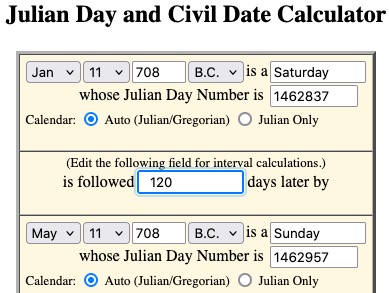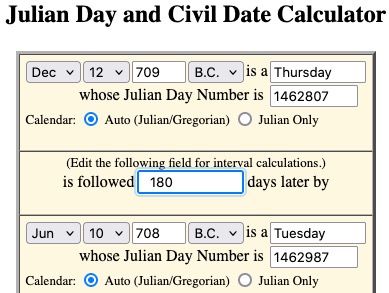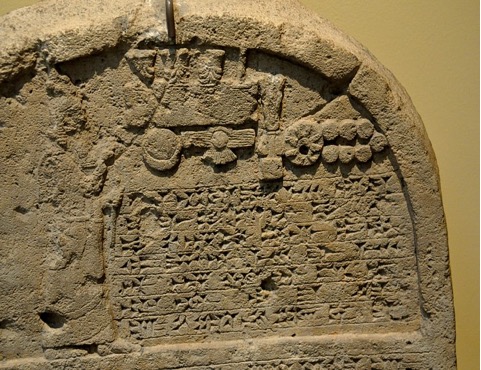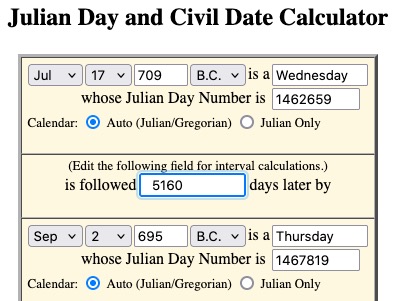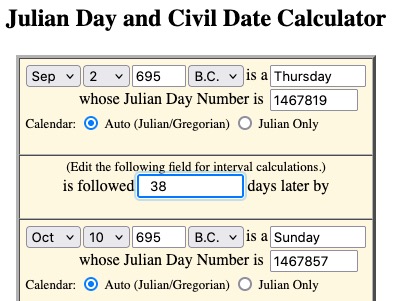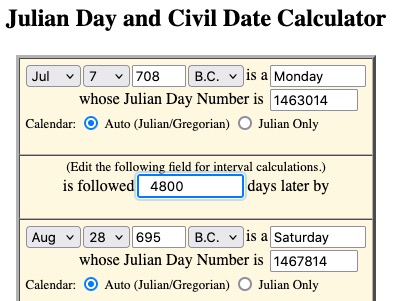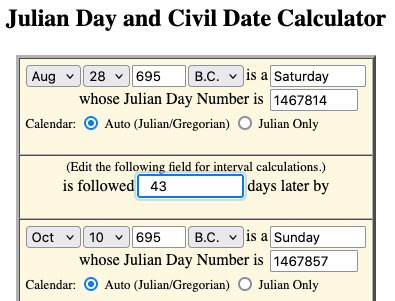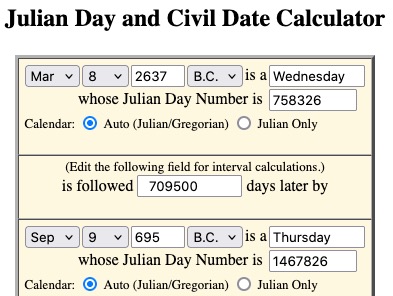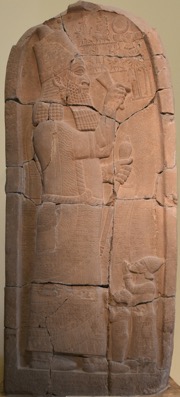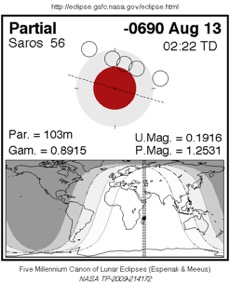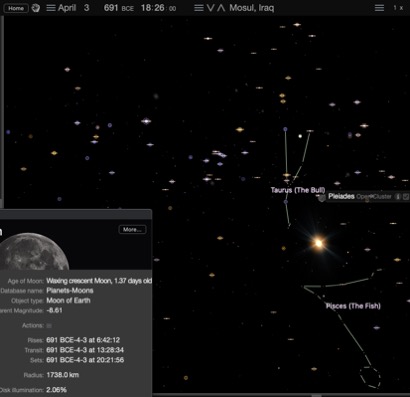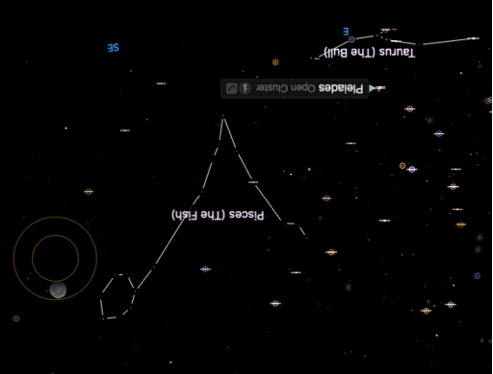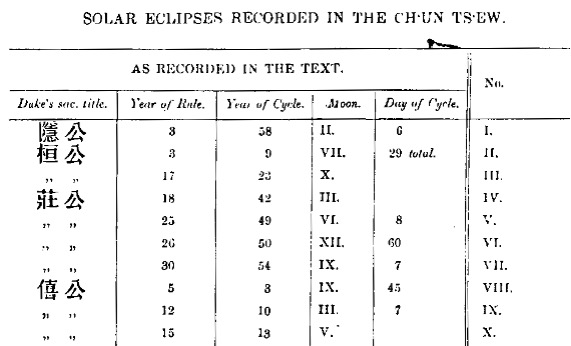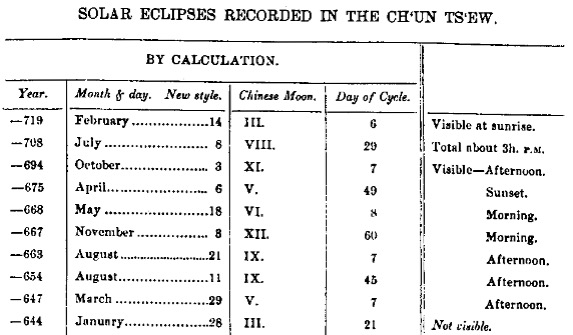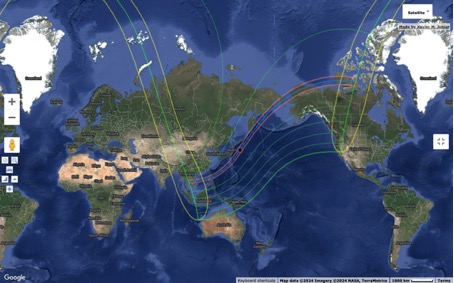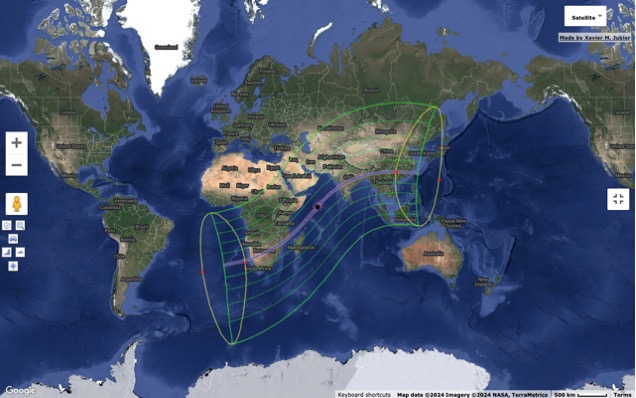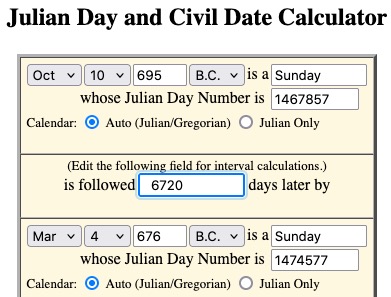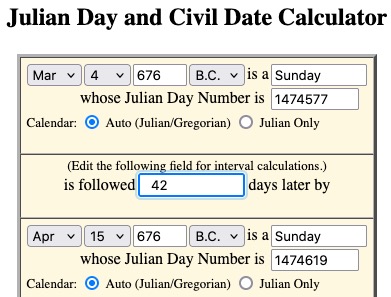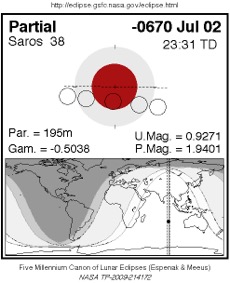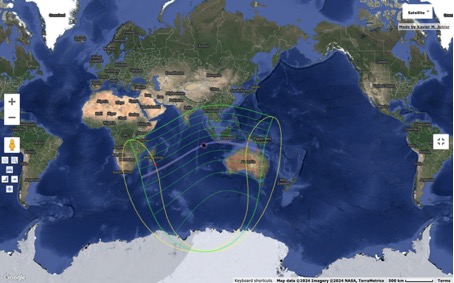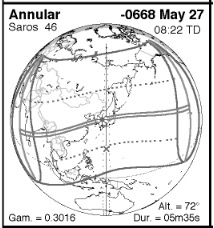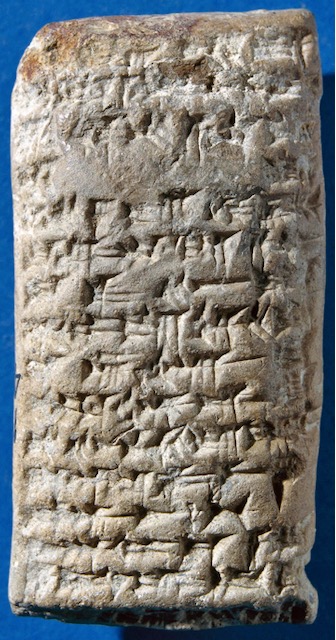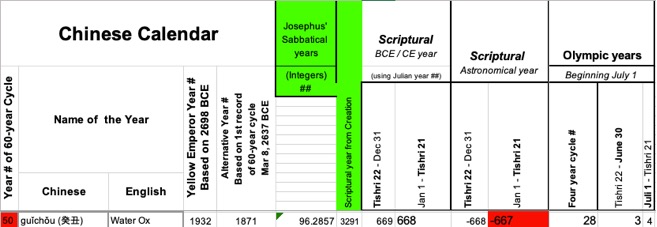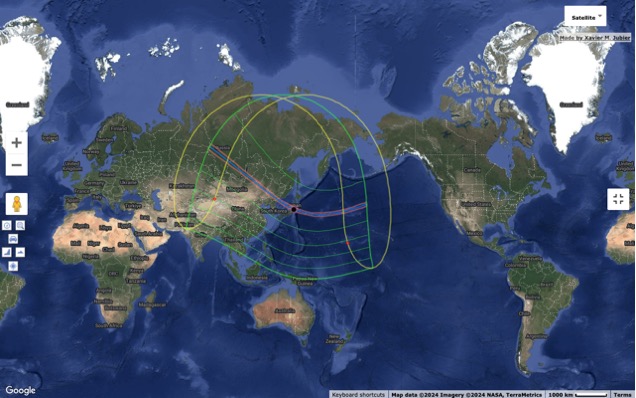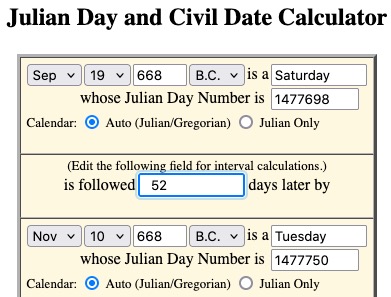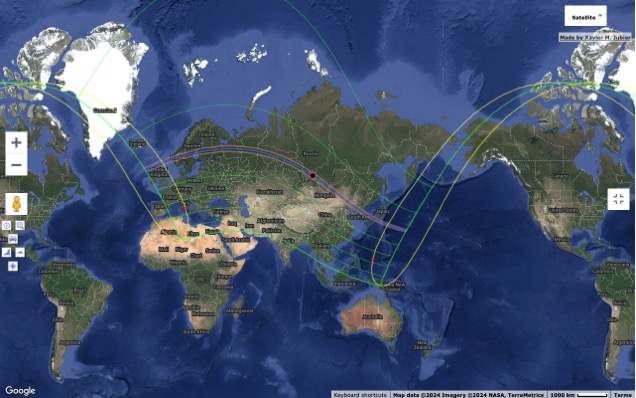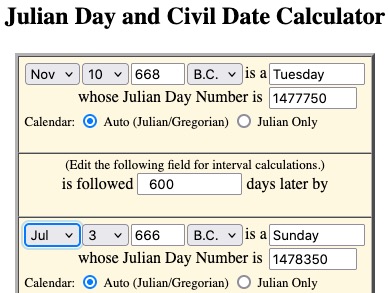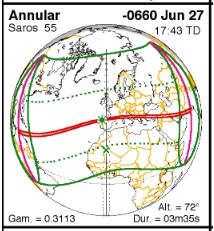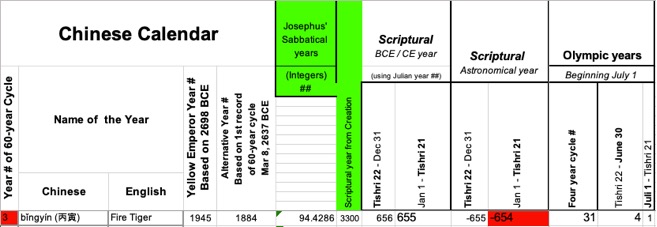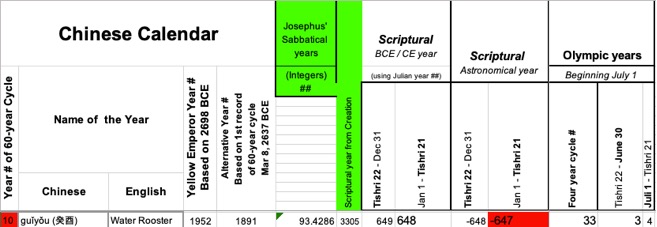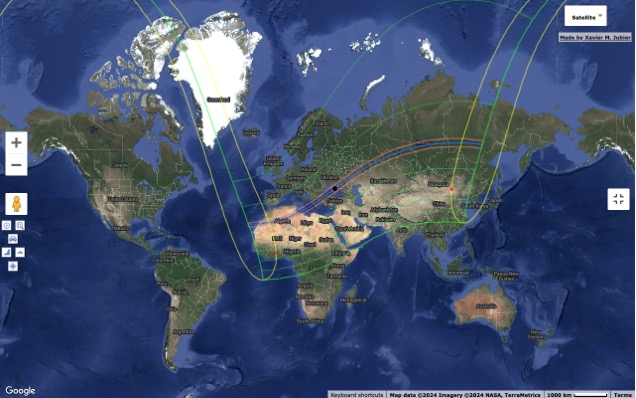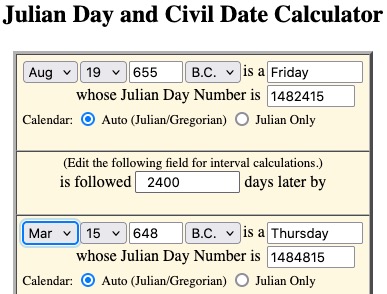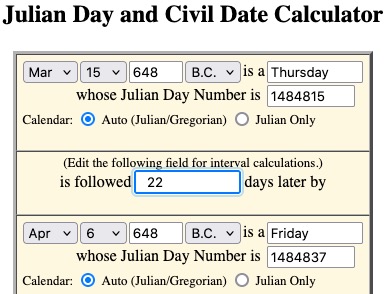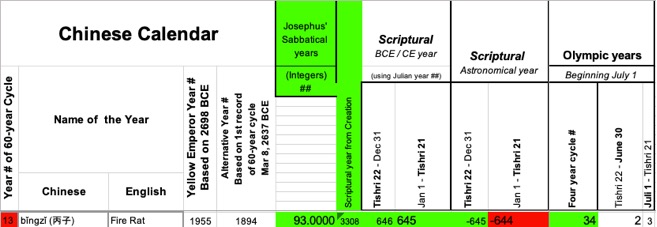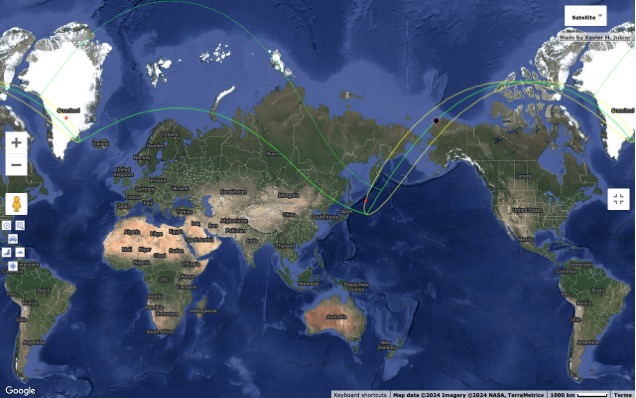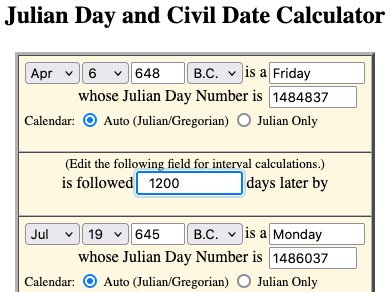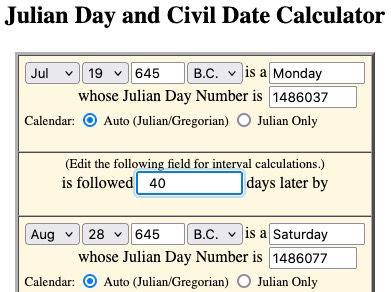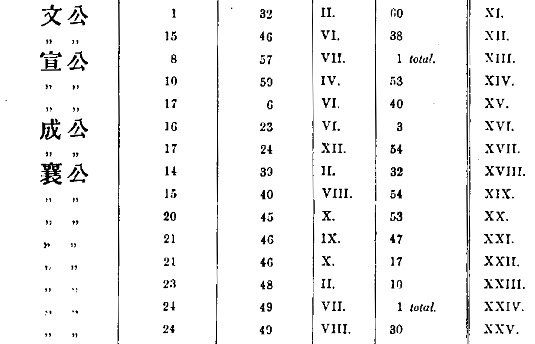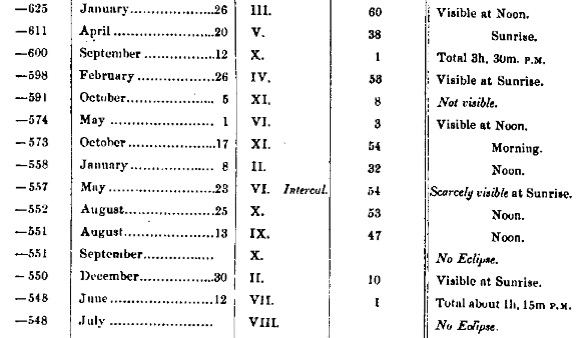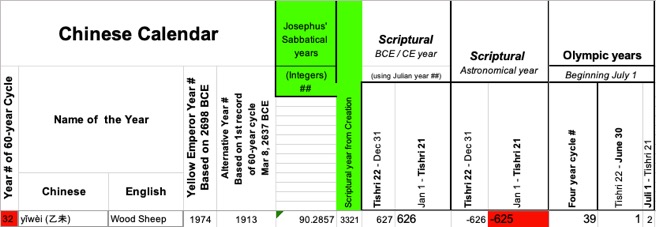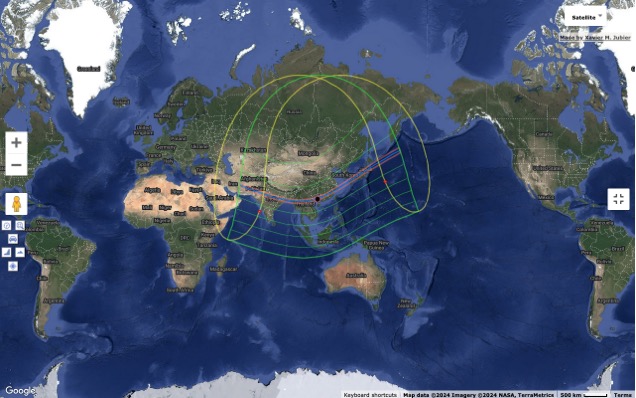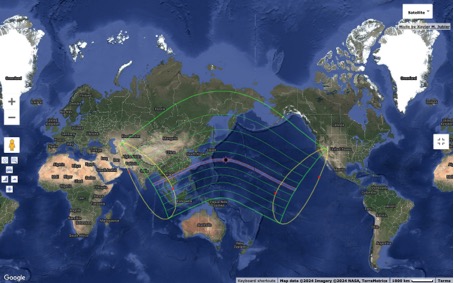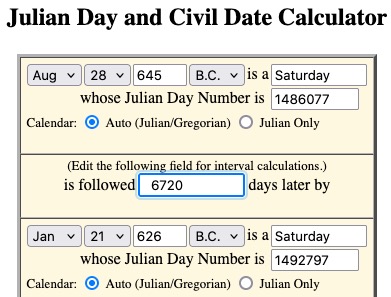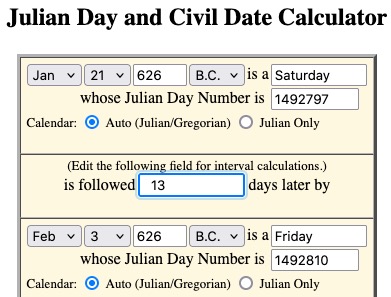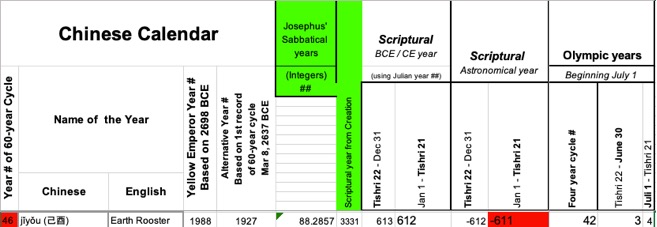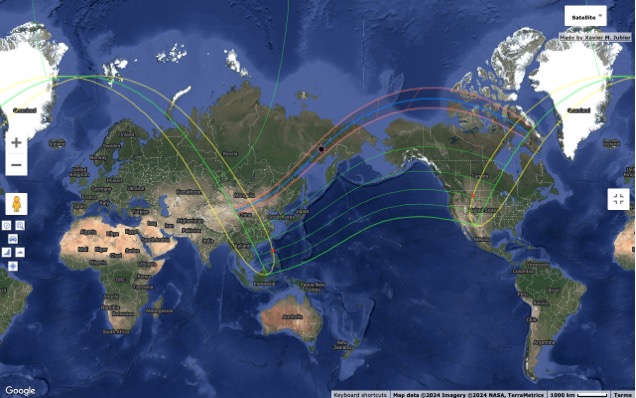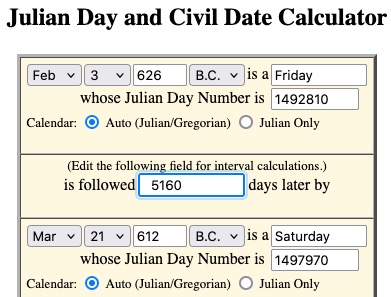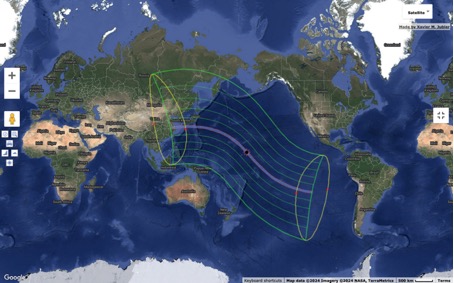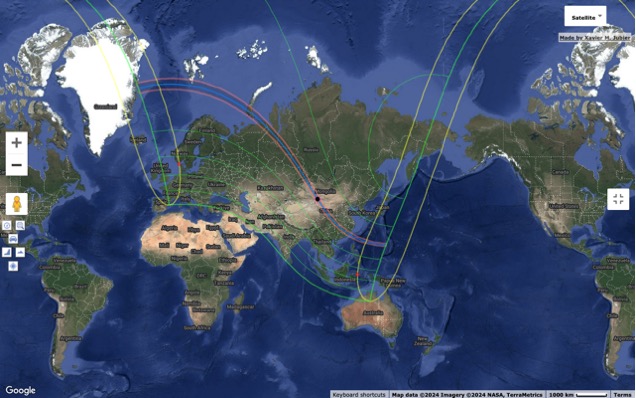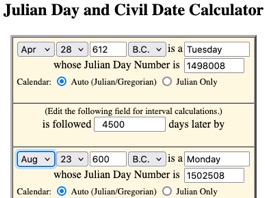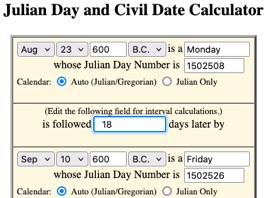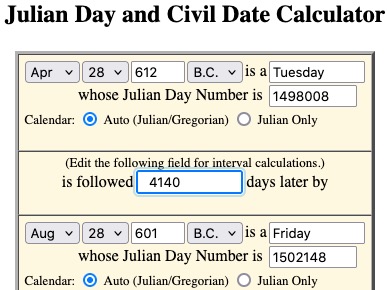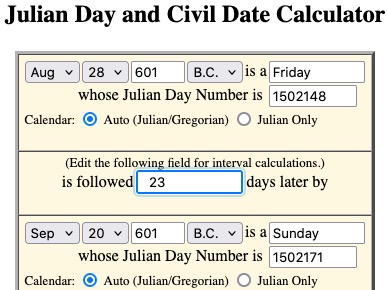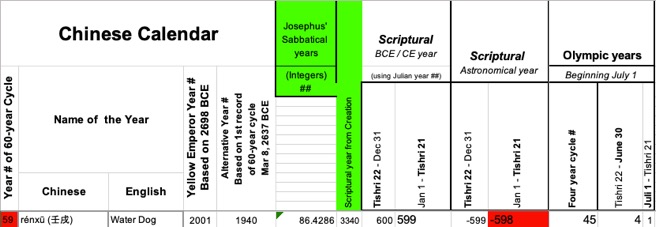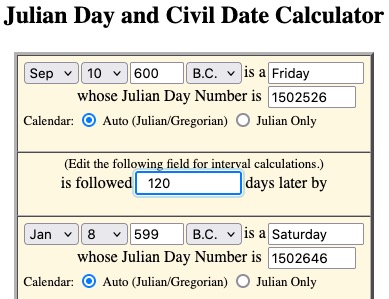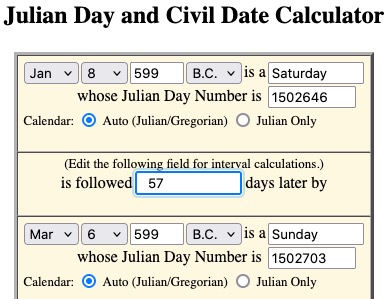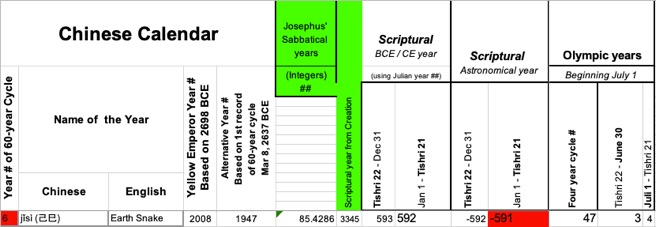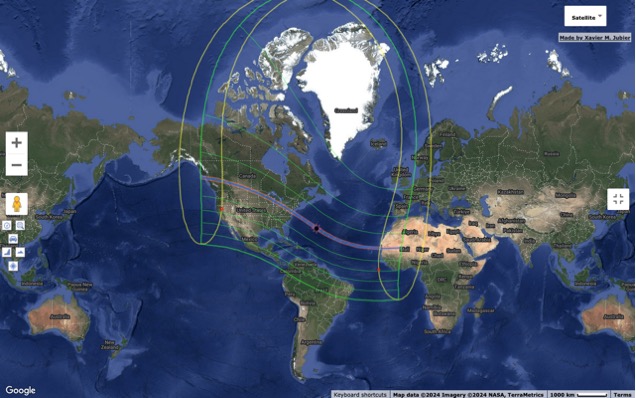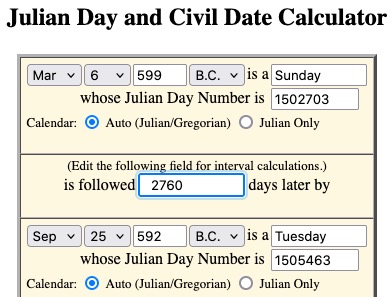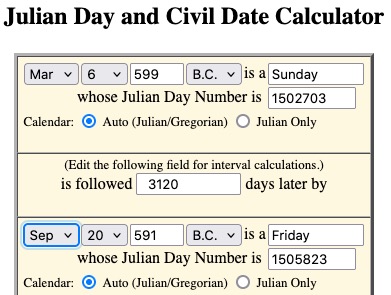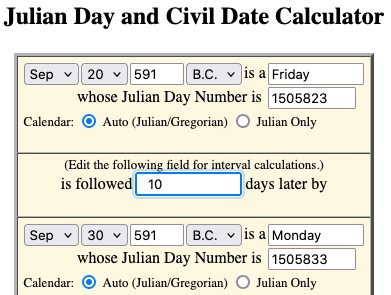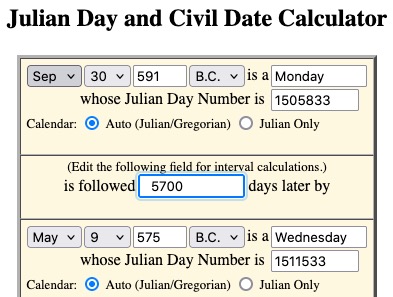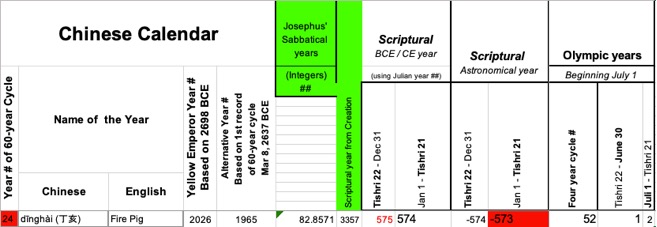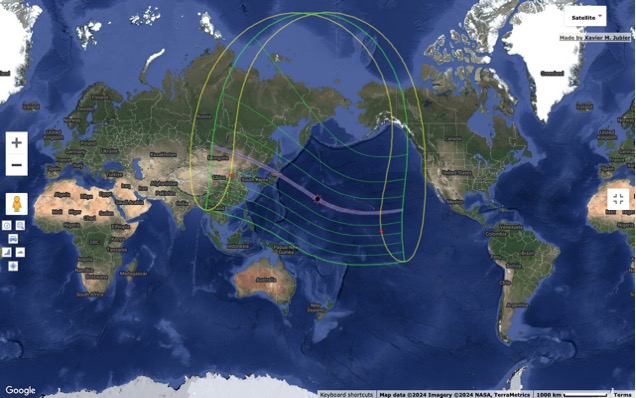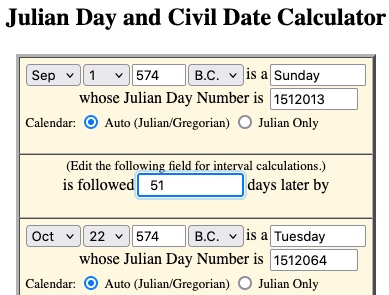Without recourse. All Rights Reserved. Tree of Life©
Statement of belief: “Sanctify
them through thy truth: thy word is truth.”
(John 17:17 KJV)
Updated 5925[(*??*)] 08
27 2029 [2012-12-12]
Updated 5926[(*??*)] 04
07 2030 [2014-07-07]
Edit 5927[(*??*)] 13
16 2031 [2015-04-04] – Adding
a link to view the lunar eclipse of King Saul at En-Dor before the last
pole-shift.
Edit 5938[v2016-12-14-21:32]
04 08 2035 [2019-06-13] – Cf. rows #0 -
#2 of the table below!
Addition 5942[v2016-12-14-21:32] 09 23 2039 [2022-12-18 evening] – Modified the
page title, and added six
quotes to the 1833 Shooting Star Event.
Addition 5942[v2016-12-14-21:32] 09 24 2039 [2022-12-19 evening] – Added an image
to the 1833 Shooting Star Event.
Minor edit 5942[v2016-12-14-21:32] 09 28 2039 [2022-12-29] – Starry Night Download link, and a link
to Professor Silliman’s Journal.
Addition 5942[v2016-12-14-21:32] 01 12 2039 [2023-05-03] – Adding the unidentified
solar eclipse suggested by the
engraving on Assurnasirpal II’s stele.
Extensive update 5968[v2023-12-04] 08 08 2040 [Mon 2024-11-11]
– Revising and adding multiple items between 545 BCE - 880 BCE. Cf. last prior
versions: Uploaded,
not
previously uploaded.
Continued extensive update 5968[v2023-12-04] 10
18 – 11
01 2040… [Sun 2025-01-19 – Thu eve 2025-01-30…] – Revising and adding
multiple items between 2128 BCE - 545 BCE. Split this file into 3 parts. Cf. last prior version
Cross Correlating the
Recorded
History
of
Ancient History, including the OT&NT Era vs.
Exactly
Dated Astronomical Events
-
Part
1 of 3
_Including 11 solar and 9 lunar eclipses that
occurred prior to the last Ice Age aka pole shift #3,_
_11 of which are date stamps on Assyrian steles identifying
the ascension of Assyrian kings,_
_2 lunar eclipses that occurred prior to pole shift
#2 aka the 2nd last Ice Age, plus_
_1 solar eclipse that occurred prior to the pole
shift #1 aka the 3rd last Ice Age. _
A listing of 114+ celestial
and 5 other events. (The earliest celestial event dated potentially to 2128
BCE: one dated to Apr 21, 1494 BCE; one dated May 7, 1431 BCE; one dated to Pre-Hezekiah
Sat AM Dec 20 = Julian Day Fri AM Dec 19, 1061 BCE that is being matched to the death of Saul, King of
Israel; one of two key anchor points for the Olympic Calendar dated in 588 BCE;
eleven in the Greek era; 42 Chinese solar eclipses, and the remainder mostly
from 222 BCE thru 212 CE.) All matched to historical records tied to the reigns
of various Assyrian, Babylonian, Greek, and/or Roman Kings and Emperors, or
other contemporarily dated historical events.
Abstract:
Below is a table listing 68+ solar
eclipse observations, prior to two or even three of the latest pole shifts
(think Ice Ages!), twelve (12) comets, twenty-seven± (27±) lunar eclipses, one
(1) comet eclipse, five (5) meteor showers, one (1) unexplained 16 hour long
darkness over the New England area, two (2) earth quakes, one (1) or possibly
two volcanic eruptions, and one (1) dated lunar zodiac constellation, each of
which has been matched to key historical events from 2128± BCE, through 1886
CE. And, in addition to that there are the many and numerous celestial events
recorded on the Babylonian clay tablet VAT4956… Based upon these matches, plus
a large number of matches based upon the New Moons of the biblical calendar as
referenced in the New Testament and by Josephus, I cannot avoid concluding
that…
It is time for a paradigm shift re the
dating of historical events, not only surrounding the beginning of the
Christian era, but re most of ancient history prior to 300± CE!
In order to arrive at a more correct and reliable chronology of history many
dates presently considered well known and well established by conventional
historians - though without matches to celestial events described in historical
records - must be shifted back in time between five and fifteen years relative
to the dates usually provided within conventional historical works. This
applies to all the events in the New Testament as well as to the regnal periods
of the Roman Emperors.
Josephus, Suetonius
and Tacitus constitute three apparently independent witnesses agreeing with one
another perfectly in most instances, while also being more or less concurrent
in time with the events here described.
Josephus is describing a number of exactly dated events which presently
seem to have been nailed down fairly solidly upon the cross of exact
astronomical tables of solar and lunar eclipses and phases of the moon.
Josephus is referencing one important lunar eclipse (9 BCE) and one comet (54
CE) within the period of time here considered.
One historical
fingerprint with many particulars is the period of time surrounding Herod the
Great’s reign.
I gratefully acknowledge the tremendous work done by Ronald L. Conte Jr.
in identifying the correlations between historical and celestial events of the
18 or so correlations that I was aware of when I first began this article. One
part of the within work consists merely in consolidating the astronomical
events already identified by Ronald L. Conte Jr., and in further establishing
and revising the exact dates based [primarily] upon Josephus’ works and upon
the available quotes from Suetonius and Tacitus. Another most important part of the within
work is based [primarily] upon the most reliable Greek manuscripts of the New
Testament, the Textus Receptus, and the references to time as there specified.
Further verification has been found in Shem Tov’s Hebrew Matthew, which is a
late transcript of an original Hebrew text of the Gospel of Matthew from which
the Greek manuscripts of Matthew are obviously translated (cf. this link!)
For additional
detail of the below table please click here!.
For a listing of
dated New Testament events and the supporting calculations and
references click here.
For a listing of
the starting and ending dates of the twelve Roman Emperors from Julius
Caesar through Domitian, and the supporting calculations and
references, click here.
For an outline of
the events of the War and the Destruction of Jerusalem by Titus,
and the supporting calculations and references, click here.
In contrast to data presented
in the table below, please notice the glaring absence of any significant
correlations between exactly dated celestial events and conventional Roman and
New Testament chronologies.
NOTICE: To see the movies you
may need to download the free Quicktime 6.0 or later software. Or else go get your copy of the Starry Night software and make your own studies of
the starry skies as I did mine.
|
# |
What: |
When: |
References and Quotes: |
||||||||||||||||||||||||||||||||||||||||||||||||||||||||||||||||||||||||||||||||||||||||||||||||||||||||||||||||||||||||||||||||||||||||||||||||||||||||||||||||||||||||||||||||||||||||||||||||||||||||||||||||||||||||||||||||||||||||||||||||||||||||||||||||||||||||||||||||||||||||||||||||||||||||||||||||||||||||||||||||||||||||||||||||||||||||||||||||||||||||||||||||||||||||||||||||||||||||||||||||||||||||||||||||||||||||||||||||||||||||||||||||||||||||||||||||||||||||||||||||||||||||||||||||||||||||||||||||
|
1 |
Considerations re the exact
identification of the first and earliest solar eclipse recorded in the Chinese
literature. |
At the time of the astronomical New
Moon within October or early November, and probably between 2200 – 1800 BCE,
judging from the assessment of other authors. Studying the eclipses within
this time frame, I find two or possibly three possible matches with the
ancient Chinese annals: 1)
The Oct 12, 2128 BCE solar
eclipse was not seen from pre-Joshua’s Long Day China, unless SN8 calculations are
off. Alternatively, if the location of the observer was somewhere
along the southern coast of current Alaska along his path of migration
westwards to China, this eclipse would be a perfect match to the Chinese
record. Possible, but not likely eclipse. 2)
The Nov 28, 1888 BCE solar
eclipse would have been visible as an annular eclipse along a narrow path
within the (current) boundaries of China, across north east China as
currently located, as viewed from locations along that path in pre-pole shift
#1 China. However, the Sun of this eclipse was in
Sagittarius rather than in Scorpii and the constellation Fang. Astronomical New Moon #1 would
then have been the (pre-pole shift #1 fall) Apr 5, 1888 BCE New Moon if the eclipsing (spring)
Nov 28, 1888 BCE New Moon was reckoned as #9. If the
eclipsing moon, Fang, was reckoned as Moon #4 then the corresponding Moon #1
would have been Aug 30, 1888 BCE. This apparent discrepancy re the
constellation Fang/Scorpii vs the Sagittarius eclipsed Sun could be
understood as an overdue intercalation month. That is, causing this eclipse
Nov 28, 1888 BCE Moon to be (mis-)labeled Fang rather than being labeled as
one of the constellations associated with the prior month #3. The spring vs fall
issue remains unresolved at this time. 3)
The Oct 7, 1829 BCE total solar
eclipse as visible from pre-pole shift #1 China. Defines a large portion of the
boundary between China and Mongolia (as presently defined). Good fit provided the calendar
year was at that time reckoned as beginning in the seventh month, as do the Jewish, Hebrew and
Biblical calendar years even to this day. The eclipse maximum was fairly distant from Erlitou. Of the above 1) – 3)
alternatives, I find that 1), a pre-Joshua’s Long Day, pre-pole shift #2, option, is
unlikely, while 2) and 3), both of which are pre-pole shift #1 options,
remain the more likely options, more so # 3). |
Quote from The Present Status of Chinese Study of
Solar Eclipses, by Ma Liping,
p. 5 of 9. Quote from Examination
of Early Chinese Records of Solar Eclipses, by Liu, Liu, and Ma, (June 2003),
p. 55: ”In his first year, which was ke-ch’ow (26th of cycle, = BC 1951) when the emperor came
to the throne, he dwelt in Chin-sin. In his 5th year, in the
autumn, in the 9th month, on the day kang-seuh
(47th of cycle), which was the first day of the month, there was
an eclipse of the sun, when he ordered the prince of Yin to lead the imperial
forces to punish He and Ho (Legge
1893a 119)” Notice
the year recorded as “In his first year, which was ke-ch’ow
(26th of cycle… In his 5th year… there was an eclipse
of the sun…”, indicates that this eclipse occurred in the 30th
year of the 60-year Chinese calendar cycle. If
“Chin-sin” = Xinjiang (as suggested by Google), then
the corresponding current coordinates for Chin-sin are 42±7 N 85±12 E. This
would roughly correspond to pre-Joshua’s Long Day 45±7 N 150±12 E. If
“Chin-sin” = Zhenxun = Earlitou (?), which was then at 30N 180E
(vs current 35N 113E).
The 30th year within
each of eight consecutive 60-year Chinese calendar cycles:
From
NASA’s website (which does not extend beyond
2000 BCE to “2043 BC, 2019 BC”):
Among
the above four NASA-listed solar eclipses it is obvious that said “1970 BC,
1961 BC” (Wu Shouxian) eclipses point to the -1969 Nov 5 and -1960 Oct 26
eclipses respectively, both of which traversed China, as currently located,
and both of which occurred “on the first day of late autumn” as reckoned if
China had then been located on the Northern Hemisphere as it currently is.
And
both of which (-1969 Nov 5 and -1960 Oct 26) occurred when the Sun was in
“Scorpii”, as suggested on page 137 in Wen Shion
Tsu (cf. below): ”β, δ, π, and ρ Scorpii” are the four stars
aligned with one another at the top right of Scorpii. A “small constellation”
indeed. This should be helpful for determining the correct solar eclipse… Unfortunately,
the NASA website is not providing any maps prior to 2000 BCE, i.e. for the above referenced eclipses in “2155 B.C… 2128
B.C… Oct 22, 2137 B.C… [and] May 7, 2165 B.C.” However, the needed
corresponding data is available using astronomy software such as SN8, Starry
Night Pro 8. Notice
that among the above quoted years 2155, 2128, 2137, 2165, 2073, 2019, 1970,
and 1961 BCE, the one and only year that coincides with the 30th (within
the 60 year cycle) is 2128 BCE.
Notice,
however, that in May the Sun is not anywhere near Scorpii, which
constellation was at that time, May 7, 2165 BCE as far from the Sun as can
be. Notice
that, according to the above table, the month named “Fang”, is the 4th
month in the Chinese calendar, and is the month when the Sun is in the Fang
constellation, which occurs in Oct-Nov annually, implying that month #1 would
fall in Jul-Aug, i.e. about the time of the summer
solstice as observed from the Northern Hemisphere. But if the year is reckoned as beginning at
the time of the winter solstice or in January or February, then Fang could easily
be reckoned as the ninth month, as recorded in the quotes from Bamboo
Annals (Legge 1893a: 119), cf. above.
Showing
China’s pre-Joshua’s Long Day location at 25±15 N 180±15 E (yellow grid; vs current
30±15 N 110±15E (red grid)) Zhenxun = Earlitou (?) was at 30N 180E (vs current 35N 113E).
Google
Earth map (current). The pin is marking China’s pre-Joshua’s Long Day
location.
Moon’s
closest conjunction, 0° 41’ 21”, on Oct 13, 2128 BCE
12:48 SN8 time, as viewed from the pre-Joshua’s Long Day location 30°N 180°E of Chin-sin, Zhenxun, Erlitou in China. The following
NASA-listed solar eclipses between 2000-1947 BCE would have been visible in
China as located, at 25°±15° N
180°±15° E, prior to the Joshua’s Long Day pole shift, pole
shift #2:
Adding to the above, the
subsequent eclipse candidates within the 30th year of a few
60-year cycles: 1888 BCE:
1828 BCE ±1 year:
1768 BCE ±1 year:
1708 BCE ±1 year:
Of
the above 22+2+3+4+1=32 solar eclipses the following six or seven[1] occurred in Fang (Oct-Nov), the
month when the Sun is in the constellation Scorpii, i.e.
in the constellation Fang.
Map
showing the extent of each of the first four of the last seven solar eclipses
above. Map
showing the extent of each of the last three of the last seven solar eclipses
above. Clearly,
if we had access to the corresponding solar eclipses all the way to 2200 BCE,
we would find perhaps 4 x 7 = 28 additional solar eclipses fitting the
recorded description of that first and earliest solar eclipse recorded in
Chinese records. Accordingly, we definitely need more data re the details of
said first solar eclipse, before we can know exactly when that solar eclipse
occurred, and which of perhaps 7 + 28 = 35 possible solar eclipses is the
correct one. Notice
however, that if the lunar month Fang was reckoned as the 4th
calendar month in China, then Moon #1 in the year of this first recorded
Chinese solar eclipse would fall in July or early August. As such it would be
closely associated with the summer solstice. Considering the traditions
associated with the Mid-summer celebrations in Sweden, this would make a lot
of sense, particularly when considering the mid-summer pole in terms of a
tool for identifying the shortest shadow and the longest day of the year, and
while considering also the folk dancing around said mid-summer pole, and the
numerous wreaths typically hung on that pole as well as crowning the heads of
the celebrating and dancing girls. All of that ever so reminiscent of the ever revolving events on the sky! Furthermore, using the
mid-summer solstice, rather than the winter-solstice, as the beginning of the
year, would make a lot of sense because people are naturally much more apt to
be outside enjoying and celebrating in the summer than in the winter. Also,
it should be easier to correctly determine the shortest shadow sharply
outlined close to the mid-summer pole, than for determining the longest
shadow furthest away from any pole, and therefore much less well defined shadow, which shadow may well be further
obscured by a layer of snow on the ground at mid-winter times! Traditional
calendar reckoning across the next following pole shift would then transfer
the New Year from mid-summer to mid-winter, while soon forgetting the true
origins of mid-summer celebrations as well as the original reasons for
defining the beginning of the calendar year a certain way. Conclusion: My
findings thus far seem to exclude all eclipses this side of 2000 BCE. Based
on the above quoted words the year recorded as “In his first year, which was ke-ch’ow (26th of cycle… In his 5th
year… there was an eclipse of the sun…”,” if this eclipse was a pre-Joshua’s
Long Day, pre-pole shift #2 event, then I suggest
that this eclipse occurred in Oct/Nov of one of the years 2008 BCE, 2068 BCE,
2128 BCE, or 2188 BCE. Studying those I find:
As
shown above there was no solar eclipse in October 2008 BCE…
On
Nov 4, 2008 BCE there was a solar eclipse, but the eclipse path did not cross
either the current or the pre-Joshua’s Long Day, pole shift #2 location of
China. Furthermore, as further considered below, by the time the eclipse
reached the pre-pole shift #1 location of China, it was well past sunset, so
this Nov 4, 2008 BCE eclipse was not visible from China.
As
shown in the above two SN8 renditions of the closest conjunction between the
Sun and the Moon, there was no Oct or Nov 2068 BCE solar eclipse.
As
shown in the above two SN8 renditions of the closest conjunction between the
Sun and the Moon, there was no Nov 2128 BCE solar eclipse.
As
shown in the above three SN8 renditions of the closest conjunction between
the Sun and the Moon, there was an Oct 12, 2128 BCE solar eclipse. As
rendered in SN8, it did not, however, quite reach the pre-Joshua’s Long Day,
pre-pole shift #2, nor the pre-pole shift #1,
location of China. Accordingly, for this Oct 12, 2128 BCE eclipse to truly be
the eclipse recorded in the Chinese annals, either 1) Chin-sin, the Chinese
Capital, would have to have been then located about as far to the north east
as Bering Strait, that is, somewhere along their path of migration from
Caucasus to China via America. Or else, 2) if the SN8 rendition of this
eclipse is not precise enough to correctly render the exact path of the solar
eclipses that early in time. I find both of these options, 1) and 2),
possible but perhaps unlikely.
As
shown in the above four SN8 renditions of the closest conjunction between the
Sun and the Moon, there was no Oct or Nov 2188 BCE solar eclipse.
Accordingly, the Chin-sin, Xia, eclipse in Fang did not occur in 2188 BCE,
nor in 2068 BCE.
Google Earth Pro map
showing the current boundaries of China as projected upon the current earth
coordinate system. Cf. the Oct 12, 2128 BCE SN8 map above. Earth coordinates prior
to the 1st of 3 post-Diluvial pole shifts:
Seeing
that Erlitou’s current coordinates are 34.7N 112.7E, based on the map above I
find the corresponding pre-pole shift #1 coordinates 22S 164W. “In
his first year, which was ke-ch’ow (26th
of cycle… In his 5th year… there was an eclipse of the sun…”. I
suggest that this eclipse occurred in Oct/Nov of one of the years 1828 BCE,
1888BCE, 1948 BCE, 2008 BCE, 2068 BCE, 2128 BCE, or 2188 BCE. Among those
seven years (26th/1st, 30th/5th ±1
year) I find the following being visible from the 22S 164W location of
pre-pole shift #1 “Chin-sin” = Zhenxun = Earlitou (?). Beginning with the
ones available from the NASA solar eclipse pages:
I
find that only these five on this side of 2000 BCE are available from the
NASA website of solar eclipses. Out of these five only two occurred in the
Oct-Nov Fang window, i.e. “-1887 Nov 28” and “-1828
Oct 07”. Looking
a little closer at these two++ eclipses I find: Re the 1888 BCE eclipse:
SN8
appearance of the Nov 28, 1888 BCE annular solar eclipse at maximum as viewed
from pre-pole shift #1 “Chin-sin” = Zhenxun = Earlitou (?) at 22S 164W. The
Nov 28, 1888 BCE annular solar eclipse path as projected onto a current world
map. The tip of the point at the bottom of the smaller window is at the
location of pre-pole shift #1 “Chin-sin” = Zhenxun = Earlitou (?)… In
the two maps below, you’ll find yellow pins marking points along the Nov 28,
1888 BCE annular narrow path of totality. (The coordinates of at the yellow
pins are derived from the central path of maximum annularity within the above
solar eclipse map.)
The
Nov 28, 1888 BCE solar eclipse would have been visible as a total eclipse
along a path within the (current) boundaries of China, between the yellow
pins in the above two maps, as viewed from locations along that path in
pre-pole shift #1 China. However, the Sun and this eclipse was in Sagittarius
rather than in Scorpii and the constellation Fang. Astronomical New Moon #1
would then have been the (fall) Apr 5, 1888 BCE New Moon if the eclipsing
(spring) Nov 28, 1888 BCE Moon was reckoned
as #9. If the eclipsing moon, Fang, was reckoned as Moon #4 then the
corresponding Moon #1 would have been Aug 30, 1888 BCE. This apparent
discrepancy re the constellation Fang/Scorpii vs the Sagittarius eclipsed Sun
could be understood as an overdue intercalation month. That is, causing this
eclipse Nov 28, 1888 BCE Moon to be (mis-)labeled Fang rather than being
labeled as one of the constellations associated with the prior month #3 in
this table: At
this point I have not pursued the spring vs. fall issue occurring in
consequence of this being a Southern Hemisphere pre-pole shift #1 solar
eclipse observation. Re the 1829 BCE eclipse:
SN8
rendering of the Oct 7, 1829 BCE total solar eclipse (at maximum) as viewed
from pre-pole shift #1 “Chin-sin” = Zhenxun = Earlitou (?) at 22S 164 E.. Barely visible even as a partial eclipse at that
location! Map
showing the Oct 7, 1829 BCE total solar eclipse path. Does not look close
enough for being observed as “very dark sky” from anywhere close to the
Erlitou location. However, still visible within China as a “very dark sky”
along the border between China and Mongolia… Tracing
(in the five maps below) the totality path of the Oct 7, 1829 BCE total solar
eclipse westwards from pre-pole shift #1 northeast
China to Xinjiang in the west. (Or rather… eastwards… and southwest… China as
then viewed from the Southern Hemisphere.)
Google
Earth Pro map with yellow pins marking Erlitou and the path of the Oct 7,
1829 BCE total solar eclipse as visible from pre-pole shift #1 China. Notice
how it defines a large portion of the boundary between China and Mongolia (as
presently defined). Could that solar eclipse path possibly have been used for
purposes of originally defining said boundary and/or for extending the claims
of China westwards to the Xinjiang province? As part of the original westward
(“westward” from our current point of view, “eastward” as viewed then and
there in 1829 BCE) migration of the Chinese people from Caucasus via N.
America and the Bering Strait? That is, as indicated by ancient Chinese maps
of America, and as indicated also by the ancient Chinese characters
identifying the days of the week?
The
year matches, yes! That is, except that the Oct and Nov eclipses in the list
of 37 Chinese solar eclipses were all reckoned as being placed at the end of
the year [i.e. column A, in ScriptureChronoly.xls,
matching up with columns I and K rather than with columns H and J as does
this 1829 BCE solar eclipse]. In other words, provided the calendar
year was at that time reckoned as beginning in the seventh month, as do the Jewish, Hebrew and
Biblical calendar years. Notice, however, that all of said Oct/Nov eclipses
in the 37 list were post-Hezekiah and thus autumn events on the Northern
Hemisphere, while this 1829 BCE eclipse was a spring event viewed from the
Southern Hemisphere. And what about this year being the year named Water
Snake, as in the Chinese dragon? Seems like that symbol should have something
of importance to do with the beginnings of the people of China and their
claims to land and property? Continuing with the
pre-2000 BCE eclipses… Re the 2008 BCE eclipse:
SN8
rendering of the Nov 4, 2008 BCE at maximum solar eclipse as viewed (below the horizon!) from pre-pole shift #1
“Chin-sin” = Zhenxun = Earlitou (?) at 22S 164W…
Accordingly, there was no 2008 BCE solar
eclipse visible from pre-pole shift #1 China. Double checking the extent of
this solar eclipse, I find that at the time of this eclipse reaching closest
to the pre-pole shift #1 location of China the (above horizon) visibility
reached no further westwards than to about current 167 E, which location was
far below the horizon at that time:
Re the 2068 BCE eclipse: No
Oct or Nov eclipse was visible in 2068 BCE. Cf. above! Re the 2127 BCE eclipse:
SN8
rendering of the Oct 4, 2127 BCE at maximum solar eclipse as viewed from
pre-pole shift #1 “Chin-sin” = Zhenxun = Earlitou (?) at 22S 164W…
SN8
rendering of the Oct 4, 2127 BCE solar eclipse at sunset as viewed from pre-pole shift #1
“Chin-sin” = Zhenxun = Earlitou (?) at 22S 164W…
SN8
rendering of the Oct 4, 2127 BCE solar eclipse at sunset as viewed from pre-pole shift #1
Sun at 1 hour intervals…
SN8
rendering of the Oct 4, 2127 BCE solar eclipse at sunset as viewed from pre-pole shift #1
China at 3S 164 W…
…corresponding to current map
location 16N 109E…
Yellow pins marking 1) Erlitou,
and 2) the southernmost tip of China that would have been within the narrow
belt of annular totality 1 hour prior to the local sunset. The annular
totality would, however, not totally have darkened the Sun…
SN8 rendering of the Oct 4, 2127
BCE solar eclipse at sunset as viewed from pre-pole shift #1
China at 3S 164 W…
Re the 2188 BCE eclipse: No
Oct or Nov eclipse was visible in 2188 BCE. Cf. above! Conclusion thus far: Based on the criteria understood from
the original Chinese records (or transcripts thereof), I’ve found a few
possible contenders to being the one and only solar eclipse behind the
Chinese record: 1)
The Oct 12, 2128 BCE solar
eclipse was not seen from pre-Joshua’s Long Day China, unless SN8 calculations are
off. Alternatively, if the location of the observer was somewhere
along the southern coast of current Alaska, this eclipse would be a perfect
match to the Chinese record. Possible, but not
likely eclipse. 2)
The Oct 4, 2127 BCE solar eclipse
at sunset as viewed from pre-pole shift #1
China at 3S 164 W. Total annular eclipse, within China, at, or close to, the
tip of the peninsula closest to the equator only. More distant from
Erlitou than
the Oct 7, 1829 BCE total solar eclipse. 31st year of 60. Thus, not a good match. One year off from the record’s
30th of 60. 3)
The Nov 28, 1888 BCE solar
eclipse would have been visible as an annular eclipse along a narrow path
within the (current) boundaries of China, across north east China as
currently located, as viewed from locations along that path in pre-pole shift
#1 China. However, the Sun of this eclipse was in
Sagittarius rather than in Scorpii and the constellation Fang. Astronomical New Moon #1 would
then have been the (pre-pole shift #1 fall) Apr 5, 1888 BCE New Moon if the eclipsing (spring)
Nov 28, 1888 BCE New Moon was reckoned as #9. If the
eclipsing moon, Fang, was reckoned as Moon #4 then the corresponding Moon #1
would have been Aug 30, 1888 BCE. This apparent discrepancy re the
constellation Fang/Scorpii vs the Sagittarius eclipsed Sun could be
understood as an overdue intercalation month. That is, causing this eclipse
Nov 28, 1888 BCE Moon to be (mis-)labeled Fang rather than being labeled as
one of the constellations associated with the prior month #3. The spring vs fall
issue remains unresolved at this time. 4)
The Oct 7, 1829 BCE total solar
eclipse as visible from pre-pole shift #1 China. Defines a large portion of
the boundary between China and Mongolia (as presently defined). Good fit provided the calendar
year was at that time reckoned as beginning in the seventh month, as do the Jewish, Hebrew and
Biblical calendar years presently. The eclipse maximum was fairly distant from Erlitou. Of the above 1) – 4)
alternatives, I find that 2) can be ruled out, 1), a pre-Joshua’s Long Day,
pre-pole shift #2, option,
is unlikely, while 3) and 4), both of which are pre-pole shift
#1 options, remain the more likely options. Contemporary Bible correlations: 1)
In my file The Sacred Calendar of
the Creator in Progress (version XXIX.2).xls, under the tab ‘6000+ years’, at
1888 BCE, I have a note referencing Book of Jasher 21:22, 38 relating 1888
BCE to a visit of Abram to his son Ishmael in Ishmael’s 22nd year
of life and Isaac’s 8th year of life. 2)
In my file The Sacred Calendar of
the Creator in Progress (version XXIX.2).xls, under the tab ‘6000+ years’, at
1835 BCE, I have a note referencing Book of Jasher 26:16 relating 1835 BCE to
the conception of Jacob and Esau. At 1820 BCE, I have a note referencing
Jasher 26:17, 29 and the 15th year of Jacob & Esau, and the
death of Abraham, and also a note referencing Jasher 27:15, 16 and the death
of Nimrod. |
||||||||||||||||||||||||||||||||||||||||||||||||||||||||||||||||||||||||||||||||||||||||||||||||||||||||||||||||||||||||||||||||||||||||||||||||||||||||||||||||||||||||||||||||||||||||||||||||||||||||||||||||||||||||||||||||||||||||||||||||||||||||||||||||||||||||||||||||||||||||||||||||||||||||||||||||||||||||||||||||||||||||||||||||||||||||||||||||||||||||||||||||||||||||||||||||||||||||||||||||||||||||||||||||||||||||||||||||||||||||||||||||||||||||||||||||||||||||||||||||||||||||||||||||||||||||||||||||
|
2 |
A Scripture date stamp, based in part on the New Moon as visible from Mt.
Sinai in Saudi Arabia before Joshua’s Long Day, found in
Numbers 10:11, 13 |
Beginning at sunset Julian Day Thu Apr 19, pre-Joshua’s Long Day at
Sinai Sat Apr 21, 1494
BCE. (Cf. the tab ‘Exodus+2years’ in
my file JewishPriestlyCoursesDatedBack.xlsm) |
Numbers 10:11 KJV And it came to pass on the twentieth day of the second month, in the second year, that the cloud was taken up from off the tabernacle of the testimony. Num 10:13 TLT And within the First [Day of the week] they took their journey according to the commandment of the Yehovah by the hand of Moses. |
||||||||||||||||||||||||||||||||||||||||||||||||||||||||||||||||||||||||||||||||||||||||||||||||||||||||||||||||||||||||||||||||||||||||||||||||||||||||||||||||||||||||||||||||||||||||||||||||||||||||||||||||||||||||||||||||||||||||||||||||||||||||||||||||||||||||||||||||||||||||||||||||||||||||||||||||||||||||||||||||||||||||||||||||||||||||||||||||||||||||||||||||||||||||||||||||||||||||||||||||||||||||||||||||||||||||||||||||||||||||||||||||||||||||||||||||||||||||||||||||||||||||||||||||||||||||||||||||
|
3 |
A
partial lunar eclipse |
May
7, 1431 BCE |
Joshua 5:10 – Seventh Day Sabbath / Passover
Preparation / Feast of Firstfruits / Abib 14 Jos 5:10 TLT And the children of Israel encamped[2] at Gilgal.[3] [4] And they observed the Passover[5] in the fourteenth day of the month during
the twilight hour[6] of both evenings the first one of which
included an eclipse[7] of
the Moon[8] [9] Or, as more fully
expressed, using these [explanatory [bracketed] and/or italic] words… Jos 5:10 TLT And the children of Israel encamped[10] at Gilgal.[11] [12] And they
observed the Passover [at
the beginning of the Seventh Day Sabbath and at the beginning of the Feast of
Unleavened Bread] in the fourteenth day of the month during the twilight
hour[13] of both evenings the first one of which
included an eclipse[14] of the Moon[15] [See the pictures below! In fact, at
sunset the eclipsed Moon of May 7, 1431 BCE was rising over the SSE horizon
while moving thence onwards above Jericho in the SSW as viewed from
the hills NNE of Jericho.] [16] Jos 5:10 KJV And the children of Israel encamped in Gilgal, and kept the passover on the
fourteenth day of the month at even
in the plains of Jericho. |
||||||||||||||||||||||||||||||||||||||||||||||||||||||||||||||||||||||||||||||||||||||||||||||||||||||||||||||||||||||||||||||||||||||||||||||||||||||||||||||||||||||||||||||||||||||||||||||||||||||||||||||||||||||||||||||||||||||||||||||||||||||||||||||||||||||||||||||||||||||||||||||||||||||||||||||||||||||||||||||||||||||||||||||||||||||||||||||||||||||||||||||||||||||||||||||||||||||||||||||||||||||||||||||||||||||||||||||||||||||||||||||||||||||||||||||||||||||||||||||||||||||||||||||||||||||||||||||||
|
4 |
A pole shift; the second of the three pole
shifts identified by Charles Hapgood. |
Mon(!) June 30, 1425 BCE,
Joshua’s Long Day. |
Joshua 10:12 “Then spake Joshua to the LORD
in the day when the LORD delivered up the Amorites before the children of
Israel, and he said in the sight of Israel, Sun, stand thou still upon
Gibeon; and thou, Moon, in the valley of Ajalon.” |
||||||||||||||||||||||||||||||||||||||||||||||||||||||||||||||||||||||||||||||||||||||||||||||||||||||||||||||||||||||||||||||||||||||||||||||||||||||||||||||||||||||||||||||||||||||||||||||||||||||||||||||||||||||||||||||||||||||||||||||||||||||||||||||||||||||||||||||||||||||||||||||||||||||||||||||||||||||||||||||||||||||||||||||||||||||||||||||||||||||||||||||||||||||||||||||||||||||||||||||||||||||||||||||||||||||||||||||||||||||||||||||||||||||||||||||||||||||||||||||||||||||||||||||||||||||||||||||||
|
5 |
If the
solar event in the 15th year of
Hezekiah, King of Judah, was a pole-shift, then Mt. Tabor, at the time
of King Saul, may have been located at about 13 S; 41 W, and… - Tied (?) in the Holy
Scriptures to the sunrise of a Seventh-day Sabbath further defined by a
certain numbered month of the Scriptural calendar year, which month is
identified by the record found in 1 Samuel 27:7. More… |
Pre-Hezekiah Sat AM Dec 20 = Julian Day Fri AM Dec 19, 1061 BCE |
Quoting the Holy Scriptures: Tied to the death of King Saul
of Israel are the familiar words out of 1 Samuel 28:13, 14 (KJV) “I saw gods ascending
out of the earth… An old man cometh up; and he is covered with
a mantle…,” which words are
probably better translated (TLT ©) “I saw gods [the
sun and the moon] being above the
horizon of the earth… A waxing old [mature and/or setting] entity [the
‘old moon’] above [the horizon of the earth]; and it was covered with
a cover[ing shadow, i.e. a lunar eclipse.]” For a detailed study,
please cf. this link
to another article of mine. |
||||||||||||||||||||||||||||||||||||||||||||||||||||||||||||||||||||||||||||||||||||||||||||||||||||||||||||||||||||||||||||||||||||||||||||||||||||||||||||||||||||||||||||||||||||||||||||||||||||||||||||||||||||||||||||||||||||||||||||||||||||||||||||||||||||||||||||||||||||||||||||||||||||||||||||||||||||||||||||||||||||||||||||||||||||||||||||||||||||||||||||||||||||||||||||||||||||||||||||||||||||||||||||||||||||||||||||||||||||||||||||||||||||||||||||||||||||||||||||||||||||||||||||||||||||||||||||||||
|
6 |
A Chinese total (or hybrid) solar
eclipse recorded as “the sky turned very dark… by River Han…”: As
observed from
pre-Hezekiah, pre-pole shift River Han in China. |
1)
Most likely (item #4 in the
column to the right):
The Sept 23, 973 BCE total solar eclipse would indeed result in an
event perfectly described by the words translated “the sky turned very dark…
by River Han…” (100% obscuration lasting 1 min 54 sec as
observed 1 hour 50 min before sunset, from River Han). This eclipse
seems to be a perfect, and the best, fit unto the Chinese record. 2)
Less likely (item #2 in the
column to the right): The almost 98% hybrid solar eclipse of Aug 13, 980 BCE would result in
a noticeable darkening of the sky, with maximum 1 hour past noon, reasonably
well described by the translation “the sky turned very dark… by River Han…”.
It satisfies the Chinese record fairly well. |
Quote – Further analysis below…:
Per Google Earth the Han River is currently located between 30-33N
106-114E (between the two red pins in the map below):
The above referenced Chinese solar eclipse as heretofore identified
while not considering a pole shift between then and now:
This May 31, 976 BCE solar eclipse as maximally obscured, 84.820%,
from the area of the River Han that runs closest to the
path of this eclipse. But unfortunately, an eclipse that is at maximum 85%
obscured does not make the “sky very dark”… Considerations re the pre-Hezekiah, pre-pole shift, solar eclipse in
“the 19th year of King Zhao… by River Han”: Earth’s coordinate system prior to the 699/698 BCE
pole shift. Including China at 5±15S 96±16W (22S-10N 80-112 W). Selecting all the total, annular, or hybrid solar eclipses
visible from anywhere near the pre-Hezekiah, pre-pole shift location of China
during the 68-year period 1008-940[17] BCE,
a total of 29 eclipses: Selecting, among the above 29 solar eclipses, only the ones which
would have caused an event described by the words “the sky turned very dark…
by River Han…” along the River Han as located prior
to the 699/698 BCE Hezekiah, pole shift. That is, the maps above where the
path of totality or annularity crosses, or very nearly crosses, the area
between 3-5S 106-112W, as per a comparison of two maps below; Google Earth to
the left of my pre-Hezekiah global map:
In the Google Earth map to the left above, the red pins indicate the extent
of River Han. Superimposing that location upon the global map at the right, I
find the pre-pole shift extent of River Han within 3-5S 106-112W. Selecting from the above 29 eclipses, all the eclipses >51%
obscured at the corner of 3-5S 106-112W closest to the eclipse path, I find
only the following seven (7) eclipses meeting said criteria: 1. Less than 75% obscuration. Would not result in an event well described
by the words “the sky turned very dark… by River Han”. Thus, not a very
likely contender for satisfying the criteria given per the Chinese record. 2. This almost 98% total solar eclipse of Aug 13, 980 BCE would result in
a noticeable darkening of the sky, with maximum 1 hour past noon, reasonably
well described by the translation “the sky turned very dark… by River Han…”.
It satisfies the Chinese record fairly well. 3. Less than 75% obscuration. Would not result in an event well described
by the words “the sky turned very dark… by River Han”. Thus, not a very
likely contender for satisfying the criteria given per the Chinese record. 4. This Sept 23, 973 BCE eclipse would indeed result in an event
perfectly described by the words translated “the sky turned very dark… by
River Han…” It seems to be a perfect, and the best, fit unto the Chinese
record. 100% obscuration beginning 1 hr 50 min prior
to sunset and lasting 1 min 54 sec. 5. Less than 75% obscuration. Would not result in an event well described
by the words “the sky turned very dark… by River Han”. Thus, not a very
likely contender for satisfying the criteria given per the Chinese record. 6. Less than 80% obscuration. Would not result in an event well described
by the words “the sky turned very dark… by River Han”. Thus, not a very likely
contender for satisfying the criteria given per the Chinese record. 7.
The past maximum eclipsed Sun rising above the River Han, China
horizon. This dawn event would have involved a slightly darker and slower
dawn than usual, but with no intermittent darkening along the way of the ever
more lightening dawn. At sunrise 50% of the solar disc would be covered by
the Moon, as per the above SN8 rendering of that eclipse event. I do not find
this event being well described by the above Chinese record. Conclusion: I find this recorded Chinese eclipse being most likely identifiable
with one of two eclipses: 1)
Less likely (item #2 above):
The almost 98% total solar eclipse of Aug 13, 980 BCE would result in a
noticeable darkening of the sky, reasonably well described by the translation
“the sky turned very dark… by River Han…”. It satisfies the Chinese record
fairly well. 2)
Most likely (item #4 above):
The Sept 23, 973 BCE eclipse would indeed result in an event perfectly
described by the words translated “the sky turned very dark… by River Han…”
It seems to be a perfect, and the best, fit unto the Chinese record. |
||||||||||||||||||||||||||||||||||||||||||||||||||||||||||||||||||||||||||||||||||||||||||||||||||||||||||||||||||||||||||||||||||||||||||||||||||||||||||||||||||||||||||||||||||||||||||||||||||||||||||||||||||||||||||||||||||||||||||||||||||||||||||||||||||||||||||||||||||||||||||||||||||||||||||||||||||||||||||||||||||||||||||||||||||||||||||||||||||||||||||||||||||||||||||||||||||||||||||||||||||||||||||||||||||||||||||||||||||||||||||||||||||||||||||||||||||||||||||||||||||||||||||||||||||||||||||||||||
|
7 |
A Chinese annular solar eclipse at
dawn: A solar
eclipse observed from
pre-Hezekiah, pre-pole shift Zheng in China described in the
record as “the day dawned twice at Zheng”. |
April 21, 918 BCE annular solar eclipse |
Quote – Further analysis below…: . . .
Comparative maps showing current coordinates of the ancient Zheng (at
34°35’N 113°35’E; Google
Earth Pro map to the left, Wikipedia map to the right). The above referenced Chinese solar eclipse as heretofore identified
while not considering a pole shift between then and now: Maps showing the path of the
solar eclipse previously associated with the Zheng eclipse. That is, as per
the current location of Zheng. This eclipse began 69 min before sunrise,
Maximum magnitude 0.96826 11 min before sunrise. Would have appeared as a
“double dawn”, but only if Zheng was then located at the same geographical
coordinates as presently. Considerations re the pre-Hezekiah, pre-pole shift, timing of the Zeng
solar eclipse at dawn: Earth’s coordinate system now (Google Earth Pro to
the left) vs prior to the 699/698 BCE pole shift. Including Zheng in China at
8S 110W: Selecting all the total, annular, or hybrid solar eclipses
visible from anywhere near the pre-Hezekiah, pre-pole shift location of China
during the 80 year period 940-860 BCE, a total of 41
eclipses: Among all of the above 41 eclipse maps, I
find only 10 eclipses that would have been potentially visible as a “double
dawn”, or as an eclipse in the forenoon, at Zheng, as located at 8S 110E… Began 14 min past sunrise. Max 36.724% 72 min past
sunrise. This would have slowed down the dawn experience a tiny bit, but not
really made it appear as a double event. This solar eclipse began when the Sun was already at
14.8 deg altitude. Not really a “double dawn” event. This eclipse began 94 min before sunrise and ended
26 min past sunrise. Maximum eclipse 37 minutes before sunrise. A true “double dawn” event at
Zheng. This eclipse began when the sun was already 12.2 deg
above the horizon. Not a “double dawn” event. This eclipse began when the sun was already 36.4 deg
above the horizon. Not a “double dawn” event. This eclipse began when the Sun was already high in
the sky, 57.2 deg. Not a “double dawn” event. This eclipse began when the Sun was already high in
the sky, 29.0 deg. Not a “double dawn” event. This eclipse began 7 min before sunrise, had its
maximum 37 min past sunrise, but maximum obscuration was only 13.297%. Would
have been visible at sunrise, but wouldn’t have created much, if anything, of
a “double dawn” event. This eclipse began 29 min before sunrise, maximum 26
min past sunrise. Max obscuration 32.186%. Would have appeared as a slowed
down sunrise, but not likely as a “double dawn.” This eclipse began 22 min past sunrise. Had its
maximum obscuration 20.550% 48 min past sunrise. Would not likely have given
the impression of a “double dawn”. Conclusion: The pre-Hezekiah, pre-pole shift eclipse recorded as
observed in Zheng in China as a “double dawn” can be identified as the Apr
21, 918 BCE solar eclipse. The one and only eclipse during the 80-year period
940-860 BCE, among 182 total, annular, or hybrid solar eclipses anywhere near
China, that truly would have appeared as a “double dawn.” |
||||||||||||||||||||||||||||||||||||||||||||||||||||||||||||||||||||||||||||||||||||||||||||||||||||||||||||||||||||||||||||||||||||||||||||||||||||||||||||||||||||||||||||||||||||||||||||||||||||||||||||||||||||||||||||||||||||||||||||||||||||||||||||||||||||||||||||||||||||||||||||||||||||||||||||||||||||||||||||||||||||||||||||||||||||||||||||||||||||||||||||||||||||||||||||||||||||||||||||||||||||||||||||||||||||||||||||||||||||||||||||||||||||||||||||||||||||||||||||||||||||||||||||||||||||||||||||||||
|
8 |
A total lunar eclipse from
the view point of pre-Hezekiah, pre-pole shift, Ashur, Iraq, at 15S 55W
(Where currently the State of Mato Grosso in Brazil is located, at the very center
of South America). |
At the
time of the simultaneous moonrise and sunset on Sep 29, 880 BCE. |
Kurkh stele of
Ashurnasirpal II – The icons at the top of the stele (below right)
correspond the stars on the sky visible from pre-Hezekiah (before the last poleshift) Nimrud-Kalhu-Ashur (at 15S 55W) during the
lunar eclipse of Sep 29, 880 BCE, the year of Ashurnasirpal II’s ascension to
the throne: Zoomed in view of the top portion of the
above stele. Starry Night Pro
8 astronomy software display of the 29 Sep 880 BCE lunar eclipse, - as viewed
from Pre-Hezekiah, pre pole shift, Nimrud-Kalhu-Asshur at 15S 55W:
The totally
eclipsed full Moon rising above the horizon in the East.
The eclipsed Moon
is close to the constellation Swallow (Pisces). In the waning
twilight the Moon slowly emerges out Earth’s shadow while a growing
number of stars become visible, including those
of the constellations Scutum (The Shield), high in the sky, and Taurus (the
Bull) rising from below the eastern horizon…
Notice the 5
astronomical objects represented by the five Kurkh stele Ashurnasirpal II
icons: 1) Taurus below
the horizon as also below the king’s finger in the stele,
2) the setting
Sun at the kings finger,
3) the Swallow
(Pisces),
4) Scutum (The
Shield), and 5) the emergence
of the Moon out of the total lunar eclipse.
The emerging Moon
on the Eastern sky compares favorably to the eclipse icon of the stele above. |
||||||||||||||||||||||||||||||||||||||||||||||||||||||||||||||||||||||||||||||||||||||||||||||||||||||||||||||||||||||||||||||||||||||||||||||||||||||||||||||||||||||||||||||||||||||||||||||||||||||||||||||||||||||||||||||||||||||||||||||||||||||||||||||||||||||||||||||||||||||||||||||||||||||||||||||||||||||||||||||||||||||||||||||||||||||||||||||||||||||||||||||||||||||||||||||||||||||||||||||||||||||||||||||||||||||||||||||||||||||||||||||||||||||||||||||||||||||||||||||||||||||||||||||||||||||||||||||||
|
9 |
A partial solar eclipse as
viewed from Pre-Hezekiah, pre pole shift, Ashur-Kalhu-Nimrud in Iraq at 15S
55W |
Mar 11, 879 BCE |
Mar 11, 879 BCE partial solar eclipse. I found the image below on a,
for me thus far unidentified, wall-covering/relief labeled "Relief of
Ashurnasirpal II with the God Ashur hovering above (c. 883-859; Trustees of the
British Museum, London)". Looks like it could be a record of a solar
eclipse in the constellation Swallow (Pisces) within the 1st full
calendar year of Ashurbanipal II’s reign as King of Assyria: (Source) Notice
the Man [“…in the Moon”] eclipsing the Sun with the Swallow in the
background. Notice how one finger is pointing upwards as in the Swallow
rising in the East, while the finger of the King to the left is pointing
downwards, as in the eclipsing Sun setting in the West. One of the King’s
images looking and pointing to the East (to the left in the picture), the
other King pointing to the setting Sun in the West. Notice the
similarities and differences between the winged disc icons in each of the two
reliefs above! Notice also the
pointing fingers, and likewise the pine cones in the hands of the angels
behind. The ones on the right, while facing and pointing to the left, are
pointing slightly upwards, as in the rising stars in the east. The ones on
the left, while facing and pointing to the right, are pointing slightly
downwards, as in the setting stars in the west. How does that apply to an
eclipse event occurring at sunset (in the west)? What’s the significance of
the men facing and pointing left in the relief above? Could it be intended as
a reminder that the new 24-hour day is beginning with the approaching
darkness arising in the east at the time of sunset? As in a new day of life,
and as in the Tree of Life depicted underneath. Both of the above reliefs fit this sunset Mar 11, 879 BCE partial
solar eclipse very well (except as noted in the last paragraph above):
Notice the solar eclipse as located in the middle of Pisces (ancient
Swallow)!
Maximum occlusion as viewed from 15S 55W Solar eclipse path March 11, 879 BCE, as superimposed on current,
post-Hezekiah, post-pole shift, geography. |
||||||||||||||||||||||||||||||||||||||||||||||||||||||||||||||||||||||||||||||||||||||||||||||||||||||||||||||||||||||||||||||||||||||||||||||||||||||||||||||||||||||||||||||||||||||||||||||||||||||||||||||||||||||||||||||||||||||||||||||||||||||||||||||||||||||||||||||||||||||||||||||||||||||||||||||||||||||||||||||||||||||||||||||||||||||||||||||||||||||||||||||||||||||||||||||||||||||||||||||||||||||||||||||||||||||||||||||||||||||||||||||||||||||||||||||||||||||||||||||||||||||||||||||||||||||||||||||||
|
10 |
A total
lunar eclipse visible from the
horizon of Pre-Hezekiah, pre pole shift, Nimrud-Kalhu-Asshur at 15S 55W. |
Oct 10, 862 BCE.
The 19th year of reign of Ashurnasirpal II. |
Ashurnasirpal II stele – BM118805 – The Great Stele:
The icons at the top of the stele correspond to the lunar eclipse on Oct 10,
862 BCE, and to the 19th year of Ashurnasirpal II’s reign, which 19th year
corresponds to “Ashurnasirpal II's palace in Kalhu… having been completed
after around 15 years…” of
building (Ref. links: Cf. Gateway to... Sacred Calendar...): Ashurnasirpal
II stele – BM118805
Sky view facing east.
Sky view facing south at the time the Moon enters
Earth’s umbral shadow. Notice the 5 astronomical objects represented by the five Kurkh stele
Ashurnasirpal II icons: 1)
Sunset,
2)
Taurus (The Bull) rising
over the horizon,
3)
the Moon (subsequent total
eclipse between 1:55/2:55 - 4:22/5:22 AM),
4)
Pegasus (The Winged Horse),
and
5)
Scutum (The Shield).
|
||||||||||||||||||||||||||||||||||||||||||||||||||||||||||||||||||||||||||||||||||||||||||||||||||||||||||||||||||||||||||||||||||||||||||||||||||||||||||||||||||||||||||||||||||||||||||||||||||||||||||||||||||||||||||||||||||||||||||||||||||||||||||||||||||||||||||||||||||||||||||||||||||||||||||||||||||||||||||||||||||||||||||||||||||||||||||||||||||||||||||||||||||||||||||||||||||||||||||||||||||||||||||||||||||||||||||||||||||||||||||||||||||||||||||||||||||||||||||||||||||||||||||||||||||||||||||||||||
|
11 |
A total lunar
eclipse |
Nov 21,
855 BCE. At the beginning of the 1st calendar year of reign of
Shalmaneser III. |
Nov 21, 855 BCE total
lunar eclipse at the beginning of the 1st calendar year of reign of
Shalmaneser III. A not very common
astronomical event recorded in some detail at the top of the Kurk Monolith stele of Shalmaneser III. Indeed,
within the years between 900 BCE – 817
BCE I find only three lunar eclipses that are fairly well described, and are
clearly identifiable, by the stele icons.
Nov 21, 855 BCE is within Shalmaneser III’s 1st year of reign: 1) Nov
21, 855 BCE; 2) Oct
31, 845 BCE; and 3) Nov
1, 826 BCE.
Notice above and below (the
King’s finger indicating the horizon): 1) the eclipsed Moon
The Nov 21, 855 BCE evening
sky as viewed facing east.
The Moon entering Earth’s
Shadow (at 21:45 SN8 time) |
||||||||||||||||||||||||||||||||||||||||||||||||||||||||||||||||||||||||||||||||||||||||||||||||||||||||||||||||||||||||||||||||||||||||||||||||||||||||||||||||||||||||||||||||||||||||||||||||||||||||||||||||||||||||||||||||||||||||||||||||||||||||||||||||||||||||||||||||||||||||||||||||||||||||||||||||||||||||||||||||||||||||||||||||||||||||||||||||||||||||||||||||||||||||||||||||||||||||||||||||||||||||||||||||||||||||||||||||||||||||||||||||||||||||||||||||||||||||||||||||||||||||||||||||||||||||||||||||
|
12 |
A partial solar eclipse as viewed from pre-Hezekiah, pre pole shift, Nimrud-Kalhu-Asher at
15S 55W. |
Apr
21, 853 BCE. Within the 3rd
calendar year
of reign of Shalmaneser III. |
Apr
21, 853 BCE solar eclipse maximum while at 9 degrees above the
horizon where the Swallow (Pisces) just set behind the
horizon (30 degrees between the Sun and the Swallow).
The Sun followed the Swallow beyond the horizon. Compares favorably with
the image of the Sun close to, even touching, the image of the Swallow
(Pisces) on the 1st row of the Black Obelisk showing Sûa, the Gilzânite, kissing the dirt
in front of Shalmaneser III, the Assyrian king. Shalmaneser concurred Gilzânu in his 3rd year.
Cf.
the very similar event as described below at Shalmanesers 11th year (compare below!), at which time the maximum eclipse was 17 degrees above the horizon.
Thus also corresponding with the longer distance between the images of the
Sun and the Swallow seen on the 2nd row of same obelisk. Notice, however,
that this eclipse took place on April 21,
853 BCE at
the beginning of the spring to spring calendar year. It being therefore a
road sign in time at the beginning of Shalmaneser's 3rd year. Side 1, line 1: Notice the symbols of the Sun Another translation
of the obelisk text. And another. “In the year named after
Assur-bêl-kain, on the 13th of Duzu [Shalmaneser III’s 3rd year of reign/TLT©], I left
Nineveh, crossed the Tigris, went through the lands… I
approached the land of Gilzânu. King Asâu of Gilzânu,
together with his brothers, and his sons, came out to meet me. [I accepted from him tribute and gifts for my royal self— tamed
horses, cattle, sheep, wines, and seven Bactrian camels. I made a heroic
statue of my royal self and inscribed on it the glory of my lord
Assur, the great lord, and the great power which I had displayed in the land
of Nairî. I set it up in his temple in the middle of the city. I left Gilzanu, coming to Shilaia, the fortress of
Kâki, king of Hubushkia.”
(https://jewishchristianlit.com/annalsshalmaneser3/) “[This
inscription mentions the Syrian wars against Hadad, but does not mention
Hazael. He says it is the fourth time they have fought, which is already more
than we know about with Hadad. Presumably that would date this inscription around year 17]: ”I brought in
subjection the land of Hatti to its farthest border,
the land of Melidi, the lands of Daiani and Suhme, Arzashkun, the royal city
of Arame of Armenia, the lands of Gilzanu and
Hubushkia, from the source of the Tigris to the source of Euphrates,
from Lake Urmia, to the Persian Gulf. I marched to
Babylon, offered sacrifices there and went down to the land of Chaldea. I
captured their cities and received their tribute. Hadad-ezer of
Damascus, Irhulini of Hama, along with 15 coastal cities, advanced against
me, I fought with them for the fourth time and brought about their overthrow.
[I destroyed their chariots and cavalry, and appropriated their battle
equipment. They fled for their lives… ”I conquered the
entire Hittite-land; I entered into the passes of the land of Enzite
and conquered Suhme, Daiani and Armenia. I accepted
tribute of Gilzanu for the second time. For the third time I marched
against the land of Nairî, I enscribed my name at the source of the Tigris.” ( https://jewishchristianlit.com/annalsshalmaneser3/) In the last quote above, please notice the
very extensive area covered by the Assyrian king! Accordingly, depending on
his whereabouts, the solar eclipse would have appeared more or less total or
partial. I do not know the exact whereabouts of Gilzanu?
3rd year of Shalmaneser III: Apr 21, 853 BCE partial solar eclipse near sunset (9 deg above the horizon at time of maximum AND the Moon passing the Sun
on the right side) while Pisces (The Swallow) is setting behind the horizon.
The two icons touching each other, corresponding to the above 9
degrees – as also to the closer approach between the Sun and the Moon in this
3rd year event. Notice also the relative left vs right positions between the
two icons (the Sun to the left) vs between the Sun on the left and the eclipsing Moon on the right in
the two events (above and below)!
|
||||||||||||||||||||||||||||||||||||||||||||||||||||||||||||||||||||||||||||||||||||||||||||||||||||||||||||||||||||||||||||||||||||||||||||||||||||||||||||||||||||||||||||||||||||||||||||||||||||||||||||||||||||||||||||||||||||||||||||||||||||||||||||||||||||||||||||||||||||||||||||||||||||||||||||||||||||||||||||||||||||||||||||||||||||||||||||||||||||||||||||||||||||||||||||||||||||||||||||||||||||||||||||||||||||||||||||||||||||||||||||||||||||||||||||||||||||||||||||||||||||||||||||||||||||||||||||||||
|
13 |
A partial solar eclipse as viewed from pre-Hezekiah, pre pole shift, Nimrud-Kalhu-Asher at
15S 55W. |
Apr
12, 844 BCE. Within the 11th
calendar year
of reign of Shalmaneser III.s |
Apr
12, 844 BCE solar eclipse with maximum 17 degrees above the horizon where the
Swallow (Pisces) is setting. On the 2nd row of the Black Obelisk we see Jehu,
the Samaritan (King of Israel), kissing the dirt in front of Shalmaneser III,
the Assyrian king in Shalmaneser's 11th year. Cf. the very similar event as
described above at Shalmanesers 3rd year, at which time the maximum eclipse
was only 9 degrees above the horizon. Thus also corresponding with the
shorter distance between the images of the Sun and the Swallow seen on the
1st row of same obelisk. Notice, however, that this eclipse took place on April
12 at the beginning of the spring to spring calendar year. It being therefore
a road sign in time at the beginning of Shalmaneser's 11th or else 12th year.
Is this an apparent disagreement between the 3rd and 11th year of the obelisk
vs the timing of these two solar eclipse events? Or else, was this latter
solar eclipse considered an event at the end of the 11th calendar year? Side 1, line 2. Notice the symbols of the Sun and of
the Swallow! Notice in particular their position and distance relative to one
another! The second one (above) of the two reliefs on the obelisk showing
celestial objects. Side 1, line 1: Notice the symbols of the Sun “In the eleventh year of my reign, I crossed the euphrates
for the ninth time. I captured countless cities. I descended upon cities of
the land of Hamath. I captured 89 cities. Hadad-ezer
[Ben-Hadad II] of Aram and twelve kings of the land of Hatti stood by each
other. I was successful in overthrowing them. (Lines 87-89)” (From bible.ca) Another translation
of the obelisk text. And another. Please
notice, in the above quote, the phrase “twelve
kings of the land of Hatti”! That is, the twelve tribes of Israel… “[This
inscription mentions the Syrian wars against Hadad, but does not mention
Hazael. He says it is the fourth time they have fought, which is already more
than we know about with Hadad. Presumably that would date this inscription around year 17]: “I brought in subjection the land of Hatti to its farthest border, the land
of Melidi, the lands of Daiani and Suhme, Arzashkun, the royal city of Arame
of Armenia, the lands of Gilzanu and
Hubushkia, from the source of the Tigris to the source of Euphrates,
from Lake Urmia, to the Persian Gulf. I marched to
Babylon, offered sacrifices there and went down to the land of Chaldea. I
captured their cities and received their tribute. Hadad-ezer of
Damascus, Irhulini of Hama, along with 15 coastal cities, advanced against
me, I fought with them for the fourth time and brought about their overthrow.
[I destroyed their chariots and cavalry, and appropriated their battle
equipment. They fled for their lives… ”I conquered the
entire Hittite-land; I entered into the passes of the land of Enzite
and conquered Suhme, Daiani and Armenia. I accepted
tribute of Gilzanu for the second time. For the third time I marched
against the land of Nairî, I enscribed my name at the source of the Tigris.” ( https://jewishchristianlit.com/annalsshalmaneser3/) In the quote above, please notice the very
extensive area covered by the Assyrian king! Accordingly, depending on his
whereabouts, the solar eclipse would have appeared more or less total or
partial.
11th year vs 3rd year
eclipse – Moon to the left vs Moon to the right of the Sun
11th year vs 3rd year altitude
above the horizon of the eclipse – 23 degrees vs 9 degrees 11th year of Shalmaneser III: Apr 12, 844 BCE partial solar eclipse near sunset (23 deg above the horizon at time of maximum AND the Moon passing the Sun
on the left side)
while Pisces (The Swallow) is setting behind the horizon.
11th year vs 3rd year
obelisk appearance – left vs right and greater vs lesser distance between the
two icons. The two icons, in the 11th year, more
distant from one other,
corresponding to the above 23 degrees above the horizon – as also a less
close approach between the Sun and the Moon in this 11th year
event. Notice also the relative left vs right positions between the
two icons (the Sun to the right in the 11th year) vs between the Sun to the left
and the eclipsing Moon on the right in the 3rd year event!
Please notice the tiny geographical area around 15S
55W, shared by both of the eclipses defined on the Black Obelisk, as
identified by the above eclipse maps, for Nimrud-Kalhu-Asshur, in the 3rd
and 11th year of King Shalmaneser III! |
||||||||||||||||||||||||||||||||||||||||||||||||||||||||||||||||||||||||||||||||||||||||||||||||||||||||||||||||||||||||||||||||||||||||||||||||||||||||||||||||||||||||||||||||||||||||||||||||||||||||||||||||||||||||||||||||||||||||||||||||||||||||||||||||||||||||||||||||||||||||||||||||||||||||||||||||||||||||||||||||||||||||||||||||||||||||||||||||||||||||||||||||||||||||||||||||||||||||||||||||||||||||||||||||||||||||||||||||||||||||||||||||||||||||||||||||||||||||||||||||||||||||||||||||||||||||||||||||
|
14 |
A 0.1411 umbral magnitude partial lunar eclipse as viewed from pre-Hezekiah, pre pole shift, Nimrud-Kalhu-Asher at 15S
55W. |
June 28/29, 820
BCE. Shamsi-Adad V’s accession year. |
Quote: ”Shamshi-Adad
V (Akkadian: Šamši-Adad), son of Shalmaneser III, was the King of Assyria from Notice the almost identical celestial icons in
comparison to Assurnasirpal II’s stela above! Shamsi-Adad V’s icons being
only slightly more rotated to the left (counter clockwise). More below…
June 29, 820 BCE partial lunar eclipse as the
Moon is entering into Earth’s shadow. 1) Scutum and 2) Pegasus (The Winged
Horse) has already risen above the horizon at the time of 3) the beginning of
the lunar eclipse. Thus also the order indicated on
Shamsi-Adad V’s stele with 1) the Scutum icon at the top, followed by 2) the
Pegasus (The Winged Horse) icon below, and then 3) the lunar eclipse icon…
Followed a few hours later by 4) Taurus
rising above the horizon a few hours before 5) sunrise. As indicated also by
the stele’s Taurus icon, the 4th icon from the top, and lastly by
5) the Sun icon closest to 6) the King’s finger that is pointing out the
horizon. Strangely enough, so far as the rotation of
the icons, it appears as though the King is viewing the celestial objects
while facing south, not east or west? That is, 1)
The sky viewed while facing south. Well,
when located on the southern hemisphere, the darkest portion of the sky is
the southern sky. Accordingly, if the King viewed the sky from a balcony
facing south while having an open view also to the east and to the west, then
this would make sense, wouldn’t it? |
||||||||||||||||||||||||||||||||||||||||||||||||||||||||||||||||||||||||||||||||||||||||||||||||||||||||||||||||||||||||||||||||||||||||||||||||||||||||||||||||||||||||||||||||||||||||||||||||||||||||||||||||||||||||||||||||||||||||||||||||||||||||||||||||||||||||||||||||||||||||||||||||||||||||||||||||||||||||||||||||||||||||||||||||||||||||||||||||||||||||||||||||||||||||||||||||||||||||||||||||||||||||||||||||||||||||||||||||||||||||||||||||||||||||||||||||||||||||||||||||||||||||||||||||||||||||||||||||
|
15 |
An annular solar eclipse visible as partial from
the pre-Hezekiah, pre-pole shift #3 location of
Nimrud-Kalhu-Ashur-Nineveh. |
Oct 17, 807 BCE, in Adad-nirare [III]’s accession year. |
BM 131124: Is the Sun
icon in this Stele indicating a solar eclipse at the time of Adad-nirare
[III] representing a solar eclipse? If the three icons above the King’s
pointing finger represent observations on the sky of a solar eclipse, what
solar eclipses were visible during the
reign of Adad-nirare [III] (807-779 BCE) at the pre-Hezekiah, pre-pole shift
#3, location of Nimrud-Kalhu-Ashur-Nineveh at 15S 55W?
Yellow pin (at the center
of this Google Earth Pro map) indicating 15S 55W on a current post-pole shift
#3 map. On NASA’s solar eclipse
webpages I find only the above eight solar eclipses potentially visible from
15S 55W. 1.
At the local Nimrud-Kalhu-Ashur-Nineveh time of the Oct 17,
807 BCE solar eclipse maximum (SN8 18:48; 53 min before sunset), the Swallow
(n. fish in Pisces) was 50 degrees above the Eastern horizon. I do not know
what the icon between the Sun and the King’s hand meant? However, after
comparing this icon with the corresponding icon on the Saba’a Stele of
Adad-nirari [III], it appears as though this icon represents Taurus (The
Bull). If so, I find that at the local sunset, while the Moon was still
eclipsing the Sun, Taurus (The Bull) was indeed rising över the Eastern
horizon. Also, if so, then the icons may be understood to tell us that at the
time when the Swallow was rising above the horizon a solar eclipse began [in
the west], and by the time of sunset, while the Sun was still eclipsed,
Taurus was rising above the Eastern horizon. Thus, no remaining issues for identifying this solar eclipse with the corresponding
icons on this BM131124 Stele of Adad-nirari [III], while thus representing
the accession year of Adad-nirari [III]. Furthermore, the holes on the Stele (to the left of
the Taurus icon, and to the right of the Sun icon) could be understood as
representing Mars, Jupiter, Mercury, and/or Venus. (Mars descended behind the
horizon before the beginning of the eclipse): 2.
At the local Nimrud-Kalhu-Ashur-Nineveh time of the Sep 25,
805 BCE solar eclipse maximum (SN8 8:01; 27 min past sunrise), the Swallow
(n. fish in Pisces) was below the horizon and not visible. 3.
At the local Nimrud-Kalhu-Ashur-Nineveh time of the Feb 9,
803 BCE solar eclipse maximum (70±% obscured; SN8 17:11 8; 3 hours 10 min
before sunset), the Swallow (n. fish in Pisces) was about 10 degrees from the
Sun in the west. Facing East, while tilting his head backwards, the Swallow
would appear to the King on the Stele, as located on the left and slightly
above the eclipse, while Taurus s(The Bull) was visible below, i.e. closer to
the Eastern horizont that the King is facing on the Stele. I see no issues remaining. Furthermore,
the holes on the Stele (to the left of the Taurus icon, and to the right of
the Sun icon) could be understood (albeit not perfectly positioned relative to the three main icons) as representing
Mars, Venus, and Jupiter:
SN8 rendition of the Feb 9, 803 BCE solar eclipse. 4.
At the local Nimrud-Kalhu-Ashur-Nineveh time of the Jul 26,
802 BCE solar eclipse maximum (SN8 13:02 PM), the Swallow (n. fish in Pisces)
was below the horizon and not visible. 5.
At the local Nimrud-Kalhu-Ashur-Nineveh time of the Jul 14,
801 BCE solar eclipse maximum (SN8 14:00), the Moon barely touched the edge of the Sun. The Swallow (n. fish in Pisces) was below the
horizon and not
visible. 6.
At the local Nimrud-Kalhu-Ashur-Nineveh time of the Jan 9,
792 BCE solar eclipse maximum (SN8 11:54 AM), the Swallow (n. fish in Pisces) was below the Sun (half-way between the Sun and the horizon), while the
Sun was 60 degrees above the horizon. 7.
At the local Nimrud-Kalhu-Ashur-Nineveh time of the Dec 10,
782 BCE solar eclipse maximum (SN8 11:51 AM) the Moon barely touched the edge of the Sun (5±%), the Swallow (n. fish in Pisces) was rising over the
Eastern horizon. 8.
At the local Nimrud-Kalhu-Ashur-Nineveh time of the Nov 28,
781 BCE solar eclipse maximum (SN8 16:59; 180 min before sunset), the Swallow
(n. fish in Pisces) was about 60 degrees above the eastern horizon. The only
thing possibly reminiscent of the icon below the Sun icon is the
constellation Triangulum. However, after comparing this icon with the
corresponding icon on the Saba’a Stele of Adad-nirari [III], it appears as
this icon represents Taurus (The Bull), and Taurus is indeed rising over the
horizon at the very time of this solar eclipse. Accordingly, the main problem
with this eclipse is that the Swallow is between the eclipsed Sun and Taurus, rather than, as on the
Stele, the eclipsed Sun being between the Swallow and Taurus. Conclusion: Of the eight solar eclipses
visible from the pre-Hezekiah, pre-pole shift #3, location of
Nimrud-Kalhu-Ashur-Nineveh, only #1 and #3 agree with all the icons on the
Stele, #1 more so when considering also correlations between the holes on the
Stele and three or four planets. Seeing also that most or all steles I’ve
studied thus far indicate the year of a king’s accession rather than any the
date of any event later in his reign, I find that more than likely this Stele
represents the Oct 17, 807 BCE solar eclipse that occurred in Adad-nirare
[III]’s accession year. |
||||||||||||||||||||||||||||||||||||||||||||||||||||||||||||||||||||||||||||||||||||||||||||||||||||||||||||||||||||||||||||||||||||||||||||||||||||||||||||||||||||||||||||||||||||||||||||||||||||||||||||||||||||||||||||||||||||||||||||||||||||||||||||||||||||||||||||||||||||||||||||||||||||||||||||||||||||||||||||||||||||||||||||||||||||||||||||||||||||||||||||||||||||||||||||||||||||||||||||||||||||||||||||||||||||||||||||||||||||||||||||||||||||||||||||||||||||||||||||||||||||||||||||||||||||||||||||||||
|
16 a |
A lunar eclipse observation recorded upon
the Assyrian Tell al-Rimah Stele, powerfully dating
the accession year of Adad-nirari [III] by means of
astronomical observations of the sky at the time of the eclipse. |
Nov 1, 807 BCE lunar eclipse upon the Tell al-Rimah
Stele of Adad-nirari [III] indicating Adad-nirari’s 1st year and 2nd summer of reign, which time was
also the accession year of Jehoash (Joash), son of Jehoahash, Kings of
Israel, and the 13th year of said Jehoahaz. 2 Kings 13:1, 3, 5, 10. Also the
37th year of Jehoash (Joash), King of Judah. 2 Kings 13:10. 'Cf. the tag
Years of the kings'! |
SN8 rendering of the Nov 1,
807 BCE sky above the eastern and western horizons at 8:56 PM local time (at
the beginning of the eclipse) at pre-Hezekiah Nimrod-Kalhu-Asshur-Nineveh. As
depicted also on this stele of Adad-nirari [III]. Notice the symbols of
objects under the dome of the sky outlined by the top of the stele: The Sun,
the eclipsed Moon, the constellations Pleiades (The Seven Sisters), Scutum
(The Shield), The Swallow (at the northern fish in Pisces), Taurus (The
Bull), and the King’s finger pointing to the horizon that he is observing.
Thus, the very powerful dating in commemoration of the exact time of
Adad-nirari’s ascension to the Assyrian throne. English
translation of the stela inscription: ” To the god Adad,
son of the god Anu, Adad-narari [III], king of Assyria, son of Samsi-Adad
(V), son of Shalmaneser (III), I mustered my chariotry, troops, army. In one
year [=year #1 of Adad-narari’s reign /TLT©] I
subdued the entire Amurru [Turkey] & Hatti [Syria, Israel]. I imposed tax
& tribute of Mari [Ben-Hadad III], the Damascene. I received the tribute
of Joash (Iu'asu), the Samaritan, (and) of the
people of Tyre (and) Sidon. … At that time I decreed
for Nergal-eris, governor, the land of Hindanu."
(Adad-Nirari III, Tel Al-Rimah Stele, 796 BC)” (Quoted from Bible.ca) |
||||||||||||||||||||||||||||||||||||||||||||||||||||||||||||||||||||||||||||||||||||||||||||||||||||||||||||||||||||||||||||||||||||||||||||||||||||||||||||||||||||||||||||||||||||||||||||||||||||||||||||||||||||||||||||||||||||||||||||||||||||||||||||||||||||||||||||||||||||||||||||||||||||||||||||||||||||||||||||||||||||||||||||||||||||||||||||||||||||||||||||||||||||||||||||||||||||||||||||||||||||||||||||||||||||||||||||||||||||||||||||||||||||||||||||||||||||||||||||||||||||||||||||||||||||||||||||||||
|
16 b |
A lunar eclipse observation recorded upon
the Assyrian Saba’a Stele, powerfully dating the
accession year of Adad-nirari [III] by means of
astronomical observations of the sky at the time of the eclipse. |
Nov 1, 807 BCE lunar eclipse upon the Saba’a
Stele of Adad-nirari [III] indicating Adad-nirari’s 1st year and 2nd summer of reign, which time was
also the accession year of Jehoash (Joash), son of Jehoahash, Kings of
Israel, and the 13th year of said Jehoahaz. 2 Kings 13:1, 3, 5, 10. Also the
37th year of Jehoash (Joash), King of Judah. 2 Kings 13:10. 'Cf. the tag
Years of the kings'! |
The Saba’a Stele of Adad-nirare
[III] I find the Saba’a Stele of
Adad-nirare [III] having much in common with the BM131124 Stele of Adad-nirare
[III]. In particular, I find all three of the main icons on the BM131124
Stele present also among the 10+ icons on the Saba’a Stele. Nevertheless,
there are significant differences between the two, indicating that we are
dealing with two different celestial events. Furthermore, I find The
Saba’a Stele having about nine of ten icons in common with the Tell Al-Ribah
Stele (cf. above): The Tell al-Ribah Stele. Comparing these two steles:
Seeing that in Adad-nirari
[III]’s accession year, 807 BCE, there were only two lunar eclipses… The May 9, 807 BCE eclipse may be
excluded, because the visible umbral eclipse ended 22 minutes prior to
moonrise and first visibility of the Moon, as observable from the
pre-Hezekiah, pre-pole shift #3, location of Nimrud-Kalhu-Ashur-Nineveh at
15S 55W. Accordingly, I find that the
icons on The Saba’a Stele of
Adad-nirare [III] represent the same lunar eclipse as that on the Tell
al-Rimah Stele of Adad-nirare [III], i.e. the Nov 2, 807 BCE partial lunar
eclipse. If that is so, then the bottom
icon |
||||||||||||||||||||||||||||||||||||||||||||||||||||||||||||||||||||||||||||||||||||||||||||||||||||||||||||||||||||||||||||||||||||||||||||||||||||||||||||||||||||||||||||||||||||||||||||||||||||||||||||||||||||||||||||||||||||||||||||||||||||||||||||||||||||||||||||||||||||||||||||||||||||||||||||||||||||||||||||||||||||||||||||||||||||||||||||||||||||||||||||||||||||||||||||||||||||||||||||||||||||||||||||||||||||||||||||||||||||||||||||||||||||||||||||||||||||||||||||||||||||||||||||||||||||||||||||||||
|
17 a |
A 0.9676 near total umbral magnitude partial
lunar eclipse as viewed from pre-Hezekiah, pre pole shift, Nimrud-Kalhu-Asher at 15S
55W. |
Nov 3, 780 BCE 0.9676 umbral magnitude near total lunar
eclipse in Shalmaneser IV’s accession year. As represented upon the Stele
of Bel-harran-beli-usur, an Assyrian palace herald, made during Shalmaneser
IV's reign. |
Stele of Bel-harran-beli-usur, an Assyrian palace herald,
made during Shalmaneser IV's reign. “[105]
Šalmaneser [IV], son of Adad-nirari, ruled for 10 years (
Nov 3, 780
BCE near total lunar eclipse. Eight plus hours past 1) sunset Consider this: Gemini (The Twins), as in a
double (hidden) meaning… Notice however, that the man in the stele is facing
and pointing to the left = east, whereas this Nov 3, 780 BCE is an event in
the west. Thus, this Nov 3, 780 BCE can only be a secondary, mirror image
type, correlation with the event referenced on the stele. |
||||||||||||||||||||||||||||||||||||||||||||||||||||||||||||||||||||||||||||||||||||||||||||||||||||||||||||||||||||||||||||||||||||||||||||||||||||||||||||||||||||||||||||||||||||||||||||||||||||||||||||||||||||||||||||||||||||||||||||||||||||||||||||||||||||||||||||||||||||||||||||||||||||||||||||||||||||||||||||||||||||||||||||||||||||||||||||||||||||||||||||||||||||||||||||||||||||||||||||||||||||||||||||||||||||||||||||||||||||||||||||||||||||||||||||||||||||||||||||||||||||||||||||||||||||||||||||||||
|
17 b |
A 0.1020 umbral magnitude partial lunar eclipse as viewed from pre-Hezekiah, pre pole shift, Nimrud-Kalhu-Asher at
15S 55W. |
Oct 12, 778 BCE in the 2nd or 3rd
calendar year following Shalmaneser IV’s eponym year, i.e.
when Bel-esir (=Bel-harran-beli-usur?), chief of the palace, held the eponym title.
Could it be that Bel-harran-beli-usur erected his stele not only in honor of King
Shalmaneser IV, but also in honor of himself? That is, by making the five
celestial icons on the stele that could be interpreted to represent either
one or both of two different lunar eclipses while also two different
government persons, the King and the ‘chief of the palace’? |
Stele of Bel-harran-beli-usur, an Assyrian palace herald,
made during Shalmaneser IV's reign. “[105]
Šalmaneser [IV], son of Adad-nirari, ruled for 10 years (
Oct 12, 778 BCE.
1) About 2 hours past sunset Consider this: Gemini (The Twins), as in a
double (hidden) meaning… |
||||||||||||||||||||||||||||||||||||||||||||||||||||||||||||||||||||||||||||||||||||||||||||||||||||||||||||||||||||||||||||||||||||||||||||||||||||||||||||||||||||||||||||||||||||||||||||||||||||||||||||||||||||||||||||||||||||||||||||||||||||||||||||||||||||||||||||||||||||||||||||||||||||||||||||||||||||||||||||||||||||||||||||||||||||||||||||||||||||||||||||||||||||||||||||||||||||||||||||||||||||||||||||||||||||||||||||||||||||||||||||||||||||||||||||||||||||||||||||||||||||||||||||||||||||||||||||||||
|
18 |
An annular or partial Solar Eclipse as seen from the pre-Hezekiah, pre 699/698 BCE pole shift location of Greece… |
Sep 28, 778 BCE solar eclipse: An eclipse in “the first year of the first Olympiad… written about two
hundred years after that time…”? Question is: If that is true, which solar
eclipse does this represent? |
The corrected
”B.C. 776… first year of the first Olympiad…” was the year 779/778 BCE, not
“B.C 776.” Quote: Question is: If that is true, which
solar eclipse do these words represent: “B.C. 776 (“the first year of the
first Olympiad)”? Cf. also the Pre-Hezekiah map of Earth’s coordinate
system below! Per my file ScriptureChronology.xls, the first year of the first
Olympiad was the year 779/778 BCE, not “B.C. 776…”. The one and only solar
eclipse that would have been visible in Pre-Hezekiah Greece, or even in the
Middle East and Europe (20-50S 18-70W; Greece at about 24S 41W; cf. map
below) between fall 779 BCE and fall 778 BCE, is the Sep 28, 778 BCE eclipse,
which would have been visible from Pre-Hezekiah Greece at sunset time:
- - - - - - - - - - - - - - - - - - - - - - - - The coordinate
system of Earth prior to the 699/698 pole shift: The one and only solar eclipse that covered any part
of Europe and the Middle East was the Sep 27, 778 BCE solar eclipse shown on
this map of our current globe. Comparing the above two maps, I find that the total
solar eclipse would have been experienced along all of Scandinavia, Great
Britain, and Ireland, while Greece would have experienced a partial solar eclipsesomething close to this:
Conclusion: The
Sep 28, 778 BCE solar eclipse is more than likely the solar eclipse that
occurred in the 1st year of the 1st Olympiad. As such
it constitutes further confirmation for the 15th year of Hezekiah’s
reign pole shift. However, the dates indicated in W. T. Lynn’s article are
largely in error and uncertain! |
||||||||||||||||||||||||||||||||||||||||||||||||||||||||||||||||||||||||||||||||||||||||||||||||||||||||||||||||||||||||||||||||||||||||||||||||||||||||||||||||||||||||||||||||||||||||||||||||||||||||||||||||||||||||||||||||||||||||||||||||||||||||||||||||||||||||||||||||||||||||||||||||||||||||||||||||||||||||||||||||||||||||||||||||||||||||||||||||||||||||||||||||||||||||||||||||||||||||||||||||||||||||||||||||||||||||||||||||||||||||||||||||||||||||||||||||||||||||||||||||||||||||||||||||||||||||||||||||
|
19 |
A solar eclipse
recorded in the Assyrian eponym list at the 11th year of Ashur-dan III, that
is in the year of Esdu-sarabe, governor of Gozan. 85% obscuration at the
pre-Hezekiah, pre-pole shift #3 location of
Nimrud-Kalhu-Ashur-Nineveh at 15S 55W. |
Sep 27, 759 BCE in the 11th year of Ashur-dan III.
85% obscuration at 15S 55W. |
Excerpt from the
Assyrian eponym list at the 11th year of Ashur-dan III with a notation that
the “sun was eclipsed”. That is, in the year of Esdu-sarabe, governor of
Gozan. |
||||||||||||||||||||||||||||||||||||||||||||||||||||||||||||||||||||||||||||||||||||||||||||||||||||||||||||||||||||||||||||||||||||||||||||||||||||||||||||||||||||||||||||||||||||||||||||||||||||||||||||||||||||||||||||||||||||||||||||||||||||||||||||||||||||||||||||||||||||||||||||||||||||||||||||||||||||||||||||||||||||||||||||||||||||||||||||||||||||||||||||||||||||||||||||||||||||||||||||||||||||||||||||||||||||||||||||||||||||||||||||||||||||||||||||||||||||||||||||||||||||||||||||||||||||||||||||||||
|
20 |
The 2nd item in a
Chinese list of 920 solar eclipses: A lunar
eclipse preceding a total Solar Eclipse as observed from pre-Hezekiah, pre-pole shift China. |
October 14, 751 BCE partial lunar eclipse. This
lunar eclipse is recorded as preceding the Shih Ching solar eclipse
referenced on the 2nd row of the list below: |
Preceding the Oct 18, 751 BCE
total solar eclipse recorded in China: A 70% lunar eclipse on Oct 14, 751
BCE, which was visible throughout pre-Hezekiah, pre-pole shift, China,
beginning 86± min after sunset. For details, please cf. the next item below!:
|
||||||||||||||||||||||||||||||||||||||||||||||||||||||||||||||||||||||||||||||||||||||||||||||||||||||||||||||||||||||||||||||||||||||||||||||||||||||||||||||||||||||||||||||||||||||||||||||||||||||||||||||||||||||||||||||||||||||||||||||||||||||||||||||||||||||||||||||||||||||||||||||||||||||||||||||||||||||||||||||||||||||||||||||||||||||||||||||||||||||||||||||||||||||||||||||||||||||||||||||||||||||||||||||||||||||||||||||||||||||||||||||||||||||||||||||||||||||||||||||||||||||||||||||||||||||||||||||||
|
21 |
The 2nd item in a
Chinese list of 920 solar eclipses: A total
Solar Eclipse as observed
from pre-Hezekiah, pre-pole
shift China. |
October 28, 751 BCE total solar eclipse. The Shih
Ching eclipse referenced on the 2nd row of the list below: |
A pre-Hezekiah, pre-pole
shift, total solar eclipse recorded in China: “In Shih Ching… there was a
record which stated as follows: “The conjunction in the tenth month,
the new moon on the first day Sing Mao, the sun was eclipsed, it was very
bad.” “Sing Mao” aka “xīnmǎo (辛卯)” or “Metal Hare” is the name of the 28th
year of the Chinese 60-year cycle calendar, which calendar is seasonally
adjusted by intercalated months, month #1 typically beginning in November or
December:
Earth’s coordinate system prior to the 699/698 BCE
pole shift. Including China at 5±15S 96±16W (22S-10N 80-112 W).
Map showing visibility of the Oct 28, 751 BCE total
solar eclipse. As viewed from a location within pre-Hezekiah, pre-pole shift,
China at 21° S 97° W.
Certainly satisfying the criteria for a “bad” eclipse:
And this solar eclipse was
preceded by a 70% lunar eclipse on Oct 14, 751 BCE, which was visible
throughout pre-Hezekiah, pre-pole shift, China, beginning 86± min after
sunset:
This solar eclipse has
previously been [mis-]identified as the Sep 6, 776 BCE hybrid solar eclipse.
That is, while unaware of the subsequent 699/698 BCE pole shift that
relocated China from around 5°±15° S
105°±15° W to its current location. And in spite of that Sep
6, 776 BCE eclipse occurring, not in the 28th year, “Sing Mao” aka
“xīnmǎo (辛卯)” or “Metal Hare”, as per the original record, but
in the 3rd year named “bǐngyín (丙寅); Fire Tiger.”: Map showing visibility of the Sep 6, 776 BCE hybrid
solar eclipse. Visible at China’s current location only in the
northernmost parts of China, and with a maximum obscuration of 30 degrees as
viewed from within China. Not very “bad” and not a very good match for the
available recorded data even if there had been no subsequent pole shift: |
||||||||||||||||||||||||||||||||||||||||||||||||||||||||||||||||||||||||||||||||||||||||||||||||||||||||||||||||||||||||||||||||||||||||||||||||||||||||||||||||||||||||||||||||||||||||||||||||||||||||||||||||||||||||||||||||||||||||||||||||||||||||||||||||||||||||||||||||||||||||||||||||||||||||||||||||||||||||||||||||||||||||||||||||||||||||||||||||||||||||||||||||||||||||||||||||||||||||||||||||||||||||||||||||||||||||||||||||||||||||||||||||||||||||||||||||||||||||||||||||||||||||||||||||||||||||||||||||
|
22 a |
In a Chinese record of 37 solar
eclipses, the Annals of Lu aka Ch’un Ts’ew or Chun Chiu, we find a total Solar Eclipse as observed from China if there has been no pole shift
since the time of this solar eclipse. Cf item 20b below! |
February 22, 720 BCE total solar eclipse. This
eclipse was indeed visible as “No. I… Visible at sunrise” as indicated in Dr
Legge’s list. That is, provided China was then located at the same geographical
coordinates as it is currently. That is, if there was no pole shift since
that time.
|
This item 20a is most
likely the eclipse intended by the editor that compiled the list found in Dr
Legge’s book, and who also computed and generated the list headed “BY
CALCULATION”. However, this eclipse is not necessarily the eclipse indicated
by the original Chinese record, “Ch’un Ts’ew” or “Chun Chiu”, as referenced
also by the “Year of Cycle… 58” in the list headed “AS RECORDED IN THE TEXT”
below. (It is obvious that the data found in the list headed “BY CALCULATION”
did not even exist as such until the Astronomical Calendar and until the
Julian/Gregorian calendar were created, and also that the data provided in
the columns “Chinese Moon” and “Day of Cycle” of the “BY CALCULATION” list
does not consistently agree with the corresponding data in the “AS RECORDED
IN THE TEXT” column.) (Solar Eclipses in Chinese History, p. 137) Re “No. I.” in the two
lists below (under the title SOLAR ECLIPSES RECORDED IN THE CH’UN TS’EW) “-719… February… 14…”
“Moon… II” “Year of Cycle… 58” “Chinese Moon… III” “Visible at sunrise.”
Re “Year of Cycle… 58”:
Screen print from my file
ScriptureChronology.xls. Notice that Chinese calendar year
58, as given in Dr Legge’s list of eclipses, agrees perfectly with that year
being the astronomical year -719 BCE. Not so if said “No. I” eclipse was the
February 11, 719 BCE solar eclipse identified as item 20b below, which item
20b must be the eclipse observed in China if there was a pole shift
subsequent to the “No. I” eclipse recorded in the “AS RECORDED IN THE TEXT” list.. Map showing visibility of the February 22, 720 BCE
total solar eclipse. This eclipse was indeed visible as “Visible at sunrise”
as indicated in Dr Legge’s list. His only remaining apparent error, re this
item “No. 1”, then being “February… 14” rather than the correct “February
22”, that is, most likely, this error of a few days difference is due to a
systematic error present also in most or all of the listed 37 solar eclipses.
It is obviously due to an incorrect method[18] of calculating
ancient dates. . Re “Moon… II.”: If this February 22, 720 total solar eclipse is
correctly identified as the “No. I” eclipse, then the “Moon… II” in the “AS
RECORDED IN THE TEXT” list above agree perfectly with the Wikipedia words
quoted below. That is, if so, then Moon I began Dec 26, 721 BCE, Moon II
began Jan 25, 720 BCE, and Moon III began Feb 23, as defined by the visible
New Moon crescent observation in China. Astronomical New Moon occurred on
December 25, 721 BCE at 1 PM local time in China, visible New Moon, as viewed
from China, occurred on Dec 26, 721 BCE, and winter solstice occurred on
December 28, 721 BCE at 3 AM.. Accordingly, if the
visible New Moon was used for identifying the Chinese months, then this solar
eclipse fell within “Month… II”, if the astronomical New Moon was used for
identifying the “Chinese Moon”, then this was “Month… III”. “Zhou dynasty
The first lunisolar calendar was the Zhou calendar (周曆; 周历), introduced under the Zhou
dynasty (1046 BCE – 256 BCE). This calendar sets the beginning of the year at
the day of the new moon before the winter solstice.” For comparison: Map showing visibility of the February 11, 719 BCE
total solar eclipse, and, in the window pointing at the ancient location of
China, the particulars of the solar eclipse at the location corresponding to
the Chinese record. It is obvious from this map that if China was located at
the same geographical coordinates as presently, then this Feb 11, 719 BCE
solar eclipse could not possibly have been observed from anywhere near China. Re “Day of Cycle… 6”: “Day of Cycle… 6” should mean the 6th day
in a recurring cycle of exactly 60 days. Using this
basis: “An
alternative system is to start with the first historical record of the 60-day
cycle from March 8, 2637 B.C.E.” Unfortunately, I find no exact date
associated with “2698 B.C.E.” I get this
result. But that gives me 30, not “Day of Cycle… 6”. Why? A difference of +24
days (or -36 days)! I don’t yet know!:
However, if we begin our “Day of
Cycle” count with New Moon #1 of this particular Chinese “Year of Cycle”, we
get: New Moon #1: Jan 23, 720 BCE
results in 57, not “Day of Cycle… 29”. A difference of 28 days
(or -32) for this no pole shift vs this solar eclipse application:
That is, I get 30,
not “Day of Cycle… 6”. A difference of +24 days (or -36 days) for this no
pole shift vs this solar eclipse application. Not a good fit! Why, I don’t yet know!
Likewise, re the “No. I… --719…
February… 14” entry in the list… |
||||||||||||||||||||||||||||||||||||||||||||||||||||||||||||||||||||||||||||||||||||||||||||||||||||||||||||||||||||||||||||||||||||||||||||||||||||||||||||||||||||||||||||||||||||||||||||||||||||||||||||||||||||||||||||||||||||||||||||||||||||||||||||||||||||||||||||||||||||||||||||||||||||||||||||||||||||||||||||||||||||||||||||||||||||||||||||||||||||||||||||||||||||||||||||||||||||||||||||||||||||||||||||||||||||||||||||||||||||||||||||||||||||||||||||||||||||||||||||||||||||||||||||||||||||||||||||||||
|
22 b |
In a Chinese record of 37 solar
eclipses, the Annals of Lu aka. Ch’un Ts’ew, Chun-tsiu, or Chun Chiu, of
Confucius we find: A total
Solar Eclipse, observed at
least as partial from
a pre-Hezekiah, pre 699/698 BCE pole shift location in China… |
Feb 11, 719 BCE total solar eclipse, visible in
China only if there has since been a very significant pole shift and if China
was then located at 10±S 110±W. An eclipse referenced by the words “…the earliest eclipse mentioned is
that which, according to our reckoning, took place on the 14th of
February in the year B.C. 719”?
|
”14th of February in the
year B. C. 719”? Really? - Per NASA’s listings there was no
eclipse on that date?! - Yet, pursuing this item to
perfection proves to be exceptionally rewarding… Quote: Question is: If there is truth
behind the words above quoted, which solar eclipse does this represent? Cf. also the Pre-Hezekiah map of Earth’s coordinate
system above! Well, Feb 11 is not
”Feb 14”, but per the Pre-Hezekiah map
above the above -718 Feb 11 solar eclipse was certainly visible in the
pre-Hezekiah location of Middle-East and Europe around noon time (cf.
below…). JD Feb 11, 719 BCE corresponds to PH Feb 12, 719 BCE. “14th
of February” may well be an error based upon a misunderstanding of the
language in the original record, or even a
simple one figure typographical error. As seen above, of
the above solar eclipses, the one and only solar eclipse visible from any one
place within our current, post-Hezekiah, location of Middle East, Europe,
Africa, or Asia, was the -0718 Feb 11 eclipse, which would have been visible
from nowhere within Middle East, Europe, Africa, or Asia, except for the
coast of West Africa, including Marocco, as currently located. More
significantly, this -718 Feb 11 eclipse would also have been visible from
pre-Hezekiah China (at 0±10S 110±10W)!:
The pre-Hezekiah
Feb 12, 719 BCE solar eclipse as viewed from the current location of Marocco.
The Feb 12, 719
BCE solar eclipse as viewed from Pre-Hezekiah China at 0±10S 110±10W. The Feb 12, 719
BCE solar eclipse path. The inserted window showing particulars pertaining to
Pre-Hezekiah China: Or, if ”14th
of February… B.C. 776” is based upon the current erroneous Olympiad
reckoning, one of these eclipses? But
there is no February eclipse among these last three eclipses! Conclusion: This ”14th of February in
the year B. C. 719” eclipse is most likely an error for Feb 12, 719 BCE,
based on a less than perfect translation of a Chinese calendar date provided
in a Chinese record written in the Chinese language! As such I find reason
for pursuing the original Chinese record of this eclipse!... Indeed, to begin
with, I found a complete and free pdf version
of Dr Legge’s book, above referenced[19]… and
in it a list with detailed descriptions of 37 solar eclipses observed in
China, the first two prior to the 699/698 BCE pole shift: Feb 14, 719 BCE,
and Jul 5, 708 BCE. Re “No. I.” in the two
lists below (under the
title SOLAR ECLIPSES RECORDED IN THE CH’UN TS’EW) “-719… February… 14…”
“Moon… II” “Year of Cycle… 58” “Chinese Moon… III” “Visible at Sunrise” Earth’s coordinate system prior to the 699/698 BCE pole
shift. Including China at 5±15S 96±16W (22S-10N 80-112 W). Map showing the path of the Feb 11, 719 BCE total
solar eclipse. It is obvious from this map that if China was located at the same
geographical coordinates as presently, then this Feb 11, 719 BCE solar
eclipse could not possibly have been observed from anywhere near China, or
isn’t that so?! However… Seeing from the above map of Earth’s Pre-Hezekiah geographical
coordinates that China was at that time [Feb 11, 719 BCE] located around 5°±15°S 96°±16°W, we may now correlate the following info from Dr
Legge’s book with the Feb 11, 719 BCE total solar eclipse:
I find that Re “Year of Cycle… 58”:
Screen print from my file
ScriptureChronology.xls. Notice that Chinese calendar year
58, as given in Dr Legge’s list of eclipses, agrees perfectly with that year
being the astronomical calendar year -719 BCE. Apparently not so if said “No.
I” eclipse was this February 11, 719 BCE solar eclipse, which must be the
eclipse observed in China if there was a pole shift subsequent to (in 699/688
BCE) the “No. I” eclipse recorded in the “AS RECORDED IN THE TEXT” list.
However, if, somehow, “February… 14” was reckoned as being placed within the
last portion of that 58th calendar year, then perhaps it would be
possible? At first I didn’t see how. Perhaps a
scribal error carryover from the prior year? Or, perhaps a post-pole shift
editor’s “correction” of the “Year of Cycle” entry, based upon his blindness
for the reality of the pole shift?… Well, considering China’s
pre-Hezekiah, pre-pole shift, location, a great portion of China being then
located on the southern hemi-sphere, the winter solstice AND the Chinese New
Year, could be reckoned as occurring, not in December, but in June, when the
southern hemi-sphere winter solstices were experienced. Accordingly, the pole
shift year in China would have consisted of either 6 or 18 months, more or
less. That is, a seasonal adjustment in the nature reminiscent of
intercalated days or months. Testing this scenario against the existing solar
eclipses, and against the above Chinese record, I find that the “Year of
Cycle” of the pole shift was a short 6 months long year between two
subsequent winter solstices. (Cf. the table below from my file
Testing3ScenariousForCompatibilityWithChineseSolarEclipses.xlsx). The
sequence of months from I-XII, however, would not have been disrupted.
Instead, the New Year would have simply been moved from fall to spring, from
month #7 to month #1, much like the Hebrew and Biblical calendars:
Re “Moon… II.”: If this February 11, 719 total solar eclipse is
correctly identified as the “No. I” eclipse, then the “Moon… II” in the “AS
RECORDED IN THE TEXT” list above agrees perfectly with the Wikipedia words
quoted below. That is, if so, then Moon I began Dec 15, 720 BCE, Moon II
began Jan 14, 720 BCE, and Moon III began Feb 14, as defined by the visible
New Moon crescent observation in Pre-Hezekiah, pre-pole shift, China at 10S,
110W.Winter solstice occurred on December 27, 720 BCE at noon local time.
Accordingly, this Feb 11, 719 BCE solar eclipse fell within “Month… II”. “Zhou dynasty
The first lunisolar calendar was the Zhou calendar (周曆; 周历), introduced under the Zhou
dynasty (1046 BCE – 256 BCE). This calendar sets the beginning of the year at
the day of the new moon before the winter solstice.” Re “Day of Cycle… 6”: “Day of Cycle… 6” should mean the 6th day
in a recurring cycle of exactly 60 days. Using this
basis: “An
alternative system is to start with the first historical record of the 60-day
cycle from March 8, 2637 B.C.E.” Unfortunately, I find no exact date
associated with “2698 B.C.E.” I get this
result. But that gives me 24, not “Day of Cycle… 6”. Why? A difference of +18
days (or -42 days)! I don’t yet know!:
However, if we begin our “Day of
Cycle” count with New Moon #1 of this particular Chinese “Year of Cycle”, we
get: New Moon #1: Jan 23, 720 BCE
results in 57, not “Day of Cycle… 29”. A difference of 28 days
(or -32) for this no pole shift vs this solar eclipse application:
That is, I get 29,
not “Day of Cycle… 6”. A difference of +23 days (or -37 days) for this
pre-Hezekiah, pre-pole shift vs this solar eclipse application. Not a good
fit! How about backtracking our 60-day cycles as
beginning on a prior “Moon… VII” or “Moon… I” to the New Moon at the end any
potential last prior intercalated month?... Well, so doing provides:
So doing I get 7, not “Day of Cycle… 6”. A
difference of +1 day (or -59 days) for this pre-Hezekiah, pre-pole shift vs
this solar eclipse application. Close enough perhaps, considering the
International Date Line, and/or the differences due to differences in
reckoning the beginning of each day, sunset vs midnight, etc.? Yet, I find
the close to 4-year reckoning between intercalations a bit long… [Feb 25. 723
BCE – Feb 4. 719 BCE]. And neither does it agree with my results re the “New
Moon #1: Dec 12, 709 BCE” result below, i.e.
following an intercalated month prior to that New Moon #1… Or, why would the
intercalated month precede Feb 25 in this year while preceding Dec 12 in 709
BCE? Makes no sense! And attempting to apply a similar backtracking method on
the 709 or 708 BCE eclipses did not work either! Accordingly, I still don’t
know how to reckon the “Day of Cycle”… Re “Visible at sunrise”: The words “Visible at sunrise” are based, not upon
the original Chinese record “AS RECORDED IN THE TEXT”, but only “BY
CALCULATION” of astronomical data available to the much later compiler and
editor of the lists entitled “SOLAR ECLIPSIS RECORDED IN THE CH’UN TS’EW”.
Most especially so re the list entitled “BY CALCULATION”:
Map showing visibility of the February 11, 719 BCE
total solar eclipse, and, in the window pointing at the ancient location of
China, the particulars of the solar eclipse at the location corresponding to
the Chinese record. Proof positive(?), or at least powerful
evidence, of the 699/698 pole shift: Per the above info re this Feb 11,
719 BCE solar eclipse being “visible at sunrise” from China, we find powerful
evidence that China was indeed located at approximately 0°±10°S 110°±10°W at the time of that eclipse, and
not at the present location (21°-52°N 73°-121°E). That is, powerful evidence, even proof positive when added to
other data, of a major subsequent pole shift! Potential rebuttal of the above said pole shift
proof: Map showing visibility of the February 22, 720 BCE
total solar eclipse, which solar eclipse is consistent with Dr Legge’s list
of Chinese solar eclipses, the one subtitled “BY CALCULATION”. Likewise, re the “No. II… --708…
July… 8” entry in the list (below)… |
||||||||||||||||||||||||||||||||||||||||||||||||||||||||||||||||||||||||||||||||||||||||||||||||||||||||||||||||||||||||||||||||||||||||||||||||||||||||||||||||||||||||||||||||||||||||||||||||||||||||||||||||||||||||||||||||||||||||||||||||||||||||||||||||||||||||||||||||||||||||||||||||||||||||||||||||||||||||||||||||||||||||||||||||||||||||||||||||||||||||||||||||||||||||||||||||||||||||||||||||||||||||||||||||||||||||||||||||||||||||||||||||||||||||||||||||||||||||||||||||||||||||||||||||||||||||||||||||
|
23 a |
In a Chinese record of 37 solar
eclipses, the Annals of Lu aka. Ch’un Ts’ew, Chun-tsiu, or Chun Chiu, of
Confucius we find: A total
Solar Eclipse as observed
from China IF there has been
no pole shift since the time of this solar eclipse. |
July 17, 709 BCE total solar eclipse. This eclipse
is consistent with Dr Legge’s “BY CALCULATION” list of Chinese solar
eclipses. This eclipse was indeed visible as “No. II… Total about 3h. PM” as
indicated in Dr Legge’s list. That is, provided China was at that time (July
17, 709 BCE) located at the same geographical coordinates as it is currently.
That is, if there was no pole shift since that time.
|
This item 21a is most
likely the eclipse intended by the editor that compiled the list found in Dr
Legge’s book. However, this eclipse is not necessarily the eclipse indicated
by the original Chinese record, as referenced also by the “Year of Cycle… 9”
in the list headed “AS RECORDED IN THE TEXT” below. The Chinese words “in the Chun-tsiu
of Confucius” as quoted from page 304 in The Shu King: Re “No. II.” in the two
lists below (under the title SOLAR ECLIPSES RECORDED IN THE CH’UN TS’EW) “-708… July… 8…” “Moon…
VII” “Year of Cycle… 9” “Chinese Moon… VIII” “Total about 3h. P.M.”:
Map showing visibility of the July 17, 709 BCE total
solar eclipse. This eclipse is consistent with Dr Legge’s “BY CALCULATION”
list of Chinese solar eclipses. This
eclipse was indeed visible as “Total about 3h. PM” as indicated in Dr Legge’s
“BY CALCULATION” list. His reference “July 8”, rather than the correct “July
17”, could be a simple typo, such as dropping the ‘1’ in ‘17’, or, much more
likely, as this discrepancy of a few days is present also in most of these listed
37 Chinese solar eclipses, is due to an incorrect method of finding ancient
dates. . For comparison: Map showing visibility of the July 7, 708 BCE total
solar eclipse. Map showing particulars re the July
7, 708 BCE total solar eclipse at the location of pre-Hezekiah, pre-pole
shift, China. For comparison with the above map
and with the “No. I” Chinese solar eclipse above: Map showing particulars re
the February 11, 719 BCE total solar eclipse at the approximate location of
the sunrise observation recorded in the Chinese list of eclipses. Notice the quite limited
geographical area shared by the 719 BCE and by the 708 BCE eclipses. This
constitutes powerful evidence of the pre-Hezekiah location of China and of
the observer in China recording these Pre-Hezekiah, pre pole shift solar
eclipse events.
Re “Day of Cycle… 29”: “Day of Cycle… 29” should mean the 29th
day in a recurring cycle of exactly 60 days. Using this
basis: “An
alternative system is to start with the first historical record of the 60-day
cycle from March 8, 2637 B.C.E.” Unfortunately, I find no exact date
associated with “2698 B.C.E.”... But that hypothesis
failed when applied to the above listed 719 BCE and 720 BCE eclipses...
Reckoning instead from the last prior recorded Chinese solar eclipse (above
listed): I get the
result shown below. But that gives me 23, not “Day of Cycle… 29”. A difference
of -6 days (or +54)! Why? I don’t yet know!:
However, if we begin our “Day of
Cycle” count with New Moon #1 of this particular Chinese “Year of Cycle”, we
get: New Moon #1: Jan 22, 709 BCE
results in 57, not “Day of Cycle… 29”. A difference of 28 days
(or -32) for this no pole shift vs this solar eclipse application:
Tweaking this result by recognizing 1) there may have been
an intercalated month in that Chinese calendar year prior to this eclipse, 2)
that the Chinese New Moon #1 day began at sunset on the day prior to the
above Julian Day; Dec 24, 710, and 3) that, in China, as currently located
just next to the International Date Line, the Chinese date of this eclipse
could be one day later than the UT date referenced by this Julian Day and Civil
Date Calculator, gives me:
That is, I get 28,
not “Day of Cycle… 29”. A difference of -1 day (or +59 days) for this no pole
shift vs this solar eclipse application. Not an acceptable fit, even after
the above tweaking actions! Conclusion: This 2nd recorded solar
eclipse as observed in China constitutes further confirmation of the 699/698
pole shift and of the pre-Hezekiah location of China. Nevertheless, consider
also the “Potential rebuttal…”
above! |
||||||||||||||||||||||||||||||||||||||||||||||||||||||||||||||||||||||||||||||||||||||||||||||||||||||||||||||||||||||||||||||||||||||||||||||||||||||||||||||||||||||||||||||||||||||||||||||||||||||||||||||||||||||||||||||||||||||||||||||||||||||||||||||||||||||||||||||||||||||||||||||||||||||||||||||||||||||||||||||||||||||||||||||||||||||||||||||||||||||||||||||||||||||||||||||||||||||||||||||||||||||||||||||||||||||||||||||||||||||||||||||||||||||||||||||||||||||||||||||||||||||||||||||||||||||||||||||||
|
23 b |
In a Chinese record of 37 solar
eclipses, the Annals of Lu aka. Ch’un Ts’ew, Chun-tsiu, or Chun Chiu, of
Confucius we find: A total
Solar Eclipse as observed
from a pre-Hezekiah,
pre 699/698 BCE pole shift location in China… |
Jul 7, 708 BCE [local time sunset
Jul 6, 708 BCE] pre-Hezekiah, pre-pole shift, total solar eclipse referenced in Dr
Legge’s book, including a list of solar eclipses observed in China”, item #2
in the list below:
|
Re “No. II.” in the two
lists below (under the title SOLAR ECLIPSES RECORDED IN THE CH’UN TS’EW) “-708… July… 8…” “Moon…
VII” “Year of Cycle… 9” “Chinese Moon… VIII” “Total about 3h. P.M.”
Map showing visibility of the Jul
7, 708 BCE total solar eclipse. Map showing particulars re the July
7, 708 BCE total solar eclipse at the approximate location of the 3 PM
observation recorded in the Chinese list of eclipses. For comparison with the above map:
Map showing particulars re the February 11, 719 BCE total solar eclipse at
the approximate location of the sunrise observation recorded in the Chinese
list of eclipses. Notice the quite limited
geographical area shared by the 719 BCE and by the 708 BCE eclipses. This
constitutes powerful proof of the pre-Hezekiah location of the observer in
China recording these solar eclipse events.
Re “Day of Cycle… 29”: “Day of Cycle… 29” should mean the 29th
day in a recurring cycle of exactly 60 days. Using this
basis: “An
alternative system is to start with the first historical record of the 60-day
cycle from March 8, 2637 B.C.E.” Unfortunately, I find no exact date
associated with “2698 B.C.E.”... But that hypothesis
failed when applied to the above listed 719 BCE and 720 BCE eclipses...
Reckoning instead from the last prior recorded Chinese solar eclipse (above
listed): I get the
result shown below. But that gives me 24, not “Day of Cycle… 29”. A
difference of -5 days (or +55)! Why? I don’t yet know!:
However, if we begin our “Day of
Cycle” count with New Moon #1 of this particular Chinese “Year of Cycle”, we
get: New Moon #1: Jan 11, 708 BCE
results in 57, not “Day of Cycle… 29”. A difference of 28 days
(or -32) for this no pole shift vs this solar eclipse application:
If, within this Chinese year and prior to this eclipse,
there was an intercalated month, we get: New Moon #1:
Dec 12, 709 BCE results in 27, not “Day of Cycle… 29”. A difference of
-2 days (or +58) for this pre-Hezekiah, pre-pole shift vs this solar eclipse
application:
Tweaking this result by recognizing 1) that the Chinese New
Moon #1 day began at sunset on the day prior to the above Julian Day; Dec 11,
709, and 2) that, in China, as currently located just next to the
International Date Line, the Chinese date of this eclipse could be one day
later than the UT date referenced by this Julian Day and Civil Date
Calculator, gives me:
An apparently perfect agreement with the “Day of
Cycle… 29” as indicated by the Chinese record Ch’un Ts’ew! Conclusion: This 2nd recorded solar
eclipse as observed in China constitutes further confirmation of the 699/698
pole shift and of the pre-Hezekiah location of China. Nevertheless, consider
also the “Potential rebuttal…”
above! |
||||||||||||||||||||||||||||||||||||||||||||||||||||||||||||||||||||||||||||||||||||||||||||||||||||||||||||||||||||||||||||||||||||||||||||||||||||||||||||||||||||||||||||||||||||||||||||||||||||||||||||||||||||||||||||||||||||||||||||||||||||||||||||||||||||||||||||||||||||||||||||||||||||||||||||||||||||||||||||||||||||||||||||||||||||||||||||||||||||||||||||||||||||||||||||||||||||||||||||||||||||||||||||||||||||||||||||||||||||||||||||||||||||||||||||||||||||||||||||||||||||||||||||||||||||||||||||||||
|
24 |
A total lunar eclipse in Sennacherib’s, King
of Assyria, year of accession to the throne, as observed and recorded on
Sennacherib’s Stele at the pre-Hezekiah, pre-pole shift
#3, location of Nimrud-Kalhu-Ashur-Nineveh. |
The
Sep 23, 703
BCE total lunar eclipse. |
The Sennacherib Stele Interpretation of the
Symbols at the top of the Sennacherib Stele: Using SN8, I see
the Sep 23, 703 BCE total lunar eclipse beginning 130 min prior to sunrise
and 134 min prior to moonset while the eclipsing Moon was above or within the
Swallow, which constellation was then setting behind the horizon. Thus, the
first two stele icons representing 1) the eclipsing Moon, and 2) the setting
Swallow. 3) Above them, some 50 degrees above the horizon,
Taurus (and Pleiades) were hovering, as represented by the third stele icon: The
Taurus icon as elevated upon a small pedestal. All of them still visible, or
becoming visible as the last sliver of the Moon hid behind Earth’s shadow 77
min before Moonset and 4) 73 min before sunrise and
before dawn, represented on the stele by the Sun icon, at a time when
Pleiades was still visible above the Moon, and which constellation would thus
not set until past sunrise and moonset. Thus the fifth stele icon: 5) the
Pleiades icon. Accordingly, a perfect fit between this 703 BCE total lunar
eclipse event and[MOU1] between the icons at the top of Sennacherib's stele! Notice also that the King on the Stela is looking, and pointing his finger, s little downwardsäsltowards the right edge of the stele. More details of my search for a correct understanding of the icons at
the top of Sennacherib’s Stele is found here,
and my initial fumbling pursuit of understanding all these Assyrian Steles
may be pursued here….
Cf. also my more long-term study results as available under the tab ‘6000+
years’ in my Excel files ‘The
Sacred Calendar of the Creator in Progress (version XXIX.2).xls’, ‘ScriptureChronology.xls’,
and in my file ‘GateWayToTheSacredCalendarOfTheCreatorInProgress....htm’ |
||||||||||||||||||||||||||||||||||||||||||||||||||||||||||||||||||||||||||||||||||||||||||||||||||||||||||||||||||||||||||||||||||||||||||||||||||||||||||||||||||||||||||||||||||||||||||||||||||||||||||||||||||||||||||||||||||||||||||||||||||||||||||||||||||||||||||||||||||||||||||||||||||||||||||||||||||||||||||||||||||||||||||||||||||||||||||||||||||||||||||||||||||||||||||||||||||||||||||||||||||||||||||||||||||||||||||||||||||||||||||||||||||||||||||||||||||||||||||||||||||||||||||||||||||||||||||||||||
|
25 |
A pole shift; the third of the three
pole shifts identified by Charles Hapgood. |
An
event that took place within the year beginning with Tishri 22, 699 BCE, King
Hezekiah’s 15th year of reign. |
Isa 38:8 8 Behold, I will bring
again the shadow of the degrees, which is gone down in the sun dial of Ahaz,
ten degrees backward. So the sun returned ten degrees, by which degrees it
was gone down. 2 Kings 20:8-11 8 And Hezekiah
said unto Isaiah, What shall be the sign that the LORD will
heal me, and that I shall go up into the house of the LORD the third day? 9 And Isaiah said, This sign shalt thou have of the
LORD, that the LORD will do the thing that he hath spoken: shall the shadow
go forward ten degrees, or go back ten degrees? 10 And Hezekiah answered, It is a light thing for
the shadow to go down ten degrees: nay, but let the shadow return backward
ten degrees. 11 And
Isaiah the prophet cried unto the LORD: and he brought the shadow ten degrees
backward, by which it had gone down in the dial of Ahaz. More Ancient
Records re Hezekiah vs Sennacherib… Flynn, David, Temple at the Center of Time, p. 2: ”Plato, Timaeus…
Further in this work is the story of Atlantis… that had disappeared ”in a
single day and night of misfortune”. ” (Plato, The
Timaeus, translated by Benjamin Jowett (New York, Liberal Arts Press, 1949).) |
||||||||||||||||||||||||||||||||||||||||||||||||||||||||||||||||||||||||||||||||||||||||||||||||||||||||||||||||||||||||||||||||||||||||||||||||||||||||||||||||||||||||||||||||||||||||||||||||||||||||||||||||||||||||||||||||||||||||||||||||||||||||||||||||||||||||||||||||||||||||||||||||||||||||||||||||||||||||||||||||||||||||||||||||||||||||||||||||||||||||||||||||||||||||||||||||||||||||||||||||||||||||||||||||||||||||||||||||||||||||||||||||||||||||||||||||||||||||||||||||||||||||||||||||||||||||||||||||
|
26 |
In a Chinese record of 37 solar
eclipses, the Annals of Lu aka. Ch’un Ts’ew, Chun-tsiu, or Chun Chiu, of
Confucius we find: A Solar
Eclipse as observed
from a post-Hezekiah, post
699/698 BCE pole shift location in China… |
The Oct 10, 695 BCE annular solar
eclipse: A post-Hezekiah, post-pole shift, solar eclipse referenced in Dr
Legge’s book, including a list of solar eclipses observed in China”, item #3
in the list below:
|
Re “No. III.” in the two
lists below (under the title SOLAR ECLIPSES RECORDED IN THE CH’UN TS’EW) “-694… October… 3…” “Moon…
X” “Year of Cycle… 23” “Chinese Moon… XI” “Visible - Afternoon”
Map showing visibility of the Oct
10, 695 BCE annular solar eclipse, recorded as being “Visible – Afternoon” in
China. For comparison with the above map: Map
showing particulars re the July 8, 708 BCE total solar eclipse at the
approximate location of the 3 PM observation recorded in the Chinese list of
eclipses. Notice the very different
geographical location of the solar eclipse observer in China in this pre-Hezekiah
eclipse map vs the corresponding location in the above map! For comparison with the 708 BCE and
695 BCE maps above: Map showing particulars re the February 11, 719 BCE total
solar eclipse at the approximate location of the sunrise observation recorded
in the Chinese list of eclipses. Notice the quite limited
geographical area shared by the 719 BCE and by the 708 BCE eclipses. This
constitutes powerful proof of the pre-Hezekiah location of the observer in
China recording these solar eclipse events. Re “Day of Cycle… 7”: “Day of Cycle… 7” should mean the 7th day
in a recurring cycle of exactly 60 days. Using this
basis: “An
alternative system is to start with the first historical record of the 60-day
cycle from March 8, 2637 B.C.E.” Unfortunately, I find no exact date
associated with “2698 B.C.E.”... But that hypothesis
failed when applied to the above listed 719 BCE and 720 BCE eclipses...
Reckoning instead from the last prior recorded Chinese solar eclipse (above
listed): I get the
result shown below. But that gives me 31, 38, or 43, not “Day of Cycle… 7”. A
difference of +24, +31, or +36 days (or -36, -29, or -24 days)! Why? I don’t
yet know!:
Conclusion: This 2nd recorded solar
eclipse as observed in China constitutes further confirmation of the 699/698
pole shift and of the pre-Hezekiah location of China. |
||||||||||||||||||||||||||||||||||||||||||||||||||||||||||||||||||||||||||||||||||||||||||||||||||||||||||||||||||||||||||||||||||||||||||||||||||||||||||||||||||||||||||||||||||||||||||||||||||||||||||||||||||||||||||||||||||||||||||||||||||||||||||||||||||||||||||||||||||||||||||||||||||||||||||||||||||||||||||||||||||||||||||||||||||||||||||||||||||||||||||||||||||||||||||||||||||||||||||||||||||||||||||||||||||||||||||||||||||||||||||||||||||||||||||||||||||||||||||||||||||||||||||||||||||||||||||||||||
|
27 |
A 0.1916% partial lunar eclipse in
Esarhaddon’s, King of Assyria, year of accession to the throne, as observed
and recorded on Esarhaddon’s Stele from the point of view of the current,
post-pole shift #3, location of Nimrud-Kalhu-Ashur-Nineveh. |
The Aug 13, 691 BCE 0.1916% partial lunar eclipse. |
The
Esarhaddon Stele. On
the stele I see the King’s finger pointing downwards below the Sun icon,
apparently indicating a past-sunset event. Above the Sun icon I see the
Swallow (at the northern fish in Pisces) and an icon representing the
eclipsed Moon. Above the King’s head I see Pleiades (the Seven Sisters). The
four icons of various animals upon which kings are riding could possibly
represent the first four months of the calendar year, making the eclipsed
Moon an event in the middle of the 5th month. Accordingly,
if the four month icons are reckoned as beginning
with the lower one to the right, I perceive the King riding a Bull while
holding a sheaf of barley, as in the first fruits of the Waving of the Sheaf
while the New Moon was in Taurus (The Bull), New Moon #1. The 3rd
New Moon would then be the one at the upper right, where I find the King
riding on the back of a Lion while sitting on a throne, not standing, as in
the other three; possibly indicating the month of Esarhaddon’s ascension to
the Assyrian throne. If the circles behind the enthroned King represent the
days of that 3rd month, then Esarhaddon’s ascension to the
Assyrian throne may have occurred on the 6th day of the 3rd
month, at which time the Moon was in the constellation Leo (The Lion). What
do the icons below the Sun and in front of the King’s finger represent? I
don’t know. The
NASA lunar
eclipse rendition of this Aug 13, 691 BCE partial lunar eclipse, which
eclipse was the only lunar eclipse visible from the Middle East in 691 BCE.. Accordingly,
the 1st month would have begun with the astronomical New Moon of
Apr 3, 691 BCE, when we find the New Moon located in Taurus:
And
the 6th day of the 3rd Moon would have begun at sunset
Jun 5, 691 BCE, at which time the Moon was at the end of the extended tail of
Leo (The Lion):
An
upside down[20] SN8 rendition of the Aug 12, 691 BCE at the 23:26 beginning of this
partial lunar eclipse. As
illustrated by the icons of the Esarhaddon Stele we find the eclipsing Moon
adjacent to the Swallow (the northern fish in Pisces) while Pleiades (The
Seven Sisters) is rising in the East. That is, behind the King who is facing
the future as well as also the western horizon where the Sun set a few hours
before the eclipse. Rebuttal upon rebuttal –
Confirming the above dated lunar eclipse: To
resolve this difference, I’ll have to find a transcript closer to the
original record of the Babylonian Chronicle… I found the following reference
work, which makes it clear to me that Esarhaddon founded his claims unto
the Assyrian throne upon more than one, even three, events and dates. As I see
it, the above lunar eclipse date is reflected under section #500 below, while
Google’s Addaru date is reflected under section
#506: OF ASSYRIA AND BABYLONIA By DANIEL
DAVID LUCKENBILL, PH.D. Professor
of the Semitic Languages and Literatures in
the University of Chicago VOLUME II HISTORICAL
RECORDS OF ASSYRIA FROM SARGON TO THE END Introduction. Esarhaddon's
succession decreed by divine oracle {Prism S, Col. /, //. 1-16+VAT
3458, Col. /, //. 1-15+ DEP, XIV, p. 37) 500.
[Esarhaddon], the great [king, king of
Assyria], viceroy of "Babylon”, [king of
Sumer and Akkad], king of Page
199 Page
200 oi.uchicago.edu A
N C I E N T RECORDS OF ASSYRIA the [four] regions (of the earth),
[favorite of the great] gods, [his lords]. [Whom Assur, . . . . . Marduk] and Nabû, [Ish- tar of Nineveh and Ishtar] of Arbela, . .
. . . . . . . .—ed and whose name [they named for the kingship].
I was still a youth, [when, at the command of Assur,
Shamash, Bel] and Nabu, [Ishtar of Nineveh and Ishtar] of Arbela, the father who begot me, . . . . . . . . . . . . . solemnly lifted up my [head] and [concerning my right to succession] to
rulership, he in- quired of [Shamash and Adad], [lords of
the oracles]. A posi- tive answer they gave him, saying: "He is your successor.'' He honored their grave pronouncement (lit., weighty word) and gathered together the people of
Assyria, great and small, my brothers, seed of the house of
my father, to one (place) and before Assur, Sin, Shamash, Nabû
and Marduk, the gods of Assyria, the gods dwelling in
heaven and on earth, he made them take solemn oath, in their
name, to secure (lit., guard) my accession (to power). The plot of the brothers, the
murder of Sennacherib, the revolt of the Assyrians and Esarhaddon's
triumph (Prism S, Col. I, 11. 17-30+VAT 3458, Col. I, II.
16-41+DEP, XIV, p. 41, Prism SS+Prism
B, Col. I, IL 1-27+Prism S, Col. II, II. 1-5) 501.
[In] the month Nisanu, on
a favorable day, comply- ing with their exalted command, I made my joyful entrance into the royal palace (harem), the awesome
place, wherein abides the fate of kings (lit., of
kingship). A firm [determina- tion] "fell upon" my brothers. They forsook the gods and turned to their deeds of violence,
plotting evil. Evil word(s) and deed(s), contrary to the will (lit.,
heart) of god, they per- petrated against me. Unholy hostility] they planned be- hind my back. 502.
[As for me1, who was submissive to the will (lit., heart) of my father, since the gods
were not angry with me. Page
201 oi.uchicago.edu ESARHADDON and his heart was . . . . . and mercy
had taken possession of him so that his mind (lit.,
ears) was set [upon my accession (to
power)], . . . . . . . . . . . . and moved my soul. [My brothers trusting] in their own counsel, . .
. . . . . . . . . . . . . . committed unwarranted [acts]. Their evil . .
. . . . . my prayer, . . . . . . . . . they received my supplication . . .
. . . . . . . . . . before the evil deed . . . . . . their kindly protecting
shadow . . . . . . . . . . . . . . me for the kingship . . . . . . . .
. . . . . . . . . . . everything which toward the gods . . . . . . . they plotted evil . . . . . . . . . . . . . . . . they rejected. The gods . . . . . .
. . . . . . . . . . . . . above. (Short break in text.) They revolted (?). To gain the kingship they slew Sennacherib, their father.]
Assur, Sin, Shamash, Bel (Marduk)
and Nabu, Ishtar of Nineveh, Ishtar of Arbela, looked with disfavor upon the deed
of the villains which was committed in defiance of the will
of the gods and did not aid them (lit., come to their
side). But they brought their forces to utter confusion (lit.,
possession by demons) and made them submit themselves to me. 503.
The people of Assyria, who had taken the oath by the great gods, through the water
and oil (rites), [to accept my crownprinceship1, (nevertheless)
"went1 to their aid. [And me, Esarhaddon], [who
advanced] trusting in the great gods, they opposed (Short break
here). . . . . Page
202 oi.uchicago.edu ANCIENT
RECORDS OF ASSYRIA . . . . Entry into Nineveh and accession to
the throne {Prism S, Col. II, II. 6-16+DEP,
XIV, p. 37, Col. II+VAT 3458, Col. II, 11. 1-6) 506.
In the month of Adaru,
a favorable month, on the eighth day, a feast day of Nabû [See note below!], I entered into Nineveh, my royal city, joyfully, and took my seat
upon the throne of my father in safety. The south wind blew,—the breath(?) of Ea, the wind whose blowing is
favorable for exercising {or, assuming) kingship. There awaited
me favorable signs in heaven and on earth, a message of
the soothsayers, tidings from the gods and goddesses.
Continually they. . . . . . and gave my heart courage. The
soldiers, the rebels (sinners) who had fomented the plot to seize
the rulership of Assyria for my brothers, their ranks I
examined to the last man (lit, as one) and I laid a heavy penalty
upon them, I destroyed their seed. Titles of the king. Paean of praise
{Prism S, Col. II, 11.17-44 + VAT 3458, Col II, II. 7-37) 507.
I am Esarhaddon,
king of the universe, king of As- syria, mighty warrior, first among all princes, son of
Sen- nacherib, king of Assyria; (grand)son of Sargon,
king of the universe, king of Assyria. Creature
of Assur and Ninlil, be- loved of Sin and Shamash, favorite
of Nabû and Marduk, object of Queen Ishtar's affection,
heart's desire of the great gods; the powerful, the wise,
thoughtful and knowing, whom the great gods have called to
kingship for the restoration of (the
images) of the great gods, and for the complete (re)- building of the shrines of every
metropolis. Note re the above quoted
words “506. …a feast day of Nabû…”: |
||||||||||||||||||||||||||||||||||||||||||||||||||||||||||||||||||||||||||||||||||||||||||||||||||||||||||||||||||||||||||||||||||||||||||||||||||||||||||||||||||||||||||||||||||||||||||||||||||||||||||||||||||||||||||||||||||||||||||||||||||||||||||||||||||||||||||||||||||||||||||||||||||||||||||||||||||||||||||||||||||||||||||||||||||||||||||||||||||||||||||||||||||||||||||||||||||||||||||||||||||||||||||||||||||||||||||||||||||||||||||||||||||||||||||||||||||||||||||||||||||||||||||||||||||||||||||||||||
|
28 |
In a Chinese record of 37 solar
eclipses, the Annals of Lu aka. Ch’un Ts’ew, Chun-tsiu, or Chun Chiu, of
Confucius we find: Total
solar eclipse, visible at sunset as total or
partial in all of China. |
Apr 15, 676 BCE total solar
eclipse. Visible at sunset as total or partial in all of China as located
since the pole shift 23+ years prior. |
“No. IV.” in the lists below:
“-675… April… 6…” “Moon… III” “Year of Cycle… 42” “Chinese Moon… V” “Visible
– Sunset”
Map showing the total Apr 5, 675 BCE
total solar eclipse visibility path. Visible as partial in all of China as
located since the pole shift 23+ years prior. Visible as partial in early
morning over all of China. Problem:
NOT “Visible - Sunset” Map showing the total Apr 15, 676
BCE total solar eclipse visibility path. Visible at sunset as total or
partial in all of China as located since the pole shift 23+ years prior. Re “Day of Cycle… 49”: “Day of Cycle… 49” should mean the 49th
day in a recurring cycle of exactly 60 days. Using this
basis: “An
alternative system is to start with the first historical record of the 60-day
cycle from March 8, 2637 B.C.E.” Unfortunately, I find no exact date
associated with “2698 B.C.E.”... But that hypothesis
failed when applied to the above listed 719 BCE and 720 BCE eclipses... Reckoning
instead from the last prior recorded Chinese solar eclipse (above listed): I get the
result shown below. But that gives me 42 not “Day of Cycle… 49”. A difference
of -7 days (or +53)! Why? I don’t yet know!:
Conclusion: Apparently correctly identified
solar eclipse. |
||||||||||||||||||||||||||||||||||||||||||||||||||||||||||||||||||||||||||||||||||||||||||||||||||||||||||||||||||||||||||||||||||||||||||||||||||||||||||||||||||||||||||||||||||||||||||||||||||||||||||||||||||||||||||||||||||||||||||||||||||||||||||||||||||||||||||||||||||||||||||||||||||||||||||||||||||||||||||||||||||||||||||||||||||||||||||||||||||||||||||||||||||||||||||||||||||||||||||||||||||||||||||||||||||||||||||||||||||||||||||||||||||||||||||||||||||||||||||||||||||||||||||||||||||||||||||||||||
|
29 |
A 0.9271% partial lunar eclipse.
|
Jul 2, 671 BCE. a near total lunar eclipse visible from the point of
view of the current, post-pole shift #3, location of Nimrud-Kalhu-Ashur-Nineveh
in Esarhaddon’s, King of Assyria, 12th year of reign, beginning 4
min after moonrise and with maximum 97 min past sunset. Corresponding to a
Mar 23, 671 BCE visible New Moon #1 from the Nineveh-Mosul, Iraq horizon. |
Re the eclipse in Esarhaddon’s
12th year: Quote: In 671±1 BCE there was no
solar eclipse visible from Nineveh (=SN8 Mosul, Iraq), but in Tammuz,
i.e. Jul 2, 671 BCE, beginning 4 min after moonrise and with maximum 97 min
past sunset, there was a near total lunar eclipse visible from Nineveh. |
||||||||||||||||||||||||||||||||||||||||||||||||||||||||||||||||||||||||||||||||||||||||||||||||||||||||||||||||||||||||||||||||||||||||||||||||||||||||||||||||||||||||||||||||||||||||||||||||||||||||||||||||||||||||||||||||||||||||||||||||||||||||||||||||||||||||||||||||||||||||||||||||||||||||||||||||||||||||||||||||||||||||||||||||||||||||||||||||||||||||||||||||||||||||||||||||||||||||||||||||||||||||||||||||||||||||||||||||||||||||||||||||||||||||||||||||||||||||||||||||||||||||||||||||||||||||||||||||
|
30 |
In a Chinese record of 37 solar
eclipses, the Annals of Lu aka. Ch’un Ts’ew, Chun-tsiu, or Chun Chiu, of
Confucius we find: Annular
solar eclipse, visible in AM as annular or partial
in all of China as located since the pole shift 30+ years prior. |
May 27, 669 BCE annular solar
eclipse. Visible in AM as annular or partial in all of China as located since
the pole shift 30+ years prior. |
“No. V.” in the lists below: “-668…
May… 18…” “Moon… VI” “Year of Cycle… 49” “Chinese Moon… VI” “Visible –
Morning”
Map showing the total May 16, 668 BCE
annular solar eclipse visibility path. Visible as partial in south China as
located since the pole shift 30+ years prior. Visible as partial in early PM,
beginning about ½ hour past solar noon, over south China. Problem:
NOT “Visible - Morning” Map showing the total May 27, 669
BCE annular solar eclipse visibility path. Visible in AM as annular or
partial in all of China as located since the pole shift 30+ years prior. Re “Day of Cycle… 8”: “Day of Cycle… 8” should mean the 8th day
in a recurring cycle of exactly 60 days. Using this
basis: “An
alternative system is to start with the first historical record of the 60-day
cycle from March 8, 2637 B.C.E.” Unfortunately, I find no exact date
associated with “2698 B.C.E.”... But that hypothesis
failed when applied to the above listed 719 BCE and 720 BCE eclipses...
Reckoning instead from the last prior recorded Chinese solar eclipse (above
listed): I get the
result shown below. But that gives me 19, not “Day of Cycle… 8”. A difference
of +11 days (or -49)! Why? I don’t yet know!:
Conclusion: Apparently correctly identified
solar eclipse, BUT not “Visible – Morning”
as per the record in the above list. |
||||||||||||||||||||||||||||||||||||||||||||||||||||||||||||||||||||||||||||||||||||||||||||||||||||||||||||||||||||||||||||||||||||||||||||||||||||||||||||||||||||||||||||||||||||||||||||||||||||||||||||||||||||||||||||||||||||||||||||||||||||||||||||||||||||||||||||||||||||||||||||||||||||||||||||||||||||||||||||||||||||||||||||||||||||||||||||||||||||||||||||||||||||||||||||||||||||||||||||||||||||||||||||||||||||||||||||||||||||||||||||||||||||||||||||||||||||||||||||||||||||||||||||||||||||||||||||||||
|
30 ½ |
A typographical
error: When
corrected, pointing, not to any recorded observation, but only to a
calculated post-Hezekiah, post 699/698 BCE pole shift annular solar eclipse. (Cf. the Jul 2, 671 BCE near total lunar eclipse
listed below.) |
The annular solar eclipse on May 27, 669 BCE erroneously
referenced as May 27, 699 BCE. Proposed as an eclipse referenced by
the words “…in the reign of Esarhaddon… in the month Tammuz… It is very
difficult to identify this eclipse with any resulting from calculation… it may
have been one which occurred on the 27th of May, B.C. 699, and was annular in
India.”? |
“27th of May, B.C. 699”?
Really? - Per NASA’s listings there was no
eclipse on that date?! Quote: . . . [Cf. the quote in the last 2 entries
above:] Question is: If that is true,
which solar eclipse does this represent? Cf. also the Pre-Hezekiah map of Earth’s coordinate
system above! As seen above, only one of the above solar eclipses in 699
BCE were visible “in India”. Not as depicted in the above four maps, but when
applied to the Pre-Hezekiah pole shift. That is, the Dec 22, 699 BCE annular
eclipse that may have been visible shortly before sunset as an annular solar
eclipse from a Pre-Hezekiah’s 15th year pre-poleshift India, which
at that time was located where Middle-America is currently located (about 10N
80W±). That is, provided said pole shift did occur subsequent to Dec 22, 699
BCE and not before said date! But Dec 22 is not
“the 27th of May”. However, I find
this May 27, 669 BCE annular eclipse that did indeed cover India:
Accordingly, the
year provided in the quote “it may have been one which occurred on the
27th of May, B.C. 699, and was annular in India” is almost
certainly a simple typo exchanging ‘669’ for ‘699’. Conclusion: W. T. Lynn’s reference to a solar eclipse “which
occurred on the 27th of May, B.C. 699, and was annular in India” is
a simple typographical error corrected by changing just one figure! That
given, this reference of W. T. Lynn has no further significance to the within
findings of mine. |
||||||||||||||||||||||||||||||||||||||||||||||||||||||||||||||||||||||||||||||||||||||||||||||||||||||||||||||||||||||||||||||||||||||||||||||||||||||||||||||||||||||||||||||||||||||||||||||||||||||||||||||||||||||||||||||||||||||||||||||||||||||||||||||||||||||||||||||||||||||||||||||||||||||||||||||||||||||||||||||||||||||||||||||||||||||||||||||||||||||||||||||||||||||||||||||||||||||||||||||||||||||||||||||||||||||||||||||||||||||||||||||||||||||||||||||||||||||||||||||||||||||||||||||||||||||||||||||||
|
31 |
“a
total eclipse of the moon… beginning
on the eastern quadrant of the moon and-spreading over the whole of the
western quadrant. The planets Jupiter and Venus were visible during the
eclipse…” |
Visible April 21, 667 BCE at Mosul [=Nineveh] as a total lunar eclipse
from sunset until 19:59 PM, then as a partial lunar eclipse over the western
side of the Moon until 21:01 PM (per SN8). Jupiter and Venus were both
visible over the opposing western horizon. Quote: “Nabu-ahi-irba, a senior court official and astronomer, reports
to King Ashurbanipal that a total eclipse of the moon has been observed,
beginning on the eastern quadrant of the moon and-spreading over the whole of
the western quadrant. The planets Jupiter and Venus were visible during the
eclipse…” |
Clay
tablet # 1883,0118.40 at the British Museum: “Nabu-ahi-irba, a senior
court official and astronomer, reports to King Ashurbanipal that a total
eclipse of the moon has been observed, beginning on the eastern quadrant of
the moon and-spreading over the whole of the western quadrant. The planets
Jupiter and Venus were visible during the eclipse. The eclipse forecast evil
for countries to the west of Assyria. The eclipse is datable to 21 April 667
BC.” |
||||||||||||||||||||||||||||||||||||||||||||||||||||||||||||||||||||||||||||||||||||||||||||||||||||||||||||||||||||||||||||||||||||||||||||||||||||||||||||||||||||||||||||||||||||||||||||||||||||||||||||||||||||||||||||||||||||||||||||||||||||||||||||||||||||||||||||||||||||||||||||||||||||||||||||||||||||||||||||||||||||||||||||||||||||||||||||||||||||||||||||||||||||||||||||||||||||||||||||||||||||||||||||||||||||||||||||||||||||||||||||||||||||||||||||||||||||||||||||||||||||||||||||||||||||||||||||||||
|
32 |
In a Chinese record of 37 solar
eclipses, the Annals of Lu aka. Ch’un Ts’ew, Chun-tsiu, or Chun Chiu, of
Confucius we find: Annular
solar eclipse, visible as annular or partial over all of China. |
Nov 10, 668 BCE annular solar eclipse, visible in China in AM. |
“No. VI.” in the lists below:
“-667… November… 3…” “Year of Cycle… 50” “Moon… XII” “Chinese Moon… XII”
“Visible – Morning”
Map showing the Nov 10, 668 BCE
annular solar eclipse visibility path. Visible as partial or annular all over
China as located since the pole shift 30+ years prior. Visible as partial in
AM. Re “Day of Cycle… 60”: “Day of Cycle… 60” should mean the 60th
day in a recurring cycle of exactly 60 days. Using this
basis: “An
alternative system is to start with the first historical record of the 60-day
cycle from March 8, 2637 B.C.E.” Unfortunately, I find no exact date
associated with “2698 B.C.E.”... But that hypothesis
failed when applied to the above listed 719 BCE and 720 BCE eclipses...
Reckoning instead from the last prior recorded Chinese solar eclipse (above
listed): I get the
result shown below. But that gives me 52, not “Day of Cycle… 60”. A
difference of -8 days (or +52)! Why? I don’t yet know!:
Conclusion: Apparently correctly identified
solar eclipse. |
||||||||||||||||||||||||||||||||||||||||||||||||||||||||||||||||||||||||||||||||||||||||||||||||||||||||||||||||||||||||||||||||||||||||||||||||||||||||||||||||||||||||||||||||||||||||||||||||||||||||||||||||||||||||||||||||||||||||||||||||||||||||||||||||||||||||||||||||||||||||||||||||||||||||||||||||||||||||||||||||||||||||||||||||||||||||||||||||||||||||||||||||||||||||||||||||||||||||||||||||||||||||||||||||||||||||||||||||||||||||||||||||||||||||||||||||||||||||||||||||||||||||||||||||||||||||||||||||
|
33 |
In a Chinese record of 37 solar eclipses,
the Annals of Lu aka. Ch’un Ts’ew, Chun-tsiu, or Chun Chiu, of Confucius we
find: Total
solar eclipse, visible as total or partial over all of China. |
Aug 28, 664 BCE total solar eclipse,
visible in China in PM. |
“No. VII.” in the lists below: “-663…
August… 21…” “Year of Cycle… 54” “Moon… IX” “Chinese Moon… IX” “Visible –
Afternoon”
Map showing the Aug 28, 664 BCE
total solar eclipse visibility path. Visible as partial or total all over
China as located since the pole shift 30+ years prior. Visible in PM. Re “Day of Cycle… 7”: “Day of Cycle… 7” should mean the 7th day
in a recurring cycle of exactly 60 days. Using this
basis: “An
alternative system is to start with the first historical record of the 60-day
cycle from March 8, 2637 B.C.E.” Unfortunately, I find no exact date
associated with “2698 B.C.E.”... But that hypothesis
failed when applied to the above listed 719 BCE and 720 BCE eclipses...
Reckoning instead from the last prior recorded Chinese solar eclipse (above
listed): I get the result
shown below. But that gives me 56, not “Day of Cycle… 7”. A difference of -11
days (or +49)! Why? I don’t yet know!:
Conclusion: Apparently correctly identified
solar eclipse. |
||||||||||||||||||||||||||||||||||||||||||||||||||||||||||||||||||||||||||||||||||||||||||||||||||||||||||||||||||||||||||||||||||||||||||||||||||||||||||||||||||||||||||||||||||||||||||||||||||||||||||||||||||||||||||||||||||||||||||||||||||||||||||||||||||||||||||||||||||||||||||||||||||||||||||||||||||||||||||||||||||||||||||||||||||||||||||||||||||||||||||||||||||||||||||||||||||||||||||||||||||||||||||||||||||||||||||||||||||||||||||||||||||||||||||||||||||||||||||||||||||||||||||||||||||||||||||||||||
|
34 |
An
evening Solar Eclipse
in Assyria |
An eclipse referenced by the words “…Assur-bani-pal…
an eclipse of the Sun… that of the 27th of June, B.C. 661… “for
three days the evening Sun was darkened as on that day.”…
In Tammuz an eclipse at evening… and the setting sun thus also for three days
was troubled…”? |
27th of June, 661 BC Quote: . . . [Cf. the quote in the last 2 entries
above:] As seen below the
post-Hezekiah’s pole shift solar eclipse of June 27, 661 BCE was indeed
visible prior to sunset at the location of Nineveh in Assyria. Indeed, Julian
Day June 27, 661 BCE was a Monday. Thus, the sunset of UT June 27, 661 BCE
would mark the beginning of the Third Day [of the week.] Accordingly, I
believe I may safely conclude that the words above twice translated as “for
three days” are a mistranslation of the original language words meaning ‘the
Third Day’! Apparently, the
solar eclipse event reported by Oppert, was based upon better data than was
the above three eclipses referenced by W. T. Lynn in his articles. Perhaps
this fact may be helpful towards sifting the good out of the bad within W. T.
Lynn’s article above quoted? Conclusion: The
fact that this solar eclipse took place at the beginning of the Third Day [of
the week] adds veracity to Oppert’s placement in
time of this Assyrian solar eclipse. |
||||||||||||||||||||||||||||||||||||||||||||||||||||||||||||||||||||||||||||||||||||||||||||||||||||||||||||||||||||||||||||||||||||||||||||||||||||||||||||||||||||||||||||||||||||||||||||||||||||||||||||||||||||||||||||||||||||||||||||||||||||||||||||||||||||||||||||||||||||||||||||||||||||||||||||||||||||||||||||||||||||||||||||||||||||||||||||||||||||||||||||||||||||||||||||||||||||||||||||||||||||||||||||||||||||||||||||||||||||||||||||||||||||||||||||||||||||||||||||||||||||||||||||||||||||||||||||||||
|
35 |
In a Chinese record of 37 solar
eclipses, the Annals of Lu aka. Ch’un Ts’ew, Chun-tsiu, or Chun Chiu, of
Confucius we find: Total
solar eclipse, visible as total or partial over all of China. |
Aug 19, 655 BCE total solar
eclipse, visible in China at noon and PM. |
“No. VIII.” in the lists below:
“-654… August… 11…” “Year of Cycle… 8” “Moon… IX” “Chinese Moon… IX” “Visible
– Afternoon”
Map showing the Aug 19, 655 BCE
total solar eclipse visibility path. Visible as partial or total all over
China as located since the pole shift 30+ years prior. Visible noon to PM. Re “Day of Cycle… 45”: “Day of Cycle… 45” should mean the 45th
day in a recurring cycle of exactly 60 days. Using this
basis: “An
alternative system is to start with the first historical record of the 60-day
cycle from March 8, 2637 B.C.E.” Unfortunately, I find no exact date
associated with “2698 B.C.E.”... But that hypothesis
failed when applied to the above listed 719 BCE and 720 BCE eclipses...
Reckoning instead from the last prior recorded Chinese solar eclipse (above
listed): I get the
result shown below. But that gives me 49, not “Day of Cycle… 45”. A
difference of +4 days (or -56)! Why? I don’t yet know!:
Conclusion: Apparently correctly identified
solar eclipse. |
||||||||||||||||||||||||||||||||||||||||||||||||||||||||||||||||||||||||||||||||||||||||||||||||||||||||||||||||||||||||||||||||||||||||||||||||||||||||||||||||||||||||||||||||||||||||||||||||||||||||||||||||||||||||||||||||||||||||||||||||||||||||||||||||||||||||||||||||||||||||||||||||||||||||||||||||||||||||||||||||||||||||||||||||||||||||||||||||||||||||||||||||||||||||||||||||||||||||||||||||||||||||||||||||||||||||||||||||||||||||||||||||||||||||||||||||||||||||||||||||||||||||||||||||||||||||||||||||
|
36 |
In a Chinese record of 37 solar
eclipses, the Annals of Lu aka. Ch’un Ts’ew, Chun-tsiu, or Chun Chiu, of
Confucius we find: Total
solar eclipse, visible as partial over most of China. |
Apr 6, 648 BCE total solar
eclipse, visible as partial in China at noon and PM. |
“No. IX.” in the lists below:
“-647…March… 29…” “Year of Cycle… 10” “Moon… III” “Chinese Moon… V” “Visible
– Afternoon”
Map showing the Apr 6, 648 BCE
total solar eclipse visibility path. Visible as partial over most of China as
located since the pole shift 30+ years prior. Visible in PM or at sunset. Re “Day of Cycle… 7”: “Day of Cycle… 7” should mean the 7th day
in a recurring cycle of exactly 60 days. Using this
basis: “An
alternative system is to start with the first historical record of the 60-day
cycle from March 8, 2637 B.C.E.” Unfortunately, I find no exact date
associated with “2698 B.C.E.”... But that hypothesis
failed when applied to the above listed 719 BCE and 720 BCE eclipses...
Reckoning instead from the last prior recorded Chinese solar eclipse (above
listed): I get the
result shown below. But that gives me 22, not “Day of Cycle… 7”. A difference
of +15 days (or -45)! Why? I don’t yet know!:
Conclusion: Apparently correctly identified
solar eclipse. |
||||||||||||||||||||||||||||||||||||||||||||||||||||||||||||||||||||||||||||||||||||||||||||||||||||||||||||||||||||||||||||||||||||||||||||||||||||||||||||||||||||||||||||||||||||||||||||||||||||||||||||||||||||||||||||||||||||||||||||||||||||||||||||||||||||||||||||||||||||||||||||||||||||||||||||||||||||||||||||||||||||||||||||||||||||||||||||||||||||||||||||||||||||||||||||||||||||||||||||||||||||||||||||||||||||||||||||||||||||||||||||||||||||||||||||||||||||||||||||||||||||||||||||||||||||||||||||||||
|
37 |
In a Chinese record of 37 solar
eclipses, the Annals of Lu aka. Ch’un Ts’ew, Chun-tsiu, or Chun Chiu, of
Confucius we find: Partial
solar eclipse, barely visible as partial only in NE corner of China. |
Aug 28, 645 BCE partial
solar eclipse, barely visible as partial in NE corner of China in late PM. |
“No. X.” in the lists below:
“-644…January… 26…” “Year of Cycle… 13” “Moon… V” “Chinese Moon… III” “Not
visible”
Map showing the Aug 28, 645 BCE
partial solar eclipse visibility path. Barely visible as partial over
north-eastern corner of China as located since the pole shift 30+ years
prior. Visible in late PM. Re “Day of Cycle… 21”: “Day of Cycle… 21” should mean the 21st
day in a recurring cycle of exactly 60 days. Using this
basis: “An
alternative system is to start with the first historical record of the 60-day
cycle from March 8, 2637 B.C.E.” Unfortunately, I find no exact date
associated with “2698 B.C.E.”... But that hypothesis
failed when applied to the above listed 719 BCE and 720 BCE eclipses...
Reckoning instead from the last prior recorded Chinese solar eclipse (above
listed): I get the
result shown below. But that gives me 40, not “Day of Cycle… 21”. A
difference of +19 days (or -41)! Why? I don’t yet know!:
Conclusion: Apparently correctly identified
solar eclipse. |
||||||||||||||||||||||||||||||||||||||||||||||||||||||||||||||||||||||||||||||||||||||||||||||||||||||||||||||||||||||||||||||||||||||||||||||||||||||||||||||||||||||||||||||||||||||||||||||||||||||||||||||||||||||||||||||||||||||||||||||||||||||||||||||||||||||||||||||||||||||||||||||||||||||||||||||||||||||||||||||||||||||||||||||||||||||||||||||||||||||||||||||||||||||||||||||||||||||||||||||||||||||||||||||||||||||||||||||||||||||||||||||||||||||||||||||||||||||||||||||||||||||||||||||||||||||||||||||||
|
38 |
In a Chinese record of 37 solar
eclipses, the Annals of Lu aka. Ch’un Ts’ew, Chun-tsiu, or Chun Chiu, of
Confucius we find: Annular
solar eclipse visible in AM and early PM as annular or partial all over
China. |
Feb 3, 626 BCE annular solar
eclipse. Visible as annular or partial over all of China. Visible in AM and
early PM. |
“No. XI.” in the lists below:
“-644…January… 26…” “Year of Cycle… 32” “Moon… II” “Chinese Moon… III”
“Visible at Noon”
Map showing the Feb 3, 626 BCE
annular solar eclipse visibility path. Visible as annular or partial over all
of China. Visible in AM and early PM. Map showing the Jul 19, 625 BCE
annular solar eclipse visibility path. Visible as partial or total over all
of China. Visible in AM only. Re “Day of Cycle… 60”: “Day of Cycle… 60” should mean the 80th
day in a recurring cycle of exactly 60 days. Using this
basis: “An
alternative system is to start with the first historical record of the 60-day
cycle from March 8, 2637 B.C.E.” Unfortunately, I find no exact date
associated with “2698 B.C.E.”... But that hypothesis
failed when applied to the above listed 719 BCE and 720 BCE eclipses...
Reckoning instead from the last prior recorded Chinese solar eclipse (above
listed): I get the
result shown below. But that gives me 13, not “Day of Cycle… 60”. A
difference of -47 days (or +13)! Why? I don’t yet know!: Conclusion: Apparently correctly identified
solar eclipse. |
||||||||||||||||||||||||||||||||||||||||||||||||||||||||||||||||||||||||||||||||||||||||||||||||||||||||||||||||||||||||||||||||||||||||||||||||||||||||||||||||||||||||||||||||||||||||||||||||||||||||||||||||||||||||||||||||||||||||||||||||||||||||||||||||||||||||||||||||||||||||||||||||||||||||||||||||||||||||||||||||||||||||||||||||||||||||||||||||||||||||||||||||||||||||||||||||||||||||||||||||||||||||||||||||||||||||||||||||||||||||||||||||||||||||||||||||||||||||||||||||||||||||||||||||||||||||||||||||
|
39 |
In a Chinese record of 37 solar
eclipses, the Annals of Lu aka. Ch’un Ts’ew, Chun-tsiu, or Chun Chiu, of
Confucius we find: Total
solar eclipse, visible as total or partial over most of China. |
Apr 28, 612 BCE total solar
eclipse, visible as partial or total over most of China in AM only.. |
“No. XII.” in the lists below:
“-611…April… 20…” “Year of Cycle… 46” “Moon… VI” “Chinese Moon… V” “Visible
at Sunrise”
Map showing the Apr 28, 612 BCE
total solar eclipse visibility path. Visible as partial or total over most of
China. Visible at sunrise and AM only. Re “Day of Cycle… 38”: “Day of Cycle… 38” should mean the 38th
day in a recurring cycle of exactly 60 days. Using this
basis: “An
alternative system is to start with the first historical record of the 60-day
cycle from March 8, 2637 B.C.E.” Unfortunately, I find no exact date
associated with “2698 B.C.E.”... But that hypothesis
failed when applied to the above listed 719 BCE and 720 BCE eclipses...
Reckoning instead from the last prior recorded Chinese solar eclipse (above
listed): I get the
result shown below. But that gives me 38, not “Day of Cycle… 38”. Wow,
agreement! That’s a first in this list! Spurious coincidence? Why? I don’t yet know!: Conclusion: Apparently correctly identified
solar eclipse. |
||||||||||||||||||||||||||||||||||||||||||||||||||||||||||||||||||||||||||||||||||||||||||||||||||||||||||||||||||||||||||||||||||||||||||||||||||||||||||||||||||||||||||||||||||||||||||||||||||||||||||||||||||||||||||||||||||||||||||||||||||||||||||||||||||||||||||||||||||||||||||||||||||||||||||||||||||||||||||||||||||||||||||||||||||||||||||||||||||||||||||||||||||||||||||||||||||||||||||||||||||||||||||||||||||||||||||||||||||||||||||||||||||||||||||||||||||||||||||||||||||||||||||||||||||||||||||||||||
|
40 |
In a Chinese record of 37 solar
eclipses, the Annals of Lu aka. Ch’un Ts’ew, Chun-tsiu, or Chun Chiu, of
Confucius we find: Total
solar eclipse, visible as total or partial in China. |
Sep 20, 601 BCE total solar
eclipse, visible as partial or total in China.. |
“No. XIII.” in the lists below:
“-600…September… 12…” “Year of Cycle… 57” “Moon… VII” “Chinese Moon… V”
“Total about 3 h. 30 m- P.N.”
Map showing the Sep 10, 600 BCE
total solar eclipse visibility path. Visible as partial or total over eastern
China. Visible at sunrise only. Consistent with the words “600…September…
12…”, but not with the words “Total about 3 h. 30 m- P.N.”
However, after considering also items XX, XXI, and XXII in the Chinese list
of solar eclipses, I find that this Sep 10, 600 BCE is not the one associated
with this item #XIII… Map showing the Sep 20, 601 BCE
total solar eclipse visibility path. Visible as partial or total in all of
China. Consistent with the words “Total about 3 h. 30 m- P.N.”, but
not with the words “600…September… 12…”. Re “Day of Cycle… 1”: “Day of Cycle… 1” should mean the 1st day
in a recurring cycle of exactly 60 days. Using this
basis: “An
alternative system is to start with the first historical record of the 60-day
cycle from March 8, 2637 B.C.E.” Unfortunately, I find no exact date
associated with “2698 B.C.E.”... But that hypothesis
failed when applied to the above listed 719 BCE and 720 BCE eclipses...
Reckoning instead from the last prior recorded Chinese solar eclipse (above
listed): I get the
result shown below. But that gives me [18 or] 23, not “Day of Cycle… 1”. A
difference of [+17 or] +22 days (or [-43 or] -38)! Why? I don’t yet know!:
Conclusion: Given the obvious
self-contradictory data in the Chinese list of solar eclipses, I find two
solar eclipses more or less exactly fitting the Chinese record as translated
in Dr Legge’s book, but I find nothing to confirm which one of the two
eclipses that is the correct one. |
||||||||||||||||||||||||||||||||||||||||||||||||||||||||||||||||||||||||||||||||||||||||||||||||||||||||||||||||||||||||||||||||||||||||||||||||||||||||||||||||||||||||||||||||||||||||||||||||||||||||||||||||||||||||||||||||||||||||||||||||||||||||||||||||||||||||||||||||||||||||||||||||||||||||||||||||||||||||||||||||||||||||||||||||||||||||||||||||||||||||||||||||||||||||||||||||||||||||||||||||||||||||||||||||||||||||||||||||||||||||||||||||||||||||||||||||||||||||||||||||||||||||||||||||||||||||||||||||
|
41 |
In a Chinese record of 37 solar
eclipses, the Annals of Lu aka. Ch’un Ts’ew, Chun-tsiu, or Chun Chiu, of
Confucius we find: Total
solar eclipse, Visible at sunrise as partial or
total in eastern China. |
Mar 6, 599 BCE total solar eclipse, Visible
at sunrise as partial or total in eastern China. |
“No. XIV.” in the lists below:
“-598…February… 26…” “Year of Cycle… 59” “Moon… IV” “Chinese Moon… IV”
“Visible at Sunrise.”
Map showing the Mar 6, 599 BCE
total solar eclipse visibility path. Visible at sunrise as partial or total
in eastern China. Re “Day of Cycle… 53”: “Day of Cycle… 53” should mean the 53rd
day in a recurring cycle of exactly 60 days. Using this
basis: “An
alternative system is to start with the first historical record of the 60-day
cycle from March 8, 2637 B.C.E.” Unfortunately, I find no exact date
associated with “2698 B.C.E.”... But that hypothesis
failed when applied to the above listed 719 BCE and 720 BCE eclipses...
Reckoning instead from the last prior recorded Chinese solar eclipse (above
listed): I get the
result shown below. But that gives me [52 or] 57, not “Day of Cycle… 53”. A
difference of [-1 or] +4 days (or [+59 or] -56)! Why? I don’t yet know!:
Conclusion: Apparently correctly identified
solar eclipse. |
||||||||||||||||||||||||||||||||||||||||||||||||||||||||||||||||||||||||||||||||||||||||||||||||||||||||||||||||||||||||||||||||||||||||||||||||||||||||||||||||||||||||||||||||||||||||||||||||||||||||||||||||||||||||||||||||||||||||||||||||||||||||||||||||||||||||||||||||||||||||||||||||||||||||||||||||||||||||||||||||||||||||||||||||||||||||||||||||||||||||||||||||||||||||||||||||||||||||||||||||||||||||||||||||||||||||||||||||||||||||||||||||||||||||||||||||||||||||||||||||||||||||||||||||||||||||||||||||
|
42 |
In a Chinese record of 37 solar
eclipses, the Annals of Lu aka. Ch’un Ts’ew, Chun-tsiu, or Chun Chiu, of
Confucius we find: Partial
solar eclipse, Visible in late PM or at sunset in
most of China. |
Sep 30, 591 BCE partial solar
eclipse, Visible in late PM or at sunset in
most of China. |
“No. XV.” in the lists below:
“-591…October… 5…” “Year of Cycle… 6” “Moon… VI” “Chinese Moon… XI” “Not
visible.”
“Not visible” in China: Map
showing the Oct 10, 592 BCE total solar eclipse visibility path. Accordingly,
this eclipse is consistent with Dr Legge’s “BY CALCULATION” list (Moon #XI),
but certainly not with his prior “AS RECORDED IN THE TEXT” list (Moon #VI). Map showing the Sep 30, 591 BCE
partial solar eclipse visibility path. Visible in late PM or at sunset in
most of China. This is the one and only solar eclipse in 591-592 BCE that
would have been visible in China. Albeit late, Sep 30 could be consistent
with an exceptionally late spring if the Chinese calendar was then seasonally
adjusted. Accordingly, I find this notation in Dr Legge’s “BY CALCULATION”
list a powerful indication that said “BY CALCULATION” list, whenever disagreeing
with his “AS RECORDED IN THE TEXT” list, is nothing more than Dr Legge’s own
understanding. That is, not to be relied upon as reflecting the original
eclipse event. Re “Day of Cycle… 8”: “Day of Cycle… 8” should mean the 8th day
in a recurring cycle of exactly 60 days. Using this
basis: “An
alternative system is to start with the first historical record of the 60-day
cycle from March 8, 2637 B.C.E.” Unfortunately, I find no exact date
associated with “2698 B.C.E.”... But that hypothesis
failed when applied to the above listed 719 BCE and 720 BCE eclipses...
Reckoning instead from the last prior recorded Chinese solar eclipse (above
listed): I get the result
shown below. But that gives me 15, not “Day of Cycle… 8”. A difference of +7
days (or -53 days)! Why? I don’t yet know!:
Re “Day of Cycle… 40”: “Day of Cycle… 8” should mean the 8th day
in a recurring cycle of exactly 60 days. Using this
basis: “An
alternative system is to start with the first historical record of the 60-day
cycle from March 8, 2637 B.C.E.” Unfortunately, I find no exact date
associated with “2698 B.C.E.”... But that hypothesis
failed when applied to the above listed 719 BCE and 720 BCE eclipses...
Reckoning instead from the last prior recorded Chinese solar eclipse (above
listed): I get the
result shown below. But that gives me 10, not “Day of Cycle… 40”. A
difference of -30 days (or +30 days)! Why? I don’t yet know!:
Conclusion: Apparently correctly identified
solar eclipse. |
||||||||||||||||||||||||||||||||||||||||||||||||||||||||||||||||||||||||||||||||||||||||||||||||||||||||||||||||||||||||||||||||||||||||||||||||||||||||||||||||||||||||||||||||||||||||||||||||||||||||||||||||||||||||||||||||||||||||||||||||||||||||||||||||||||||||||||||||||||||||||||||||||||||||||||||||||||||||||||||||||||||||||||||||||||||||||||||||||||||||||||||||||||||||||||||||||||||||||||||||||||||||||||||||||||||||||||||||||||||||||||||||||||||||||||||||||||||||||||||||||||||||||||||||||||||||||||||||
|
43 |
In a Chinese record of 37 solar eclipses,
the Annals of Lu aka. Ch’un Ts’ew, Chun-tsiu, or Chun Chiu, of Confucius we
find: Total solar eclipse visible as
total or partial at noon or early PM in all of China. |
May 9, 575 BCE total solar eclipse.
Visible as total or partial eclipse at noon or early PM in all of China. |
“No. XVI.” in the lists below:
“-574…May… 1…” “Year of Cycle… 23” “Moon… VI” “Chinese Moon… VI” “Visible at
noon.”
Map showing the May 9, 575 BCE
total solar eclipse visibility path. Visible at noon or early PM in all of
China. Re “Day of Cycle… 3”: “Day of Cycle… 3” should mean the 3rd day
in a recurring cycle of exactly 60 days. Using this
basis: “An
alternative system is to start with the first historical record of the 60-day
cycle from March 8, 2637 B.C.E.” Unfortunately, I find no exact date
associated with “2698 B.C.E.”... But that hypothesis
failed when applied to the above listed 719 BCE and 720 BCE eclipses...
Reckoning instead from the last prior recorded Chinese solar eclipse (above
listed): I get the
result shown below. But that gives me 55, not “Day of Cycle… 3”. A difference
of +52 days (or -8)! Why? I don’t yet know!:
Re “Day of Cycle… 3”: “Day of Cycle… 3” should mean the 3rd day
in a recurring cycle of exactly 60 days. Using this
basis: “An
alternative system is to start with the first historical record of the 60-day
cycle from March 8, 2637 B.C.E.” Unfortunately, I find no exact date
associated with “2698 B.C.E.”... But that hypothesis
failed when applied to the above listed 719 BCE and 720 BCE eclipses...
Reckoning instead from the last prior recorded Chinese solar eclipse (above
listed): I get the
result shown below. But that gives me 60, not “Day of Cycle… 3”. A difference
of +57 days (or -3)! Why? I don’t yet know!:
Conclusion: Apparently correctly identified
solar eclipse. |
||||||||||||||||||||||||||||||||||||||||||||||||||||||||||||||||||||||||||||||||||||||||||||||||||||||||||||||||||||||||||||||||||||||||||||||||||||||||||||||||||||||||||||||||||||||||||||||||||||||||||||||||||||||||||||||||||||||||||||||||||||||||||||||||||||||||||||||||||||||||||||||||||||||||||||||||||||||||||||||||||||||||||||||||||||||||||||||||||||||||||||||||||||||||||||||||||||||||||||||||||||||||||||||||||||||||||||||||||||||||||||||||||||||||||||||||||||||||||||||||||||||||||||||||||||||||||||||||
|
44 |
In a Chinese record of 37 solar
eclipses, the Annals of Lu aka. Ch’un Ts’ew, Chun-tsiu, or Chun Chiu, of
Confucius we find: Total solar eclipse visible at sunrise
or early AM as total or partial in most of China. |
Oct 22, 574 BCE total solar
eclipse. Visible at sunrise or early AM as total or partial eclipse in most
of China. |
“No. XVII.” in the lists below:
“-573…October… 17…” “Year of Cycle… 24” “Moon… XII” “Chinese Moon… XI”
“Visible at Morning.”
Map showing the Oct 22, 574 BCE
total solar eclipse visibility path. Visible at sunrise or early AM as total
or partial eclipse in most of China. Re “Day of Cycle… 54”: “Day of Cycle… 54” should mean the 54th
day in a recurring cycle of exactly 60 days. Using this
basis: “An
alternative system is to start with the first historical record of the 60-day
cycle from March 8, 2637 B.C.E.” Unfortunately, I find no exact date
associated with “2698 B.C.E.”... But that hypothesis
failed when applied to the above listed 719 BCE and 720 BCE eclipses...
Reckoning instead from the last prior recorded Chinese solar eclipse (above
listed): I get the
result shown below. But that gives me 51, not “Day of Cycle… 54”. A
difference of -3 days (or +57 days)! Why? I don’t yet know!:
Conclusion: Apparently correctly identified
solar eclipse. |
||||||||||||||||||||||||||||||||||||||||||||||||||||||||||||||||||||||||||||||||||||||||||||||||||||||||||||||||||||||||||||||||||||||||||||||||||||||||||||||||||||||||||||||||||||||||||||||||||||||||||||||||||||||||||||||||||||||||||||||||||||||||||||||||||||||||||||||||||||||||||||||||||||||||||||||||||||||||||||||||||||||||||||||||||||||||||||||||||||||||||||||||||||||||||||||||||||||||||||||||||||||||||||||||||||||||||||||||||||||||||||||||||||||||||||||||||||||||||||||||||||||||||||||||||||||||||||||||
Comments and donations freely
accepted at:
eMail: TreeOfLifeTime@gmail.com
You are
hereby cordially invited to subscribe to our free email course:
You’ll discover firsthand the fundamentals for understanding Scripture
time reckoning as used by the ancient historian Josephus as well as by all the
authors of the Holy Scriptures! Much of this knowledge has - until now - been
lost to the best of scholars for many centuries.
“Great truths which have been neglected and
unappreciated for ages will be revealed by the Spirit of God, and new meaning
will flash out of familiar texts. Every page will be illuminated by the Spirit
of truth. The Bible is not sealed but unsealed. The most precious truths are
revealed; the living oracles are heard by wondering ears, and the consciences
of men are aroused into action.”
You will make many surprising and exciting discoveries re the exact dates
for Jesus’ birth, crucifixion, resurrection, ascension… as well as the exact
dates of many, many more events found in your Bible, especially re the New
Testament times.
You’ll discover the exact dates for the 12+ Roman Caesars beginning with
Julius Caesar, Augustus, Tiberius, Gaius, Claudius, Nero, Vespasian, Titus…
You’ll discover the exact dates of most of the kings of Judah beginning
with Hyrcanus in the 2nd century BCE, Herod the Great, Agrippa, and
many other Judean kings and proconsuls, e.g. Pontius
Pilate…
You’ll discover many things re the Scripture traditions honored by all
the disciples and believers of the Apostolic times – as well as by the Jews –
traditions that have been long forgotten or not correctly restored when
previously re-discovered…
Be prepared to re-think and to re-learn… Things may not be as you always
thought they were… But you’ll decide!
“Get
Your Tree of Life © 1st Century Chronology & Scripture Calendar
Introductory Course NOW…”:
It is a very simple Basics 101 type course entitled:
Tour
Guide towards “Tuning into the Frequency of the Creator & Becoming Oriented
in His Time…”
It is
one short email per week for you to enjoy with your family and friends…
The GateWays into Tree of
Life Chronology Forums©
Without recourse. All Rights Reserved. Tree of Life©

























































































































































































































































































